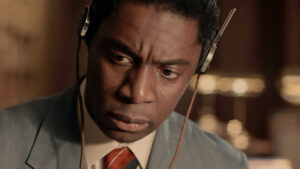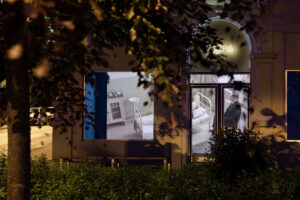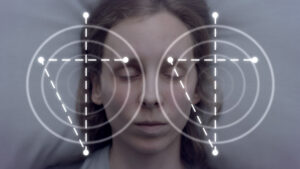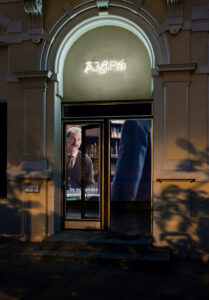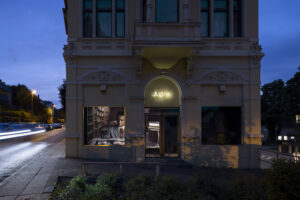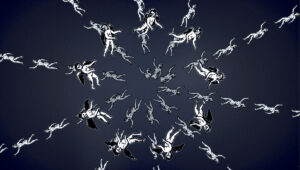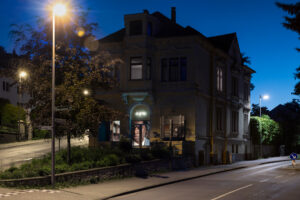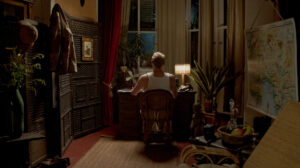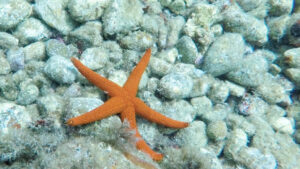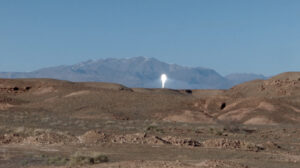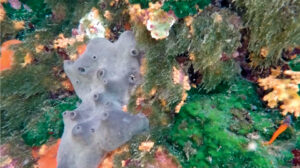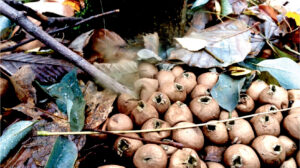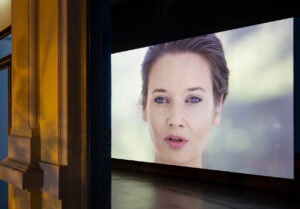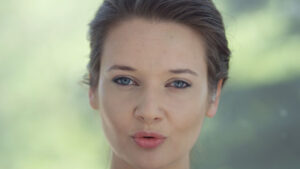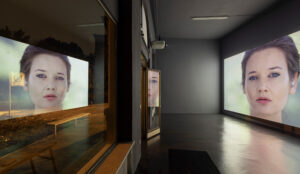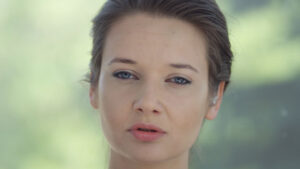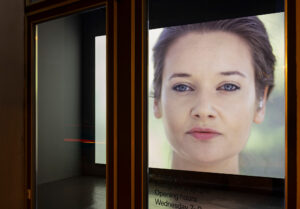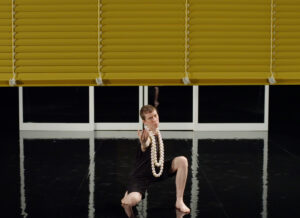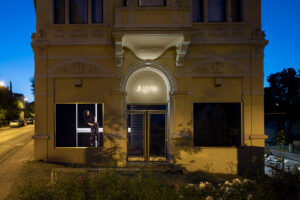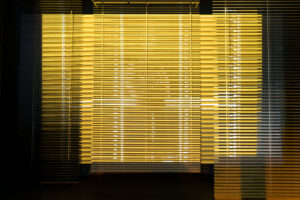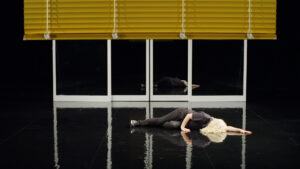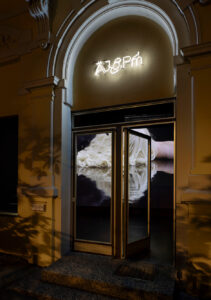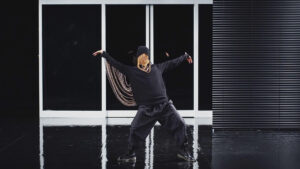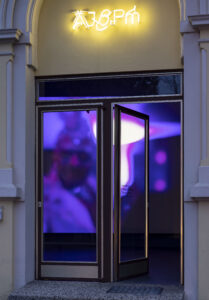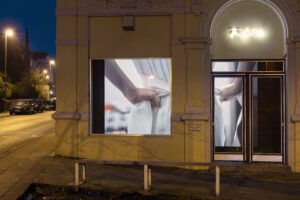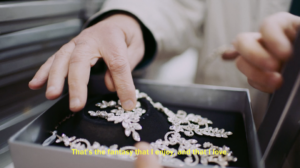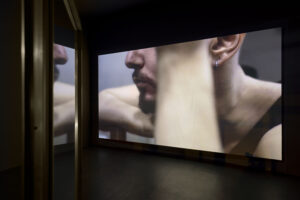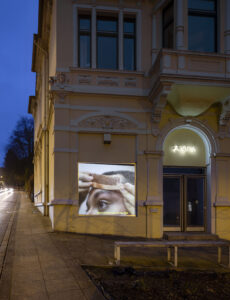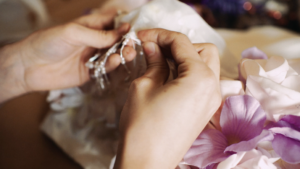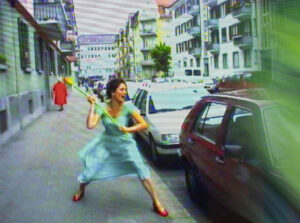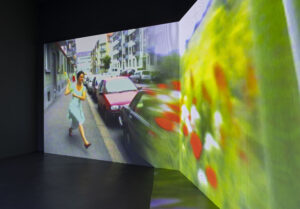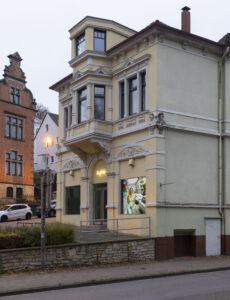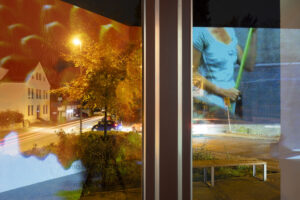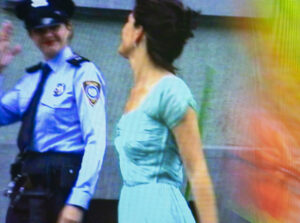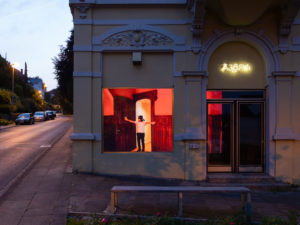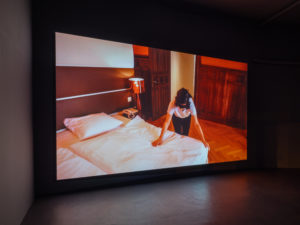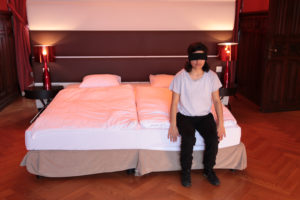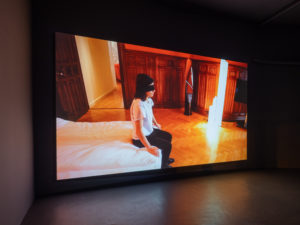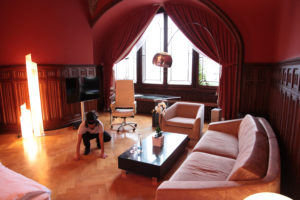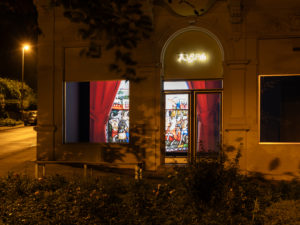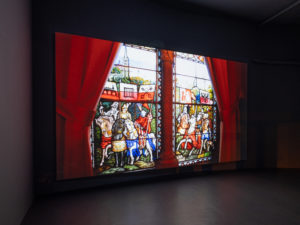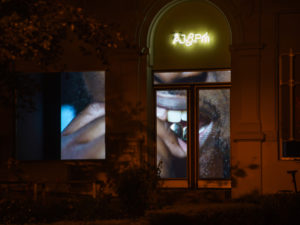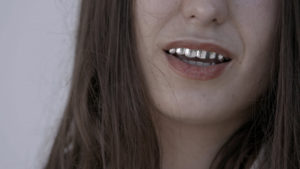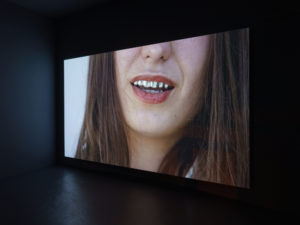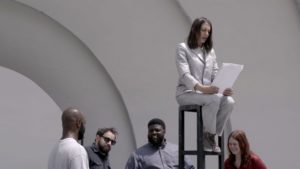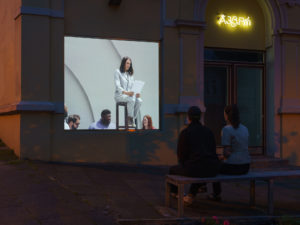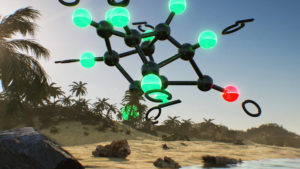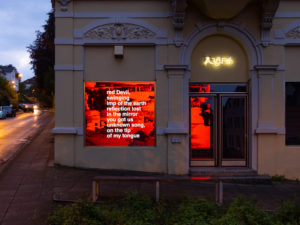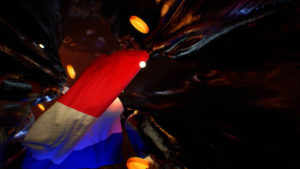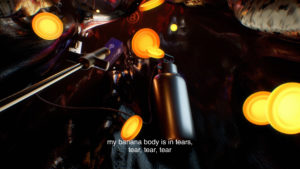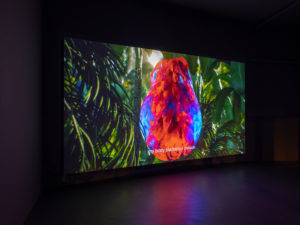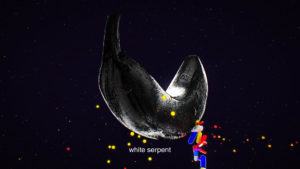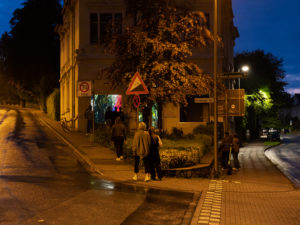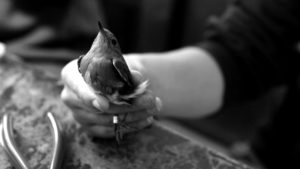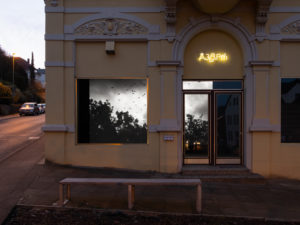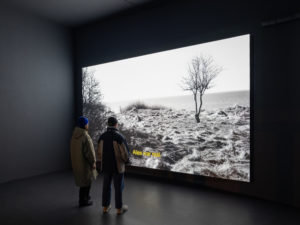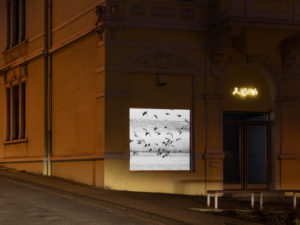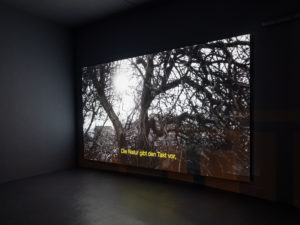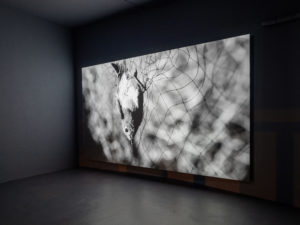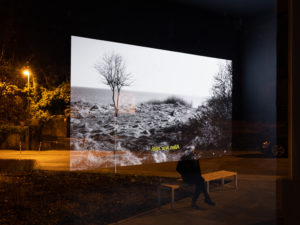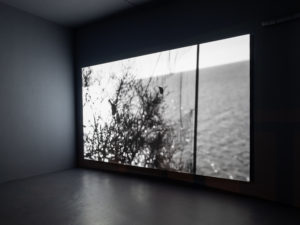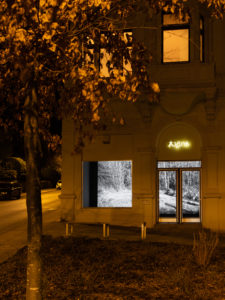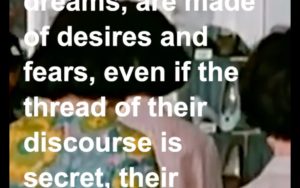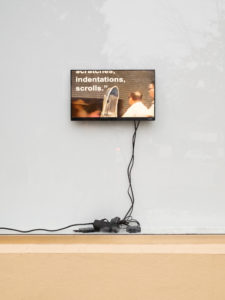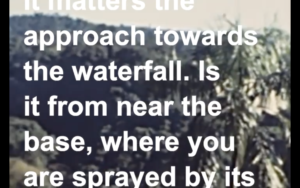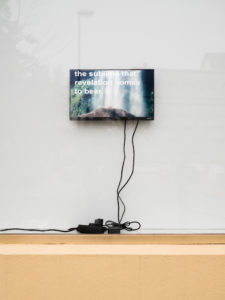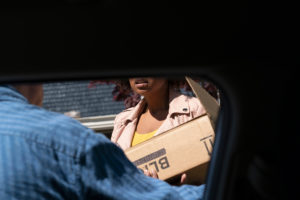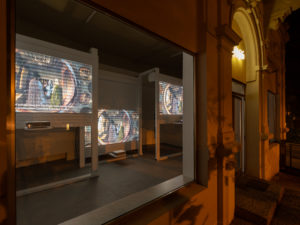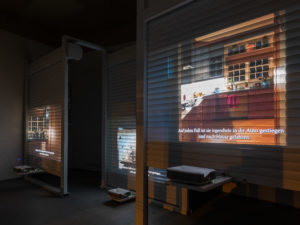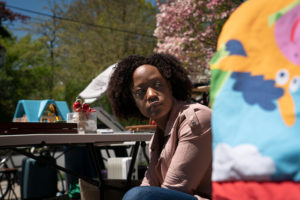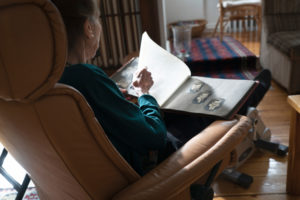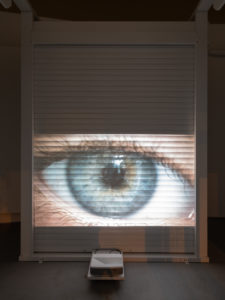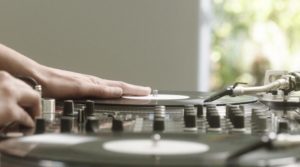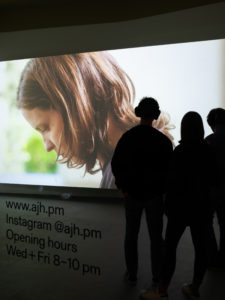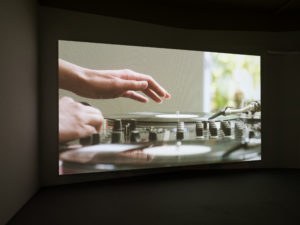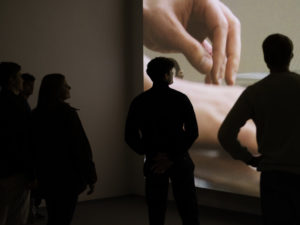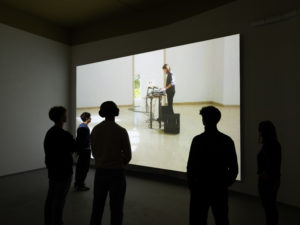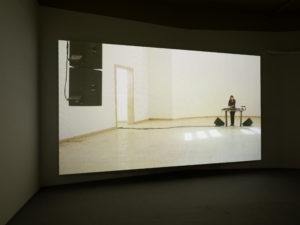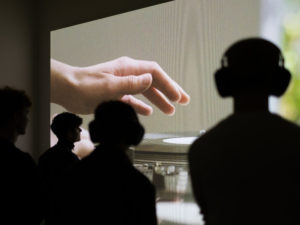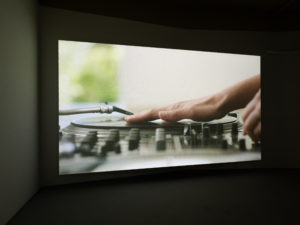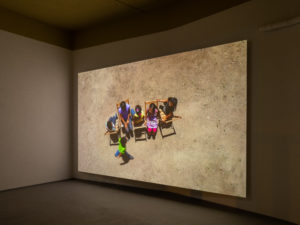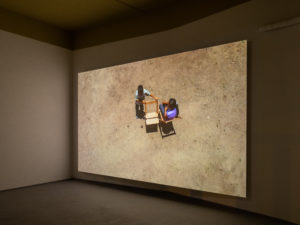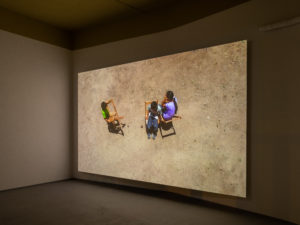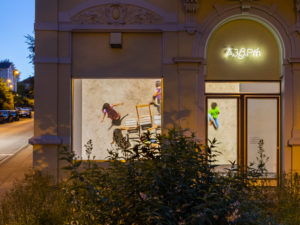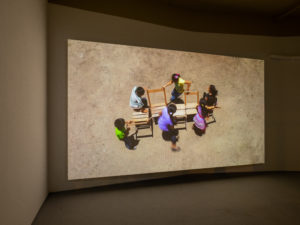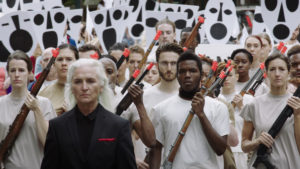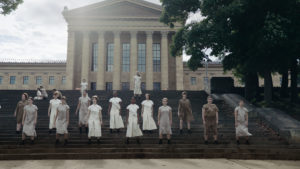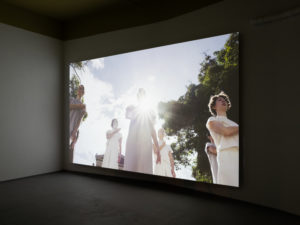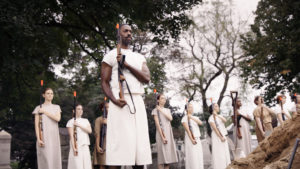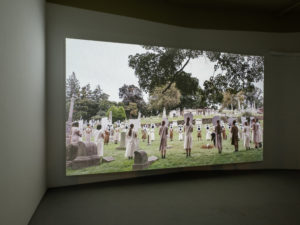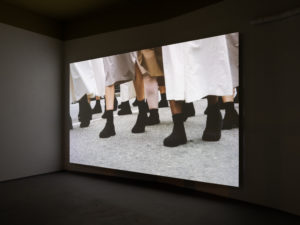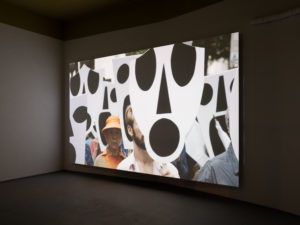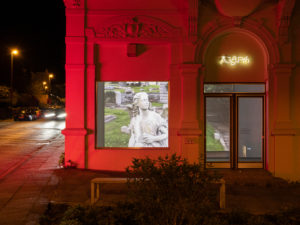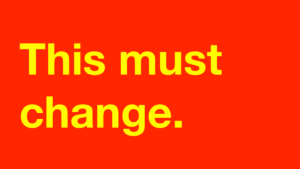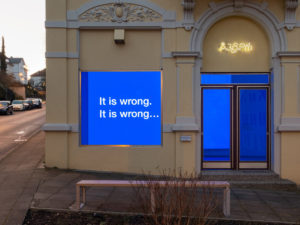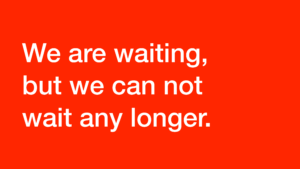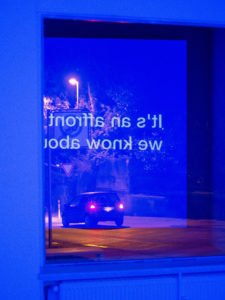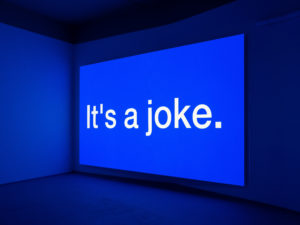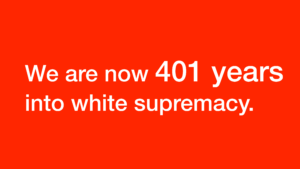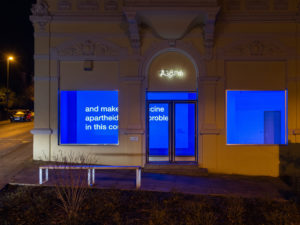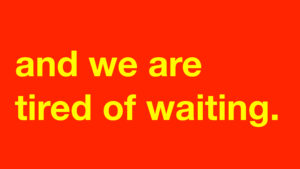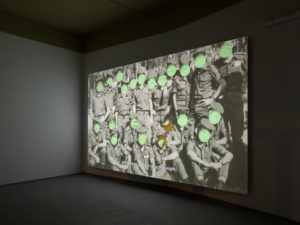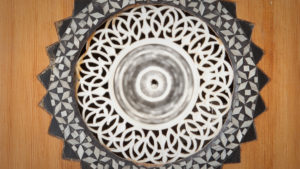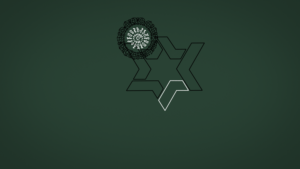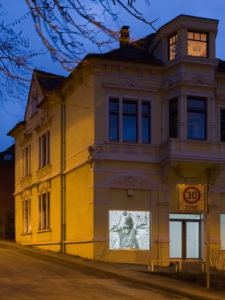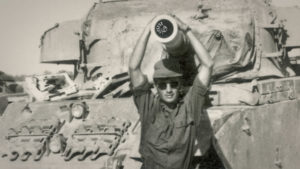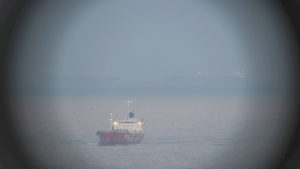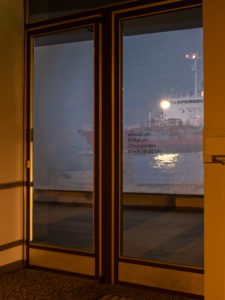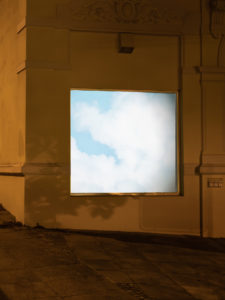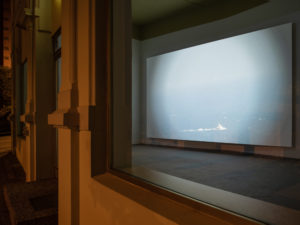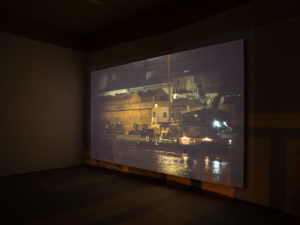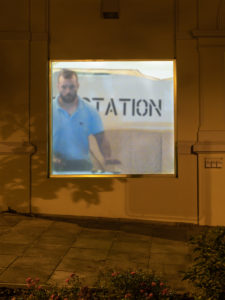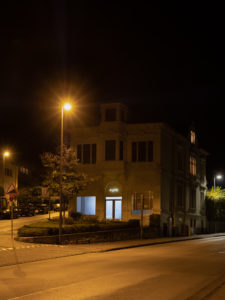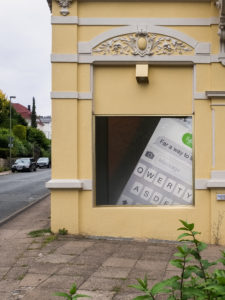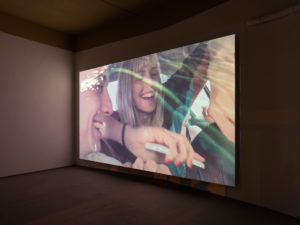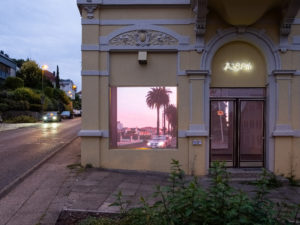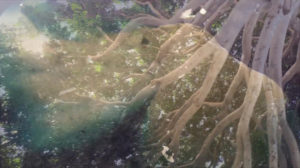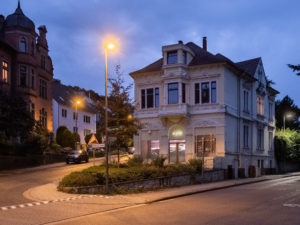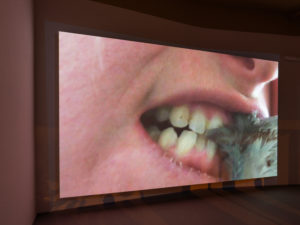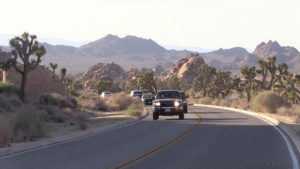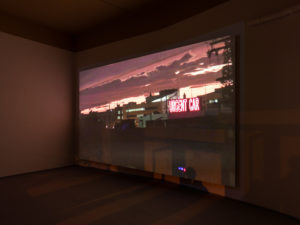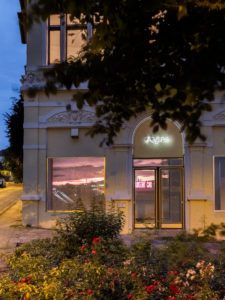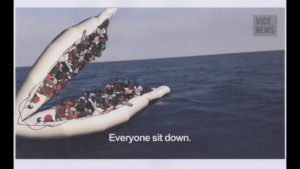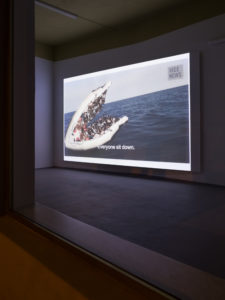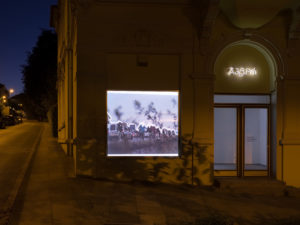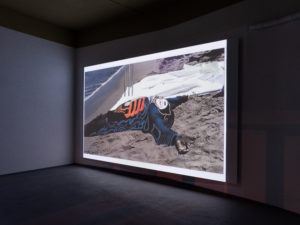22.25 Dani Gal Dark Continent
More
“The Saint-Yile tapes,” the librarian mumbles in astonishment, rummaging to procure the note about the request from his file. He disappears into the back—not without remarking that these materials are usually kept under lock and key—only to return with a tape recorder and several tapes in hand.
The story that unfolds in the 2023 film Dark Continent—after Fanon threads the tape, puts on the headphones, and presses play—is a slightly dramatized adaptation by Dani Gal, drawn directly from Black Skin, White Masks, the book that brought the Martinique-born psychiatrist, writer, and activist to prominence in 1952 and established him as a sharp, articulate thinker and early theorist of decolonization. The case study it presents centers on a young white French woman who suffers from strange physical tics—twitching eyes and rocking-chair-like movements with her feet. She also experiences abstract hallucinations of circles and reports hearing “African” tom-tom music. The attending physician eventually prescribes a form of lucid dream therapy—with success: the circles are broken up, crossed out, and disappear; polyrhythmic drumming gives way to the clear, three-beat rhythm of a waltz.
On several intricately interwoven diegetic levels, Dani Gal tells the story of a haunting and its healing—one that (re)establishes a European sense of order through the questionable means of erasure and overwriting. These levels are both held together and fractured by sound, its (technical) transmission and visual symbolism. The film adopts the structure of concentric circles expanding outward, reflecting both the central narrative force and the graphic visualization of the young woman’s hallucinations at the heart of the story. In dramatizing the material, the boundary between cinematic fiction and real events becomes porous: We see an actual and authentic case, albeit stylized through cinematic techniques, framed within a fictional narrative in which the real Frantz Fanon conducts imaginary research on the very story being told. Similarly, the sharply defined boundaries between roles are blurred through the figure of the young, white, European woman—who is passive and inevitably objectified. At one point, the treating doctor quotes Sigmund Freud’s assertion that women remain a “dark continent,” complicating the clear-cut categories of perpetrator and victim.
This back and forth, this ping-ponging between levels and positions, is framed by a prologue and an epilogue that give the film—structured like a resonating chamber—a fourth, outermost layer and enclose it parenthetically in terms of technology and media theory. Before the fictional Fanon enters the library, the camera shows us the librarian’s stamps through the (likewise circular) lens of a magnifying glass. Depicted there are radios, tape recorders, loudspeakers, and transmission masts with concentric circles radiating outward from the top, symbolizing radio waves and transmissions—images of sound presented in the form of stamps, which in turn represent another form of communication.
Fittingly, the portable radio in the prologue is heard playing the very same waltz (The Snow Star) that Fanon mentions in Black Skin, White Masks, identical to what the patient later learns to use to drown out the sound of the drums. In addition, Gal introduces the voice of the narrator, who recounts an article published in 1928 by Nana Amoah III, King of the Gold Coast (as the area now known as Ghana was known under British colonial rule). In the article, he discusses how long before the advent of radio, Africa had developed a highly advanced and sophisticated communication system: the drum, which allowed the transmission of complex, rhythmically coded messages over long distances. It’s not surprising, then, that colonial powers and enslavers were quick to ban them, fearing that they could be used to spread revolutionary and seditious messages. In the epilogue, the portable radio plays a central role in unraveling the story behind the patient’s mental illness. Her father, played by the same actor as the racist librarian, had served in the French colonial armies in Africa. Night after night he listened to “African” drum music on his radio, the rhythms of which carried through the darkness to his daughter’s ears. In Gal’s film, the radio plays not the waltz, but the distinctly percussive, echoing music of contemporary composer and musician Tyshawn Sorey.
In Dark Continent, the collective history of colonial violence and oppression emerges as a historical condition underlying individual psychological trauma and is conveyed above all through sound. In this film, sound has the power to cut through the image, its fluid, unfixed nature opening up new spaces. It unsettles the rigid, carries the past into the present as something “present-absent,” and creates feedback loops between now and then—so that the repressed returns within the repressor and one medium within another, the drum within the radio, sound within the image. From an empty center, echoes ripple through Dani Gal’s film, spanning generations, eras, and continents. Waves overlap, first canceling each other out through interference, then amplifying one another. History emerges as a contested, structured field of resonance shaped by power, violence, and oppression—the reverberating spaces of which are haunted by ghosts that drift back and forth, sometimes even passing through the very walls that divide not only these spaces, but also those of us who inhabit them.
Dani Gal studied at the Bezalel Academy of Arts and Design in Jerusalem, the Städelschule in Frankfurt am Main, and the Cooper Union in New York. His films and works have been featured in numerous exhibitions, including documenta 14 in Kassel and Athens (2017), the Centre Pompidou in Paris (2018 and 2023), steirischer herbst in Graz (2023), and The Polygon Gallery in Vancouver (2024). In 2019, Gal was Artist-in-Residence at Blood Mountain Projects and a research fellow at the Vienna Wiesenthal Institute for Holocaust Studies. In 2024, he was a fellow at inherit, Centre for Advanced Studies at Humboldt University in Berlin. Dani Gal lives and works in Berlin.
Close
The story that unfolds in the 2023 film Dark Continent—after Fanon threads the tape, puts on the headphones, and presses play—is a slightly dramatized adaptation by Dani Gal, drawn directly from Black Skin, White Masks, the book that brought the Martinique-born psychiatrist, writer, and activist to prominence in 1952 and established him as a sharp, articulate thinker and early theorist of decolonization. The case study it presents centers on a young white French woman who suffers from strange physical tics—twitching eyes and rocking-chair-like movements with her feet. She also experiences abstract hallucinations of circles and reports hearing “African” tom-tom music. The attending physician eventually prescribes a form of lucid dream therapy—with success: the circles are broken up, crossed out, and disappear; polyrhythmic drumming gives way to the clear, three-beat rhythm of a waltz.
On several intricately interwoven diegetic levels, Dani Gal tells the story of a haunting and its healing—one that (re)establishes a European sense of order through the questionable means of erasure and overwriting. These levels are both held together and fractured by sound, its (technical) transmission and visual symbolism. The film adopts the structure of concentric circles expanding outward, reflecting both the central narrative force and the graphic visualization of the young woman’s hallucinations at the heart of the story. In dramatizing the material, the boundary between cinematic fiction and real events becomes porous: We see an actual and authentic case, albeit stylized through cinematic techniques, framed within a fictional narrative in which the real Frantz Fanon conducts imaginary research on the very story being told. Similarly, the sharply defined boundaries between roles are blurred through the figure of the young, white, European woman—who is passive and inevitably objectified. At one point, the treating doctor quotes Sigmund Freud’s assertion that women remain a “dark continent,” complicating the clear-cut categories of perpetrator and victim.
This back and forth, this ping-ponging between levels and positions, is framed by a prologue and an epilogue that give the film—structured like a resonating chamber—a fourth, outermost layer and enclose it parenthetically in terms of technology and media theory. Before the fictional Fanon enters the library, the camera shows us the librarian’s stamps through the (likewise circular) lens of a magnifying glass. Depicted there are radios, tape recorders, loudspeakers, and transmission masts with concentric circles radiating outward from the top, symbolizing radio waves and transmissions—images of sound presented in the form of stamps, which in turn represent another form of communication.
Fittingly, the portable radio in the prologue is heard playing the very same waltz (The Snow Star) that Fanon mentions in Black Skin, White Masks, identical to what the patient later learns to use to drown out the sound of the drums. In addition, Gal introduces the voice of the narrator, who recounts an article published in 1928 by Nana Amoah III, King of the Gold Coast (as the area now known as Ghana was known under British colonial rule). In the article, he discusses how long before the advent of radio, Africa had developed a highly advanced and sophisticated communication system: the drum, which allowed the transmission of complex, rhythmically coded messages over long distances. It’s not surprising, then, that colonial powers and enslavers were quick to ban them, fearing that they could be used to spread revolutionary and seditious messages. In the epilogue, the portable radio plays a central role in unraveling the story behind the patient’s mental illness. Her father, played by the same actor as the racist librarian, had served in the French colonial armies in Africa. Night after night he listened to “African” drum music on his radio, the rhythms of which carried through the darkness to his daughter’s ears. In Gal’s film, the radio plays not the waltz, but the distinctly percussive, echoing music of contemporary composer and musician Tyshawn Sorey.
In Dark Continent, the collective history of colonial violence and oppression emerges as a historical condition underlying individual psychological trauma and is conveyed above all through sound. In this film, sound has the power to cut through the image, its fluid, unfixed nature opening up new spaces. It unsettles the rigid, carries the past into the present as something “present-absent,” and creates feedback loops between now and then—so that the repressed returns within the repressor and one medium within another, the drum within the radio, sound within the image. From an empty center, echoes ripple through Dani Gal’s film, spanning generations, eras, and continents. Waves overlap, first canceling each other out through interference, then amplifying one another. History emerges as a contested, structured field of resonance shaped by power, violence, and oppression—the reverberating spaces of which are haunted by ghosts that drift back and forth, sometimes even passing through the very walls that divide not only these spaces, but also those of us who inhabit them.
Dani Gal studied at the Bezalel Academy of Arts and Design in Jerusalem, the Städelschule in Frankfurt am Main, and the Cooper Union in New York. His films and works have been featured in numerous exhibitions, including documenta 14 in Kassel and Athens (2017), the Centre Pompidou in Paris (2018 and 2023), steirischer herbst in Graz (2023), and The Polygon Gallery in Vancouver (2024). In 2019, Gal was Artist-in-Residence at Blood Mountain Projects and a research fellow at the Vienna Wiesenthal Institute for Holocaust Studies. In 2024, he was a fellow at inherit, Centre for Advanced Studies at Humboldt University in Berlin. Dani Gal lives and works in Berlin.
Text Dominikus Müller
Dark Continent, 2023
Video, 4K, 25 min.
Written and directed by Dani Gal
Starring Yoli Fuller, Maj-Britt Klenke, J. David Hinze, and Patrick Joswig
Cinematography Itay Marom
Produced by Kirberg Motors and Dani Gal
Courtesy of the artists and Kadel Willborn, Düsseldorf
21.25 Maya Schweizer L’étoile de mer
More
One after another, they are rendered into language—in clear, plainspoken words tinged with quiet dismay at the relentless, palpable passage of time in these pictures: both private snapshots and widely circulated media photographs, images seared into the collective memory (or at least the narrator’s memory), in which history condenses into personal (life) time, socially lived. They are images from the second half of the 20th century; images that will soon cease to exist, not least because they will be without meaning once there is no one left to imbue them with it.
Ernaux’s line about the disappearance of all images is also found in L’Étoile de mer, a 2019 film by Maya Schweizer. But before that happens, the film plunges into the sea, into the Mediterranean near the small town of La Ciotat, close to Marseille, to be more precise. It begins underwater, floating amid fish in a vast array of colors and patterns. Despite glimpses of stones gently cloaked in green, it’s not entirely clear which way is up and which way is down. There is a weightlessness that leaves direction open. But quickly, in harsh, abrupt cuts, other images come into view—glowing animal eyes in the night, a hand holding a fossil to the camera, huge castoff turbines. Artificial and human-made, the latter take on the radial shape of the starfish whose name the film shares with a 1928 film by Man Ray.
The title is not the only direct reference to the foregone 20th century, its avant-gardes, and its guiding medium, cinema. Like fragments of memory, individual images, certain sentences, or sequences seem to emerge from the waters of the Mediterranean: the famous train filmed by the Lumière brothers in 1895/96 as it enters the station of that same town of La Ciotat in southern France—one of cinema’s primal scenes. Or various intertitles and images from Alain Resnais’s Last Year at Marienbad (1961), a landmark film of European postwar cinema. “Do you remember?” asks a male voice from that film’s soundtrack, again and again, over images of the night, only to soon answer itself: “You have already forgotten everything.”
For nearly two decades, Schweizer has been exploring history, the passing of time, and the complex structure of memory in predominantly cinematic works. The quiet and moving piece Manou, La Seyne sur Mer (2011) finds the artist focusing on the life of her own grandmother in a nursing home and the latter’s increasingly fragmented perception of the world. In A Memorial, a Synagogue, a Bridge and a Church (2012), she explores, through long takes and a searching gaze, the monument to the demolished synagogue in Bratislava and its immediate urban surroundings, making palpable the simultaneity of different layers of time in one place. Her two-channel projection Regarde par ici, … Und dort die Puschkinallee (2018), centers on an old watchtower on the border between the former East and West Berlin. On the whole (though not always), these films follow a logic of site, more specifically, of a “site of memory,” a concept developed by the French historian Pierre Nora in the 1980s: place, symbolically charged with the past, becomes a fixed anchor in the unrelenting passage of time.
L’Étoile de mer is a film that contrasts the fixed (and fixing) site with the sea in all its fluidity, its inescapable, perpetual changeability and permeability—understanding water, its image, as a metaphor for forgetting. This oblivion is just as much a prerequisite for our relationship to time and the past as its counterpart, to memory, even if the latter is more readily linked to the concept of history and access to what came before. One could, to draw on cinematic terms, also put it like this: in the usual conception of history, forgetting is in a way the “hors-champ,” that which lies beyond the image itself: undefined and without fixed contours, an invisible yet nonetheless constitutive behind and around, against which the remembered appears as a defined and determined image. Memory: a piece of land to which one clings; forgetting: the water that sweeps one away—elusive, unplaceable, infinite, and never the same. Where the waves of forgetting seem inexorable, memory appears as an active resistance.
Water has been associated with forgetting since ancient times: in Greek mythology, the dead drink from the waters of the River Lethe on their journey to the underworld, erasing all memories. “In its soft flowing the hard contours of the remembrance of reality are dissolved,” they are literally “liquidated,” as the literary scholar Harald Weinrich puts it. Only then are the souls ready for a new, eternal life in the afterlife. It is forgetting that allows for a fresh start.
In a sense, the same can be said of Schweizer’s work, where L’Étoile de mer and its initial dive into the Mediterranean mark the beginning of a new chapter. The location-bound, deep probing into the sediments of time finds itself paired with an artful, fluid, and lateral connection—a back-and-forth unfolding. The films that follow L’Étoile de mer—namely Voices and Shells (2020) and the aptly titled Sans histoire (2023)—carry forward and expand upon this engagement with water. But beyond the evolution of Schweizer’s own ouevre, L’Étoile de mer emerged at a broader turning point, where, amid the widespread reach of digital media, the ways we remember and forget—and our approaches to history and storytelling—are undergoing a profound shift.
This is particularly noticeable when comparing L’Étoile de mer with Sans histoire, the artist’s most recent film, which is explicitly concerned with ideas of the future. History, in the sense of something that can be told or even narrated, is much harder to discern here. Things seem to exist side by side, indistinguishable from one another; images detach themselves, seemingly contactless and uncoupled, to flow endlessly past. They are not without meaning, but perhaps without a single overarching one that would consolidate to shore them up. In other words, where the laterally connected, fluid narrative in L’Étoile de mer, with its tone and melancholic style, can still be interpreted as an emancipation from a more straightforward mode of narration—or, in topographical terms, as a departure from a fixed place—that gives it a specific contour, Sans histoire has moved away from such a framework, one that would provide contrast, form, and direction. In light of the images of the future that Sans histoire sketches—images that essentially depict a highly technologized digital present—the pictures in L’Étoile de mer appear even more like those of the past.
But, to return once again to Annie Ernaux’s opening line: Does this make all the images disappear? At the end of L’Étoile de mer, we see a starfish laboriously stretching and turning over. This is mirrored in the final sequence of Voices and Shells, where a snake sheds its skin. These are images of turning, of new beginnings, of metamorphosis and transformation. Yet, even when the starfish turns over, it looks nearly the same from above as it does from below. And even when the snake sheds its skin, nothing radically new or different emerges beneath the old skin—just simply a new one. Ultimately, it is not the images themselves that disappear. On the contrary, there are more images than ever, a veritable sea of them, a proverbial flood surging through digital channels. What does vanish—particularly in light of the fact that more and more images are made by machines, for machines—is a certain significance of those images, their meaning; it is history, in the sense of a time lived, experienced, and enlivened by humans. But even though the people of the long 20th century are gradually fading from the images, it doesn’t mean others won’t come to fill them again—newly and differently.
Maya Schweizer lives and works in Berlin. Her work has featured in solo exhibitions at Ortloff, Leipzig and Drawing Room, Hamburg (both 2024); the Jewish Museum Berlin (2023); Deutscher Künstlerbund e.V., Berlin (2023); Loop, Barcelona (2023); ASPN Leipzig (2022); Villa Stuck, Munich (2020); and al Spaziosiena, Siena, Italy (2019). She has also participated in group exhibitions including Dazugehören! Belonging! at Kunsthaus Dresden (2024); Nature. Sound. Memory at Kunsthaus Baselland, Switzerland (2023); the Basel Social Club (2023); Roma, a Portrait at Palazzo delle Esposizioni Museum, Rome (2023); Facing New Challenges at Heidelberger Kunstverein (2022); On the Quiet, Salzburger Kunstverein (2022), and Manifesta 13 in Marseille (2020), as well as Today’s Yesterday, 1.Anren, Biennale, China (2017), to name just a few examples from recent years. Her films have screened at festivals including the Forum Expanded section of the Berlinale International Film Festival in 2022 and 2017. The artist has received numerous awards and fellowships for her work, most recently the Günther Peill Foundation Prize, Düren (2024–26), the Dagesh Art Award (2023), and the HAP Grieshaber Prize awarded by VG Bild-Kunst (2022).
Ernaux’s line about the disappearance of all images is also found in L’Étoile de mer, a 2019 film by Maya Schweizer. But before that happens, the film plunges into the sea, into the Mediterranean near the small town of La Ciotat, close to Marseille, to be more precise. It begins underwater, floating amid fish in a vast array of colors and patterns. Despite glimpses of stones gently cloaked in green, it’s not entirely clear which way is up and which way is down. There is a weightlessness that leaves direction open. But quickly, in harsh, abrupt cuts, other images come into view—glowing animal eyes in the night, a hand holding a fossil to the camera, huge castoff turbines. Artificial and human-made, the latter take on the radial shape of the starfish whose name the film shares with a 1928 film by Man Ray.
The title is not the only direct reference to the foregone 20th century, its avant-gardes, and its guiding medium, cinema. Like fragments of memory, individual images, certain sentences, or sequences seem to emerge from the waters of the Mediterranean: the famous train filmed by the Lumière brothers in 1895/96 as it enters the station of that same town of La Ciotat in southern France—one of cinema’s primal scenes. Or various intertitles and images from Alain Resnais’s Last Year at Marienbad (1961), a landmark film of European postwar cinema. “Do you remember?” asks a male voice from that film’s soundtrack, again and again, over images of the night, only to soon answer itself: “You have already forgotten everything.”
For nearly two decades, Schweizer has been exploring history, the passing of time, and the complex structure of memory in predominantly cinematic works. The quiet and moving piece Manou, La Seyne sur Mer (2011) finds the artist focusing on the life of her own grandmother in a nursing home and the latter’s increasingly fragmented perception of the world. In A Memorial, a Synagogue, a Bridge and a Church (2012), she explores, through long takes and a searching gaze, the monument to the demolished synagogue in Bratislava and its immediate urban surroundings, making palpable the simultaneity of different layers of time in one place. Her two-channel projection Regarde par ici, … Und dort die Puschkinallee (2018), centers on an old watchtower on the border between the former East and West Berlin. On the whole (though not always), these films follow a logic of site, more specifically, of a “site of memory,” a concept developed by the French historian Pierre Nora in the 1980s: place, symbolically charged with the past, becomes a fixed anchor in the unrelenting passage of time.
L’Étoile de mer is a film that contrasts the fixed (and fixing) site with the sea in all its fluidity, its inescapable, perpetual changeability and permeability—understanding water, its image, as a metaphor for forgetting. This oblivion is just as much a prerequisite for our relationship to time and the past as its counterpart, to memory, even if the latter is more readily linked to the concept of history and access to what came before. One could, to draw on cinematic terms, also put it like this: in the usual conception of history, forgetting is in a way the “hors-champ,” that which lies beyond the image itself: undefined and without fixed contours, an invisible yet nonetheless constitutive behind and around, against which the remembered appears as a defined and determined image. Memory: a piece of land to which one clings; forgetting: the water that sweeps one away—elusive, unplaceable, infinite, and never the same. Where the waves of forgetting seem inexorable, memory appears as an active resistance.
Water has been associated with forgetting since ancient times: in Greek mythology, the dead drink from the waters of the River Lethe on their journey to the underworld, erasing all memories. “In its soft flowing the hard contours of the remembrance of reality are dissolved,” they are literally “liquidated,” as the literary scholar Harald Weinrich puts it. Only then are the souls ready for a new, eternal life in the afterlife. It is forgetting that allows for a fresh start.
In a sense, the same can be said of Schweizer’s work, where L’Étoile de mer and its initial dive into the Mediterranean mark the beginning of a new chapter. The location-bound, deep probing into the sediments of time finds itself paired with an artful, fluid, and lateral connection—a back-and-forth unfolding. The films that follow L’Étoile de mer—namely Voices and Shells (2020) and the aptly titled Sans histoire (2023)—carry forward and expand upon this engagement with water. But beyond the evolution of Schweizer’s own ouevre, L’Étoile de mer emerged at a broader turning point, where, amid the widespread reach of digital media, the ways we remember and forget—and our approaches to history and storytelling—are undergoing a profound shift.
This is particularly noticeable when comparing L’Étoile de mer with Sans histoire, the artist’s most recent film, which is explicitly concerned with ideas of the future. History, in the sense of something that can be told or even narrated, is much harder to discern here. Things seem to exist side by side, indistinguishable from one another; images detach themselves, seemingly contactless and uncoupled, to flow endlessly past. They are not without meaning, but perhaps without a single overarching one that would consolidate to shore them up. In other words, where the laterally connected, fluid narrative in L’Étoile de mer, with its tone and melancholic style, can still be interpreted as an emancipation from a more straightforward mode of narration—or, in topographical terms, as a departure from a fixed place—that gives it a specific contour, Sans histoire has moved away from such a framework, one that would provide contrast, form, and direction. In light of the images of the future that Sans histoire sketches—images that essentially depict a highly technologized digital present—the pictures in L’Étoile de mer appear even more like those of the past.
But, to return once again to Annie Ernaux’s opening line: Does this make all the images disappear? At the end of L’Étoile de mer, we see a starfish laboriously stretching and turning over. This is mirrored in the final sequence of Voices and Shells, where a snake sheds its skin. These are images of turning, of new beginnings, of metamorphosis and transformation. Yet, even when the starfish turns over, it looks nearly the same from above as it does from below. And even when the snake sheds its skin, nothing radically new or different emerges beneath the old skin—just simply a new one. Ultimately, it is not the images themselves that disappear. On the contrary, there are more images than ever, a veritable sea of them, a proverbial flood surging through digital channels. What does vanish—particularly in light of the fact that more and more images are made by machines, for machines—is a certain significance of those images, their meaning; it is history, in the sense of a time lived, experienced, and enlivened by humans. But even though the people of the long 20th century are gradually fading from the images, it doesn’t mean others won’t come to fill them again—newly and differently.
Maya Schweizer lives and works in Berlin. Her work has featured in solo exhibitions at Ortloff, Leipzig and Drawing Room, Hamburg (both 2024); the Jewish Museum Berlin (2023); Deutscher Künstlerbund e.V., Berlin (2023); Loop, Barcelona (2023); ASPN Leipzig (2022); Villa Stuck, Munich (2020); and al Spaziosiena, Siena, Italy (2019). She has also participated in group exhibitions including Dazugehören! Belonging! at Kunsthaus Dresden (2024); Nature. Sound. Memory at Kunsthaus Baselland, Switzerland (2023); the Basel Social Club (2023); Roma, a Portrait at Palazzo delle Esposizioni Museum, Rome (2023); Facing New Challenges at Heidelberger Kunstverein (2022); On the Quiet, Salzburger Kunstverein (2022), and Manifesta 13 in Marseille (2020), as well as Today’s Yesterday, 1.Anren, Biennale, China (2017), to name just a few examples from recent years. Her films have screened at festivals including the Forum Expanded section of the Berlinale International Film Festival in 2022 and 2017. The artist has received numerous awards and fellowships for her work, most recently the Günther Peill Foundation Prize, Düren (2024–26), the Dagesh Art Award (2023), and the HAP Grieshaber Prize awarded by VG Bild-Kunst (2022).
Text Dominikus Müller
Translation Amy Patton
L’étoile de mer, 2019
HD Video, Color, Sound
11:00 min.
Courtesy the artist and VG Bild-Kunst
Close
Translation Amy Patton
L’étoile de mer, 2019
HD Video, Color, Sound
11:00 min.
Courtesy the artist and VG Bild-Kunst
20.24 Katarina Zdjelar AAA ( Mein Herz )
More
Her work explores the aesthetic, performative, and political significance of the voice, viewing language as both a vehicle for personal identity formation and a tool for political empowerment in the tension between private and public spaces. Here the body acts as both a performative medium and a resonant space for voice, song, and music, as exemplified by the videos Stimme (Voice, 2013) and The Perfect Sound (2009).
Zdjelar’s approach incorporates rehearsal techniques along with varied forms of vocal and musical performance, bringing together elements of improvisation, productive failure, and reinterpretation. This method shines through in works like Untitled (A Song) (2016), My Lifetime (Malaika) (2012), and Shoum (2009). In more recent pieces, including the installation Not A Pillar Not A Pile (2017/2020), she engages with pacifist and proto-feminist practices, drawing inspiration from figures like Käthe Kollwitz and Dore Hoyer.
Zdjelar’s video AAA (Mein Herz) (2016) shows a close-up of a young woman’s face as she looks directly into the camera; she performs four different musical compositions at once in a single, uninterrupted shot. There are no smooth, medley-like transitions here: instead the performer abruptly shifts between passages, each of which retains its unique style, tempo, rhythm, and tonality. Her facial expressions jerk, twist, and calm as she moves unpredictably through the languages—German, English and Polish. The performer is attempting the impossible: her singing is both about bridging the gaps between the fragments and about the precise interpretation of pieces that differ greatly in style and language. This creates a challenging experience for the listener, who is forced to either put the fragments together themselves like a jigsaw puzzle or try to associate them with a specific song. Yet the effort is constantly thwarted: Zdjelar creates a strange, contradictory soundscape woven from silence, music, noise, and language. As Zdjelar herself explains: “Similar to changing radio stations in search for the right song, the most rewarding and challenging aspect of bringing these compositions together in a single performance was in composing and performing interruptions which are the binding force at the same time.”¹
The nuances and subtleties of Zdjelar’s engagement with the human voice are what make her works complex and multifaceted. As the curators of the Acts of Voicing group exhibition at the Württembergischer Kunstverein describe: “The voice is difficult to grasp. Unlike the eye or the ear, it cannot be localized. Instead, it occurs through the ephemeral interplay of several organs. It is always inside and outside the body at the same time and is as intangible as it is socially and politically weighty. It utters both cries and speech, sense and nonsense, noise and song. It is never an instrument of articulation alone but always dovetails with action, with performativity.”²
In the video works shown here, it is primarily the dissonance between the visual and sound elements and the handling of interruptions and pauses that challenge our usual perceptual patterns. AAA (Mein Herz) emphasizes the corporeality of the voice and the facial expressions of the performer. The performer’s countenance becomes, as Zdjelar puts it, a visual “battlefield,” where the conflicting emotions of the musical pieces appear briefly (for a fraction of a second) before vanishing quickly, leaving us unable to fully interpret or read them. On a sound level, Zdjelar works with the principle of collage, fragmenting four musical pieces and recombining them into a new song. The result is a poetic cacophony that defies our Western listening habits, building a new narrative through deliberate accents. The original songs and their messages fade into the background; instead, the interruptions and pauses create (semantic) gaps that we are invited to fill with our own subjective associations.
Katarina Zdjelar’s video masterfully captures the fascination of the human voice and the diversity of music as a cultural medium. Placing performers in surprising settings and situations, she observes the expressiveness of the voice and its power with reduced cinematic means, much as a scientific experiment might. She choreographs her scenes carefully, blurring the line between process and outcome. Through the deconstruction of the music pieces, minimalist film techniques, and a focus on the performativity of the voice, she creates a poetic projection space that disrupts familiar patterns of perception and highlights the universality of cultural productivity. Her practice opens temporary and semantic discrepancies, opening spaces between expectation and surprise, choreography and improvisation. The result is temporal gaps and thematic depths that reveal themselves only upon closer inspection.
Katarina Zdjelar grew up in Belgrade; she lives and works between Belgrade and Rotterdam. She holds an MA in Visual Arts from the Piet Zwart Institute in Rotterdam and a degree from the University of Arts in Belgrade. She was also a two-year resident at the Rijksakademie van Beeldende Kunsten in Amsterdam. In 2019, Katarina Zdjelar represented Serbia, alongside Zoran Todorovic, at the 53rd Venice Biennale. Recent solo exhibitions include those at the gallery SpazioA in Pistoia (2023); the Cultural Centre of Belgrade (2023); MSU in Zagreb (2022); the MMC KIBLA/KiBela in Maribor (2021); Oregon Contemporary in Portland (2021); Casino Luxembourg (2018); Salzburger Kunstverein (2018); Akademie der Künste der Welt in Cologne (2016); and Kunstverein Bielefeld (2014). Her work has featured in numerous group exhibitions, including those at the Wildwuchs Festival at Kaserne Basel (2023); Garage Rotterdam (2022); Museum of African Art in Belgrade (2022); Kunsthal Extra City in Antwerp (2021); Kunstraum Niederoesterreich in Vienna (2021); Bonnefantenmuseum Maastricht (2020); the 11th Berlin Biennale (2020); HMKV in Dortmund (2020); Museion in Bolzano (2019); and Muzeum Sztuki in Łódź (2019). She is a recent recipient of the 24th Zagreb Salon’s MMSU Award (2019), the Dolf Henkes Prijs (2017), and was twice shortlisted for the Dutch Prix de Rome Award (2017, 2010).
Zdjelar’s approach incorporates rehearsal techniques along with varied forms of vocal and musical performance, bringing together elements of improvisation, productive failure, and reinterpretation. This method shines through in works like Untitled (A Song) (2016), My Lifetime (Malaika) (2012), and Shoum (2009). In more recent pieces, including the installation Not A Pillar Not A Pile (2017/2020), she engages with pacifist and proto-feminist practices, drawing inspiration from figures like Käthe Kollwitz and Dore Hoyer.
Zdjelar’s video AAA (Mein Herz) (2016) shows a close-up of a young woman’s face as she looks directly into the camera; she performs four different musical compositions at once in a single, uninterrupted shot. There are no smooth, medley-like transitions here: instead the performer abruptly shifts between passages, each of which retains its unique style, tempo, rhythm, and tonality. Her facial expressions jerk, twist, and calm as she moves unpredictably through the languages—German, English and Polish. The performer is attempting the impossible: her singing is both about bridging the gaps between the fragments and about the precise interpretation of pieces that differ greatly in style and language. This creates a challenging experience for the listener, who is forced to either put the fragments together themselves like a jigsaw puzzle or try to associate them with a specific song. Yet the effort is constantly thwarted: Zdjelar creates a strange, contradictory soundscape woven from silence, music, noise, and language. As Zdjelar herself explains: “Similar to changing radio stations in search for the right song, the most rewarding and challenging aspect of bringing these compositions together in a single performance was in composing and performing interruptions which are the binding force at the same time.”¹
The nuances and subtleties of Zdjelar’s engagement with the human voice are what make her works complex and multifaceted. As the curators of the Acts of Voicing group exhibition at the Württembergischer Kunstverein describe: “The voice is difficult to grasp. Unlike the eye or the ear, it cannot be localized. Instead, it occurs through the ephemeral interplay of several organs. It is always inside and outside the body at the same time and is as intangible as it is socially and politically weighty. It utters both cries and speech, sense and nonsense, noise and song. It is never an instrument of articulation alone but always dovetails with action, with performativity.”²
In the video works shown here, it is primarily the dissonance between the visual and sound elements and the handling of interruptions and pauses that challenge our usual perceptual patterns. AAA (Mein Herz) emphasizes the corporeality of the voice and the facial expressions of the performer. The performer’s countenance becomes, as Zdjelar puts it, a visual “battlefield,” where the conflicting emotions of the musical pieces appear briefly (for a fraction of a second) before vanishing quickly, leaving us unable to fully interpret or read them. On a sound level, Zdjelar works with the principle of collage, fragmenting four musical pieces and recombining them into a new song. The result is a poetic cacophony that defies our Western listening habits, building a new narrative through deliberate accents. The original songs and their messages fade into the background; instead, the interruptions and pauses create (semantic) gaps that we are invited to fill with our own subjective associations.
Katarina Zdjelar’s video masterfully captures the fascination of the human voice and the diversity of music as a cultural medium. Placing performers in surprising settings and situations, she observes the expressiveness of the voice and its power with reduced cinematic means, much as a scientific experiment might. She choreographs her scenes carefully, blurring the line between process and outcome. Through the deconstruction of the music pieces, minimalist film techniques, and a focus on the performativity of the voice, she creates a poetic projection space that disrupts familiar patterns of perception and highlights the universality of cultural productivity. Her practice opens temporary and semantic discrepancies, opening spaces between expectation and surprise, choreography and improvisation. The result is temporal gaps and thematic depths that reveal themselves only upon closer inspection.
Katarina Zdjelar grew up in Belgrade; she lives and works between Belgrade and Rotterdam. She holds an MA in Visual Arts from the Piet Zwart Institute in Rotterdam and a degree from the University of Arts in Belgrade. She was also a two-year resident at the Rijksakademie van Beeldende Kunsten in Amsterdam. In 2019, Katarina Zdjelar represented Serbia, alongside Zoran Todorovic, at the 53rd Venice Biennale. Recent solo exhibitions include those at the gallery SpazioA in Pistoia (2023); the Cultural Centre of Belgrade (2023); MSU in Zagreb (2022); the MMC KIBLA/KiBela in Maribor (2021); Oregon Contemporary in Portland (2021); Casino Luxembourg (2018); Salzburger Kunstverein (2018); Akademie der Künste der Welt in Cologne (2016); and Kunstverein Bielefeld (2014). Her work has featured in numerous group exhibitions, including those at the Wildwuchs Festival at Kaserne Basel (2023); Garage Rotterdam (2022); Museum of African Art in Belgrade (2022); Kunsthal Extra City in Antwerp (2021); Kunstraum Niederoesterreich in Vienna (2021); Bonnefantenmuseum Maastricht (2020); the 11th Berlin Biennale (2020); HMKV in Dortmund (2020); Museion in Bolzano (2019); and Muzeum Sztuki in Łódź (2019). She is a recent recipient of the 24th Zagreb Salon’s MMSU Award (2019), the Dolf Henkes Prijs (2017), and was twice shortlisted for the Dutch Prix de Rome Award (2017, 2010).
www.katarinazdjelar.net
Text Cynthia Krell
Translation Amy Patton
AAA (Mein Herz), 2016
Video, color, sound
4:30 min.
Courtesy of the artist and SpazioA, Pistoia.
¹ From e-mail correspondence with the artist on November 2, 2024.
² Exhib. cat. Stuttgart. Acts of Voicing, ed. Christ, Hans D., Dressler, Iris, Peters, Christine, Württembergischer Kunstverein Stuttgart, Leipzig 2014, p. 15.
Close
Text Cynthia Krell
Translation Amy Patton
AAA (Mein Herz), 2016
Video, color, sound
4:30 min.
Courtesy of the artist and SpazioA, Pistoia.
¹ From e-mail correspondence with the artist on November 2, 2024.
² Exhib. cat. Stuttgart. Acts of Voicing, ed. Christ, Hans D., Dressler, Iris, Peters, Christine, Württembergischer Kunstverein Stuttgart, Leipzig 2014, p. 15.
19.24 Pauline Boudry & Renate Lorenz (No) Time
More
The dancers incorporate a range of movement patterns: extreme slowness, rhythmic changes, stillness, breaks. Some movements in duet seem to run counter to each other in time. Individual dance sequences are occasionally technically altered, played backwards, slowed down, or sped up. The largely absent music foregrounds the moving bodies, making the dance styles—inspired by hip-hop, dancehall, (post-)modern dance, and drag performance—all the more distinguishable. Linking them together are sudden similarities, powerful movements and body memories that create or shift points of connection.
The artists use specific devices in their theatrical staging: particularly striking are the chains attached to the performers’ clothing, a recurring motif in Boudry and Lorenz’s work. (No) Time finds a number of silver chains attached to a sleeve, evoking both jewelry and weaponry. Or a cap embellished with a curtain of chains that obscures the dancer’s face. The chain prosthetics are actively used throughout the dance to enhance the range of limb movement, but also as a visual-acoustic element meant to draw the viewer’s attention. There are also deliberate references to both hip-hop culture and drag performances. Chains remain ambiguous in the context of the dance; in solo and duet performances, they are tied to both aggressive and defensive movements. Additional props, such as platform shoes, pointe shoes, and wigs, also come into play, their loaded symbolism turning them into active agents in their own right.
The black stage itself is fundamental to the scenario, functioning both literally and figuratively as a “black box.” The strategic use of an automatic glass sliding door creates visual separation and focus within the stage space, emphasizing the performers’ entrances and exits as a significant theatrical element. Adding to the effect is the shiny, reflective stage floor, which effectively doubles the performance and gives it a surreal, utopian quality. The yellow blinds in front of the projection move seemingly autonomously, intermittently obscuring the view of the dance performance to create visual voids and narrative interstices.
Historically, dance (or rather the music that accompanies it) has served as a powerful medium for empowering marginalized groups and artistically resisting existing social and power structures, often in subversive ways. Examples include capoeira, hip hop, dancehall, and drag performance. The artists link this cultural-historical dimension to the contemporary phenomenon of backlash—defined as a strong, negative reaction to progressive ideas, actions, or objects. Backlash refers to the normative so-called social majority’s resistance to and strong rejection of progressive marginalized groups that seek social change by challenging structural privilege and power dynamics. The recent video works Moving Backwards (2019) and Les Gayrillères (2022), along with (No) Time, form a trilogy in which backlashes serve as a catalyst for artistic exploration through dance and queer spaces of action and possibility. The latter were developed in collaboration with a team of choreographers and performers.
In the trilogy, the artists explore the phenomenon of liminal spaces—zones of transition between times, between social (dis)orders and conditions and states yet to be realized or achieved. The term liminality was first coined in the late 1960s by cultural anthropologist Victor Turner and has since been discussed in various fields of research, art theory among them. Turner uses it to describe the threshold state in which individuals or groups find themselves after a ritual separation from the dominant social order (e.g., the transition from childhood to adolescence to adulthood).
The concept of liminality is particularly relevant today. Current analyses of shifting political and socio-cultural landscapes can often be interpreted as direct descriptions of the phenomenon of liminality; societal upheavals and changes in individual status are accompanied by disruptions and challenges that can threaten or destabilize personal lives and social orders. It is in this context that unstable in-between spaces emerge outside familiar structures, affecting entire social groups across cultures.
In their practice, Boudry and Lorenz explore and theatrically enact the potential of transformative spaces and bodies in a state of suspension, examining social conditions from a minority perspective. The result is subversive artistic acts that create a threshold state between familiar sociocultural structures and a new, initially unknown environment and persona, or anticipate possible futures. This liminal state is not static but dynamic and fluctuating. It involves accepting and embracing the process, or understanding art as an experience of the liminal.
Pauline Boudry and Renate Lorenz are based in Berlin, where they have been working together since 2007. Their installations are characterized by a choreographic exploration of the tension between visibility and opacity. Their films capture performances in front of the camera and are often inspired by a song, an image, a film, or film scores from the recent past. Staging, layering, and reinventing characters and storylines over time becomes a means of challenging normative historical narratives and conventions of spectatorship. Performers include choreographers, artists, and musicians with whom the artists have engaged in discussions about the conditions of performance, the often violent history of (in)visibility, the pathologization of bodies, society, glamour, and resistance. The intentional defiance of conventional and traditional forms of representation serves to question these very forms.
Solo exhibitions and projects by the artists include those at Kunstnernes hus in Oslo (2023), Tensta konsthall in Stockholm (2023), Palacio de Cristal / Museo Nacional Centro de Arte Reina Sofía in Madrid (2022), CA2M Centro de Arte Dos de Mayo in Madrid (2022), Neue Berliner Kunstverein (2022), Kunstraum Innsbruck (2021), Frac Bretagne in Rennes (2021), the Swiss Pavilion at the 58th Venice Biennale (2019), Julia Stoschek Collection in Berlin (2019), Centre culturel suisse in Paris (2018), Contemporary Arts Museum in Houston (2017), Kunsthalle Zürich (2015), and Kunsthalle Wien (2015). Selected group exhibitions include the 35th São Paulo Biennial (2023), Centre Pompidou in Paris (2023), Kunstmuseum Magdeburg (2023), Kunstverein Braunschweig (2023), Whitechapel Gallery in London (2022), National Gallery of Victoria in Melbourne (2022), Van Abbemuseum in Eindhoven (2022), Sofia Art Projects in Sofia (2021), Mudam – Musée d’Art Moderne Grand-Duc Jean in Luxembourg (2021), and BAK, basis voor actuele kunst in Utrecht (2021).
The dancers incorporate a range of movement patterns: extreme slowness, rhythmic changes, stillness, breaks. Some movements in duet seem to run counter to each other in time. Individual dance sequences are occasionally technically altered, played backwards, slowed down, or sped up. The largely absent music foregrounds the moving bodies, making the dance styles—inspired by hip-hop, dancehall, (post-)modern dance, and drag performance—all the more distinguishable. Linking them together are sudden similarities, powerful movements and body memories that create or shift points of connection.
The artists use specific devices in their theatrical staging: particularly striking are the chains attached to the performers’ clothing, a recurring motif in Boudry and Lorenz’s work. (No) Time finds a number of silver chains attached to a sleeve, evoking both jewelry and weaponry. Or a cap embellished with a curtain of chains that obscures the dancer’s face. The chain prosthetics are actively used throughout the dance to enhance the range of limb movement, but also as a visual-acoustic element meant to draw the viewer’s attention. There are also deliberate references to both hip-hop culture and drag performances. Chains remain ambiguous in the context of the dance; in solo and duet performances, they are tied to both aggressive and defensive movements. Additional props, such as platform shoes, pointe shoes, and wigs, also come into play, their loaded symbolism turning them into active agents in their own right.
The black stage itself is fundamental to the scenario, functioning both literally and figuratively as a “black box.” The strategic use of an automatic glass sliding door creates visual separation and focus within the stage space, emphasizing the performers’ entrances and exits as a significant theatrical element. Adding to the effect is the shiny, reflective stage floor, which effectively doubles the performance and gives it a surreal, utopian quality. The yellow blinds in front of the projection move seemingly autonomously, intermittently obscuring the view of the dance performance to create visual voids and narrative interstices.
Historically, dance (or rather the music that accompanies it) has served as a powerful medium for empowering marginalized groups and artistically resisting existing social and power structures, often in subversive ways. Examples include capoeira, hip hop, dancehall, and drag performance. The artists link this cultural-historical dimension to the contemporary phenomenon of backlash—defined as a strong, negative reaction to progressive ideas, actions, or objects. Backlash refers to the normative so-called social majority’s resistance to and strong rejection of progressive marginalized groups that seek social change by challenging structural privilege and power dynamics. The recent video works Moving Backwards (2019) and Les Gayrillères (2022), along with (No) Time, form a trilogy in which backlashes serve as a catalyst for artistic exploration through dance and queer spaces of action and possibility. The latter were developed in collaboration with a team of choreographers and performers.
In the trilogy, the artists explore the phenomenon of liminal spaces—zones of transition between times, between social (dis)orders and conditions and states yet to be realized or achieved. The term liminality was first coined in the late 1960s by cultural anthropologist Victor Turner and has since been discussed in various fields of research, art theory among them. Turner uses it to describe the threshold state in which individuals or groups find themselves after a ritual separation from the dominant social order (e.g., the transition from childhood to adolescence to adulthood).
The concept of liminality is particularly relevant today. Current analyses of shifting political and socio-cultural landscapes can often be interpreted as direct descriptions of the phenomenon of liminality; societal upheavals and changes in individual status are accompanied by disruptions and challenges that can threaten or destabilize personal lives and social orders. It is in this context that unstable in-between spaces emerge outside familiar structures, affecting entire social groups across cultures.
In their practice, Boudry and Lorenz explore and theatrically enact the potential of transformative spaces and bodies in a state of suspension, examining social conditions from a minority perspective. The result is subversive artistic acts that create a threshold state between familiar sociocultural structures and a new, initially unknown environment and persona, or anticipate possible futures. This liminal state is not static but dynamic and fluctuating. It involves accepting and embracing the process, or understanding art as an experience of the liminal.
Pauline Boudry and Renate Lorenz are based in Berlin, where they have been working together since 2007. Their installations are characterized by a choreographic exploration of the tension between visibility and opacity. Their films capture performances in front of the camera and are often inspired by a song, an image, a film, or film scores from the recent past. Staging, layering, and reinventing characters and storylines over time becomes a means of challenging normative historical narratives and conventions of spectatorship. Performers include choreographers, artists, and musicians with whom the artists have engaged in discussions about the conditions of performance, the often violent history of (in)visibility, the pathologization of bodies, society, glamour, and resistance. The intentional defiance of conventional and traditional forms of representation serves to question these very forms.
Solo exhibitions and projects by the artists include those at Kunstnernes hus in Oslo (2023), Tensta konsthall in Stockholm (2023), Palacio de Cristal / Museo Nacional Centro de Arte Reina Sofía in Madrid (2022), CA2M Centro de Arte Dos de Mayo in Madrid (2022), Neue Berliner Kunstverein (2022), Kunstraum Innsbruck (2021), Frac Bretagne in Rennes (2021), the Swiss Pavilion at the 58th Venice Biennale (2019), Julia Stoschek Collection in Berlin (2019), Centre culturel suisse in Paris (2018), Contemporary Arts Museum in Houston (2017), Kunsthalle Zürich (2015), and Kunsthalle Wien (2015). Selected group exhibitions include the 35th São Paulo Biennial (2023), Centre Pompidou in Paris (2023), Kunstmuseum Magdeburg (2023), Kunstverein Braunschweig (2023), Whitechapel Gallery in London (2022), National Gallery of Victoria in Melbourne (2022), Van Abbemuseum in Eindhoven (2022), Sofia Art Projects in Sofia (2021), Mudam – Musée d’Art Moderne Grand-Duc Jean in Luxembourg (2021), and BAK, basis voor actuele kunst in Utrecht (2021).
www.boudry-lorenz.de
Text Cynthia Krell
Translation Amy Patton
(No) Time, 2020
Installation with HD, 3 blinds
Video, color, sound
20 min.
Choreography/performance Julie Cunningham, Werner Hirsch, Joy Alpuerto Ritter, Aaliyah Thanisha
Courtesy of the artists and Ellen de Bruijne Projects, Amsterdam.
Close
Text Cynthia Krell
Translation Amy Patton
(No) Time, 2020
Installation with HD, 3 blinds
Video, color, sound
20 min.
Choreography/performance Julie Cunningham, Werner Hirsch, Joy Alpuerto Ritter, Aaliyah Thanisha
Courtesy of the artists and Ellen de Bruijne Projects, Amsterdam.
18.24 Mohamad Abdouni ANYA KNEEZ: A Queen in Beirut
More
The result is an intimate, tender video portrait that captures and contrasts both day-to-day scenes and the preparations that go into transforming into a drag queen. The camera follows Anya as she sketches outfits, shops for jewelry and fabrics, applies makeup, tries on outfits, poses and performs. Amazingly, the extravagant drag queen costumes and accessories are created entirely within the confines of a tiny bedroom that doubles as both sleeping and sewing space; it is there that the trained fashion designer meticulously draws, designs, and stitches each piece with an abundance of love and attention to detail.
The main character casually shares her life story in a monologue, but not in a chronological or straightforward way; it feels more like one side of a conversation between friends. One quickly senses that the bond between Anya and the filmmaker is an intimate one, a friendship that allows these kinds of candid observations and expressions of trust to flow easily. Anya talks about her love of fashion, her studies in fashion design in New York, and her discovery of the performance art of drag. She associates the latter not only with self-liberation and the playful exploration of identities through fashion, but also with a powerful, exceptional emotional state: “I can’t really explain the emotion and the feeling that I get and the adrenaline rush, and the love for myself, and the insane amount of confidence when I put on a dress, or a jumpsuit, and paint my face and put on some boots, and walk out like I fucking own the world.” These shimmering emotions, this defiant self-confidence, come through in clip-like shots of Anya Kneez posing and dancing seductively in the light of a flickering strobe.
Anya’s fascination with drag goes hand in hand with her passion for all things sartorial, which she describes as follows: “I love clothes. That’s part of the reason why I went and got into this business and this industry. It’s because something about the idea of fashion, the idea that you can transform yourself and escape, even if just for a minute, the world that we live in through a piece of clothing.” The cultural practice of playfully navigating diverse genders and identities with fashion also finds parallels in contemporary self-staging on social media (filtered/unfiltered selfies), even extending to the art historical tradition of self-portraiture. The self-portrait becomes a space for projecting fantasies, making it particularly adept at articulating artistic self-perception and linking it back to the artist. With each act of self-staging, the portrayed self also becomes a cipher for collective longings, expectations, desires, or fears, as Cindy Sherman’s staged photographs convincingly show.
All these forms of self-presentation involve a playful exploration of gender identities on the one hand, and a negotiation of the (physical) desires of others on the other. The body is turned into a realm of potentiality, a narrative, a stage for expression through gestures, facial expressions, makeup, clothing, and accessories. It is the ambiguity, the fluidity that allows for imaginative exploration. It involves a preoccupation with an in-between bodily existence that is always present and yet constantly in need of redefinition as an experiential space and field of action. After all, within queer culture in particular, the body is simultaneously representation and a form of political activism—lived resistance to the normativization of bodies and subjectivity.
The positive memories, emotions, and freedoms Anya experienced during her formative years in the United States stand in stark contrast to her parents’ homophobic attitudes and the normative values of (Arab) society regarding masculinity. The result is an ongoing internal conflict that forces her to hide and deny aspects of her identity—to lead a double life. The video is presented from a deeply subjective point of view, focusing primarily on the biographical context, although her parents might also stand in for Lebanese society as a whole. Some of Anya’s words refer to both social and socio-political realities and the situation of the queer community in Lebanon. As such, this is a document in the sense of an oral history, one that allows contemporary witnesses to speak freely and openly. Anya recounts events, feelings, and aspects that she considers significant in her own voice, without interpretation or commentary by Mohamad Abdouni.
The documentary powerfully conveys a fundamental human desire: the need for every person to find a place in society, to feel accepted, to develop authentically so that their inner and outer selves are one—also beyond the confines of heteronormativity. In this light, the character of Anya Kneez emerges as a utopia in herself: a being from a gender-fluid future where individuals are free to express and be recognized for their true selves—a celebration of life’s full diversity.
Mohamad Abdouni (b. 1989, Lebanon) is an artist, photographer, filmmaker, and curator based between Beirut and Istanbul. He is also Editor in-Chief and Creative Director of COLD CUTS magazine, a photo journal exploring queer cultures in the SWANA (Southwest Asia/North Africa) region. His work has been exhibited in museums and galleries across the globe, including the Brooklyn Museum in New York (2017), FOAM Gallery in Amsterdam (2019), L’Institut du Monde Arabe and the Institut des Cultures d’Islam in Paris (2019), at Patel Brown in Toronto (2021), and the Lyon Biennale (2022). He is also the recipient of this year’s Lafayette Anticipations, awarded during his solo presentation at Paris+ par Art Basel with the gallery Marfa’ Projects. Mohamad Abdouni’s films have been screened at festivals including Eyes Wide Open Cinema (UK), the Leeds Queer Film Festival (UK), the International Queer & Migrant Film Festival in Amsterdam (NL), the Woodbury LGBTQ Film Festival in New Jersey (USA), and the Pink Apple Schwullesbisches Lesbian & Gay Film Festival in Zurich/Frauenfeld (CH). Commercially, he has shot for and directed films and music videos for well-known labels, brands and magazines including Gucci, Vogue US, Vogue Italy, Burberry, Puma, The New York Times, Slate, Fendi, Farfetch, GQ, King Kong, Dazed, AnOther, Nowness, Vice UK and L’officiel. His comprehensive research projects tend to focus on the untold stories of Beirut and uncovering the rich yet eradicated queer histories of the Arab-speaking region, specifically through documentaries and photo stories that have been featured in publications including A24, Telerama, Foam Magazine, Tetu, New Queer Photography, Kaleidoscope, i-D, Photoworks, and The Guardian. He has recently devoted himself to working on what is arguably the first archive of trans* histories in an Arab country, a project entitled Treat Me Like Your Mother: Trans* Histories From Beirut’s Forgotten Past. The collection is currently housed at the Arab Image Foundation in Beirut.
The result is an intimate, tender video portrait that captures and contrasts both day-to-day scenes and the preparations that go into transforming into a drag queen. The camera follows Anya as she sketches outfits, shops for jewelry and fabrics, applies makeup, tries on outfits, poses and performs. Amazingly, the extravagant drag queen costumes and accessories are created entirely within the confines of a tiny bedroom that doubles as both sleeping and sewing space; it is there that the trained fashion designer meticulously draws, designs, and stitches each piece with an abundance of love and attention to detail.
The main character casually shares her life story in a monologue, but not in a chronological or straightforward way; it feels more like one side of a conversation between friends. One quickly senses that the bond between Anya and the filmmaker is an intimate one, a friendship that allows these kinds of candid observations and expressions of trust to flow easily. Anya talks about her love of fashion, her studies in fashion design in New York, and her discovery of the performance art of drag. She associates the latter not only with self-liberation and the playful exploration of identities through fashion, but also with a powerful, exceptional emotional state: “I can’t really explain the emotion and the feeling that I get and the adrenaline rush, and the love for myself, and the insane amount of confidence when I put on a dress, or a jumpsuit, and paint my face and put on some boots, and walk out like I fucking own the world.” These shimmering emotions, this defiant self-confidence, come through in clip-like shots of Anya Kneez posing and dancing seductively in the light of a flickering strobe.
Anya’s fascination with drag goes hand in hand with her passion for all things sartorial, which she describes as follows: “I love clothes. That’s part of the reason why I went and got into this business and this industry. It’s because something about the idea of fashion, the idea that you can transform yourself and escape, even if just for a minute, the world that we live in through a piece of clothing.” The cultural practice of playfully navigating diverse genders and identities with fashion also finds parallels in contemporary self-staging on social media (filtered/unfiltered selfies), even extending to the art historical tradition of self-portraiture. The self-portrait becomes a space for projecting fantasies, making it particularly adept at articulating artistic self-perception and linking it back to the artist. With each act of self-staging, the portrayed self also becomes a cipher for collective longings, expectations, desires, or fears, as Cindy Sherman’s staged photographs convincingly show.
All these forms of self-presentation involve a playful exploration of gender identities on the one hand, and a negotiation of the (physical) desires of others on the other. The body is turned into a realm of potentiality, a narrative, a stage for expression through gestures, facial expressions, makeup, clothing, and accessories. It is the ambiguity, the fluidity that allows for imaginative exploration. It involves a preoccupation with an in-between bodily existence that is always present and yet constantly in need of redefinition as an experiential space and field of action. After all, within queer culture in particular, the body is simultaneously representation and a form of political activism—lived resistance to the normativization of bodies and subjectivity.
The positive memories, emotions, and freedoms Anya experienced during her formative years in the United States stand in stark contrast to her parents’ homophobic attitudes and the normative values of (Arab) society regarding masculinity. The result is an ongoing internal conflict that forces her to hide and deny aspects of her identity—to lead a double life. The video is presented from a deeply subjective point of view, focusing primarily on the biographical context, although her parents might also stand in for Lebanese society as a whole. Some of Anya’s words refer to both social and socio-political realities and the situation of the queer community in Lebanon. As such, this is a document in the sense of an oral history, one that allows contemporary witnesses to speak freely and openly. Anya recounts events, feelings, and aspects that she considers significant in her own voice, without interpretation or commentary by Mohamad Abdouni.
The documentary powerfully conveys a fundamental human desire: the need for every person to find a place in society, to feel accepted, to develop authentically so that their inner and outer selves are one—also beyond the confines of heteronormativity. In this light, the character of Anya Kneez emerges as a utopia in herself: a being from a gender-fluid future where individuals are free to express and be recognized for their true selves—a celebration of life’s full diversity.
Mohamad Abdouni (b. 1989, Lebanon) is an artist, photographer, filmmaker, and curator based between Beirut and Istanbul. He is also Editor in-Chief and Creative Director of COLD CUTS magazine, a photo journal exploring queer cultures in the SWANA (Southwest Asia/North Africa) region. His work has been exhibited in museums and galleries across the globe, including the Brooklyn Museum in New York (2017), FOAM Gallery in Amsterdam (2019), L’Institut du Monde Arabe and the Institut des Cultures d’Islam in Paris (2019), at Patel Brown in Toronto (2021), and the Lyon Biennale (2022). He is also the recipient of this year’s Lafayette Anticipations, awarded during his solo presentation at Paris+ par Art Basel with the gallery Marfa’ Projects. Mohamad Abdouni’s films have been screened at festivals including Eyes Wide Open Cinema (UK), the Leeds Queer Film Festival (UK), the International Queer & Migrant Film Festival in Amsterdam (NL), the Woodbury LGBTQ Film Festival in New Jersey (USA), and the Pink Apple Schwullesbisches Lesbian & Gay Film Festival in Zurich/Frauenfeld (CH). Commercially, he has shot for and directed films and music videos for well-known labels, brands and magazines including Gucci, Vogue US, Vogue Italy, Burberry, Puma, The New York Times, Slate, Fendi, Farfetch, GQ, King Kong, Dazed, AnOther, Nowness, Vice UK and L’officiel. His comprehensive research projects tend to focus on the untold stories of Beirut and uncovering the rich yet eradicated queer histories of the Arab-speaking region, specifically through documentaries and photo stories that have been featured in publications including A24, Telerama, Foam Magazine, Tetu, New Queer Photography, Kaleidoscope, i-D, Photoworks, and The Guardian. He has recently devoted himself to working on what is arguably the first archive of trans* histories in an Arab country, a project entitled Treat Me Like Your Mother: Trans* Histories From Beirut’s Forgotten Past. The collection is currently housed at the Arab Image Foundation in Beirut.
www.mohamadabdouni.com
Text Cynthia Krell
Translation Amy Patton
ANYA KNEEZ: A Queen in Beirut, 2017
Video, color, sound
10:53 min.
Courtesy of the artist and Marfa’, Beirut.
Photos Philipp Ottendörfer
Close
Text Cynthia Krell
Translation Amy Patton
ANYA KNEEZ: A Queen in Beirut, 2017
Video, color, sound
10:53 min.
Courtesy of the artist and Marfa’, Beirut.
Photos Philipp Ottendörfer
17.23 Pipilotti Rist Ever Is Over All
More
Rist’s pieces often include explicit depictions of female bodies (or body parts) and sexuality, albeit with an ambivalent, humorous tone (Pickelporno / Pimple porno, 1992; Homo Sapiens Sapiens, 2005). Other important themes include her personal identity as an artist and the potential for failure that comes with it. ((Entlastungen) Pipilottis Fehler / (Absolutions) Pipilotti’s mistakes, 1988; Pepperminta, 2009).
The artist’s initial videos featuring herself in front of the camera were created in the late 1980s. Using a mix of blurred image interference, background noise, and self-referential text, Rist pays homage to the early days of experimental film and video art while also revealing the manipulative possibilities inherent in image and video production at the time. The video installation seen here, titled Ever Is Over All, was created for the 47th Venice Biennale in 1997 and garnered the artist international acclaim. Rist’s subsequent work illustrates the amalgamation of her distinct visual idiom with magnified depictions of nature and everyday life, fragmented body images, and intricate musical compositions. The artist’s work found a wider audience with her presentation of the video Open My Glade (2000) in New York City’s Times Square (2000/17). No less spectacular was Homo Sapiens Sapiens (2005), a video work specially designed as a ceiling projection that was prematurely closed at the 51st Venice Biennale due to its provocative nature. Rist premiered her first feature film, Pepperminta, at the Venice International Film Festival in 2009. The artist also designs site-specific environments for her exhibitions, providing audiences with immersive experiences that encourage deep engagement with her work.
Ever Is Over All consists of two overlapping projections. On the left, a single continuous shot shows a girlishly dressed young woman in a blue dress, red shoes, and red lipstick. She walks along a sidewalk lined with houses and parked cars, happily carrying an oversized flower. At the same time, on the other screen, nature footage shows a lush, blooming meadow dotted with exotic flora. Both videos appear deliberately slowed down, almost in slow motion. The enchanting, evocative visual narrative in both scenes takes a sudden and unexpected turn when the woman holding the long-stemmed umbel violently smashes a row of car windows. The meditative music abruptly gives way to the shattering sound of breaking glass. This pivotal moment, a moment of shock, is repeated several times. A passing policewoman and a pedestrian in a red coat give non-verbal nods of approval as the act unfolds in public space. The video ends as casually and harmlessly as it began.
With remarkable lightness and ease, the artist creates contradictory moments that reveal not only her own understanding of her role, but her expectations as well.
From a distance, we assume the role of silent witnesses to an unconventional act, complicit in the unfolding process. The artist skillfully subverts gendered traits such as aggression and weapon violence by assigning them to the seemingly girlish protagonist, who openly expresses these attributes. Adding to the contrast is the chosen weapon itself—a phallus-like umbel capable of shattering car windows (patriarchy), to name just one of many interpretations. Rist’s work effectively transforms destructive energy into hope, presenting a feminist plea for greater empowerment and freedom. Its persuasiveness lies in its playful and subversive aesthetic, which emphasizes the transformative nature of its message.
Ever Is Over All can be interpreted not only within the framework of current discourses, but also as an integral part of a critical practice of feminist media art. Specifically, artists within the feminist avant-garde¹ explore how conventional representations of women contribute to and determine the formation of female stereotypes and identities in our society. They probe the supposed dichotomy between domestic and artistic labor, production and reproduction; they also reflect on the role of women in a professional and media landscape heavily influenced by male stereotypes. Another focus is the exploration of female sexuality, the body, societal standards of beauty, and violence against women. These issues and themes continue to define the social reality for many women today and remain central to artistic practices that seek to illuminate and challenge deeply entrenched norms.
Pipilotti Rist’s work remains as relevant as ever in 2023, addressing as it does the ongoing issue of unequal gender relations by offering a timeless interpretation firmly grounded in the contemporary context. A multifaceted example of feminist video art, the artist’s work dismantles conventional viewpoints and challenges established gender dynamics while embracing video as a powerful medium for self-empowerment.
Pipilotti Rist, born in 1962 in Rheintal (CH), lives and works in Zurich (CH). She studied at the University of Applied Arts in Vienna and first learned video production through specialized training at the Schule für Gestaltung in Basel. She has been active in performance and pop music since 1984 and was a co-founder of the female pop band and performance group Les Reines prochaines (1988–1994). In 1988, she shifted her artistic focus to video/film and video installations. Her body of work since the 2000s has also included environments, photomontages, art-in-architecture and public works, including those in Berlin, Buchs, St. Gallen, Geneva, and Zurich. Recent solo exhibitions (selection) include presentations at the Museum of Fine Arts Houston (US, 2023); M+, Kowloon, Hong Kong (HK, 2023); the Bechtler Stiftung, Uster (CH, 2022); the National Museum of Qatar, Doha (QA, 2022); the Depot Boijmans Van Beuningen, Rotterdam (NL, 2021); the National Museum of Modern Art, Kyoto (JP, 2021); the Museum of Contemporary Art, Los Angeles (US, 2021); and Vleeshal, Middelburg (NL, 2020). Her works have also featured in numerous biennials, group exhibitions, and festivals, including those at the Pinakothek der Moderne, Munich (2023); the Julia Stoschek Foundation, Düsseldorf (2023); Kunsthalle Mannheim (2023); Fundació Joan Miró, Barcelona (ES, 2023); Kunstmuseum Basel (CH, 2022); the Museum of Contemporary Art Antwerp (BE, 2022); ARKEN Museum for Modern Art, Skovvej (DK, 2022), and Kunstmuseum Wolfsburg (2022).
The artist’s initial videos featuring herself in front of the camera were created in the late 1980s. Using a mix of blurred image interference, background noise, and self-referential text, Rist pays homage to the early days of experimental film and video art while also revealing the manipulative possibilities inherent in image and video production at the time. The video installation seen here, titled Ever Is Over All, was created for the 47th Venice Biennale in 1997 and garnered the artist international acclaim. Rist’s subsequent work illustrates the amalgamation of her distinct visual idiom with magnified depictions of nature and everyday life, fragmented body images, and intricate musical compositions. The artist’s work found a wider audience with her presentation of the video Open My Glade (2000) in New York City’s Times Square (2000/17). No less spectacular was Homo Sapiens Sapiens (2005), a video work specially designed as a ceiling projection that was prematurely closed at the 51st Venice Biennale due to its provocative nature. Rist premiered her first feature film, Pepperminta, at the Venice International Film Festival in 2009. The artist also designs site-specific environments for her exhibitions, providing audiences with immersive experiences that encourage deep engagement with her work.
Ever Is Over All consists of two overlapping projections. On the left, a single continuous shot shows a girlishly dressed young woman in a blue dress, red shoes, and red lipstick. She walks along a sidewalk lined with houses and parked cars, happily carrying an oversized flower. At the same time, on the other screen, nature footage shows a lush, blooming meadow dotted with exotic flora. Both videos appear deliberately slowed down, almost in slow motion. The enchanting, evocative visual narrative in both scenes takes a sudden and unexpected turn when the woman holding the long-stemmed umbel violently smashes a row of car windows. The meditative music abruptly gives way to the shattering sound of breaking glass. This pivotal moment, a moment of shock, is repeated several times. A passing policewoman and a pedestrian in a red coat give non-verbal nods of approval as the act unfolds in public space. The video ends as casually and harmlessly as it began.
With remarkable lightness and ease, the artist creates contradictory moments that reveal not only her own understanding of her role, but her expectations as well.
From a distance, we assume the role of silent witnesses to an unconventional act, complicit in the unfolding process. The artist skillfully subverts gendered traits such as aggression and weapon violence by assigning them to the seemingly girlish protagonist, who openly expresses these attributes. Adding to the contrast is the chosen weapon itself—a phallus-like umbel capable of shattering car windows (patriarchy), to name just one of many interpretations. Rist’s work effectively transforms destructive energy into hope, presenting a feminist plea for greater empowerment and freedom. Its persuasiveness lies in its playful and subversive aesthetic, which emphasizes the transformative nature of its message.
Ever Is Over All can be interpreted not only within the framework of current discourses, but also as an integral part of a critical practice of feminist media art. Specifically, artists within the feminist avant-garde¹ explore how conventional representations of women contribute to and determine the formation of female stereotypes and identities in our society. They probe the supposed dichotomy between domestic and artistic labor, production and reproduction; they also reflect on the role of women in a professional and media landscape heavily influenced by male stereotypes. Another focus is the exploration of female sexuality, the body, societal standards of beauty, and violence against women. These issues and themes continue to define the social reality for many women today and remain central to artistic practices that seek to illuminate and challenge deeply entrenched norms.
Pipilotti Rist’s work remains as relevant as ever in 2023, addressing as it does the ongoing issue of unequal gender relations by offering a timeless interpretation firmly grounded in the contemporary context. A multifaceted example of feminist video art, the artist’s work dismantles conventional viewpoints and challenges established gender dynamics while embracing video as a powerful medium for self-empowerment.
Pipilotti Rist, born in 1962 in Rheintal (CH), lives and works in Zurich (CH). She studied at the University of Applied Arts in Vienna and first learned video production through specialized training at the Schule für Gestaltung in Basel. She has been active in performance and pop music since 1984 and was a co-founder of the female pop band and performance group Les Reines prochaines (1988–1994). In 1988, she shifted her artistic focus to video/film and video installations. Her body of work since the 2000s has also included environments, photomontages, art-in-architecture and public works, including those in Berlin, Buchs, St. Gallen, Geneva, and Zurich. Recent solo exhibitions (selection) include presentations at the Museum of Fine Arts Houston (US, 2023); M+, Kowloon, Hong Kong (HK, 2023); the Bechtler Stiftung, Uster (CH, 2022); the National Museum of Qatar, Doha (QA, 2022); the Depot Boijmans Van Beuningen, Rotterdam (NL, 2021); the National Museum of Modern Art, Kyoto (JP, 2021); the Museum of Contemporary Art, Los Angeles (US, 2021); and Vleeshal, Middelburg (NL, 2020). Her works have also featured in numerous biennials, group exhibitions, and festivals, including those at the Pinakothek der Moderne, Munich (2023); the Julia Stoschek Foundation, Düsseldorf (2023); Kunsthalle Mannheim (2023); Fundació Joan Miró, Barcelona (ES, 2023); Kunstmuseum Basel (CH, 2022); the Museum of Contemporary Art Antwerp (BE, 2022); ARKEN Museum for Modern Art, Skovvej (DK, 2022), and Kunstmuseum Wolfsburg (2022).
Text Cynthia Krell
Translation Amy Patton
Ever Is Over All, 1997
Two-channel video installation
Color, sound
4:07 min
Dimensions variable
Sound Anders Guggisberg, Pipilotti Rist
Courtesy of the artist, Hauser & Wirth and Luhring Augustine.
Video Stills © Pipilotti Rist / 2023, VG Bild-Kunst
Photos Philipp Ottendörfer
¹ Prominent figures of the feminist avant-garde, which includes video and filmmakers as well as performers, include Eleanor Antin (b. 1935), Teresa Burga (1935–2021), VALIE EXPORT (b. 1940), Lynn Hershman Leeson (b. 1941), Ana Mendieta (1948–1985), Gina Pane (1939–1990), Friederike Pezold (b. 1945), Ulrike Rosenbach (b. 1943), Martha Rosler (b. 1943), Carolee Schneemann (1939–2019), Cindy Sherman (b. 1954), Hannah Wilke (1940–1993), Martha Wilson (b. 1947), and many others.
Close
Translation Amy Patton
Ever Is Over All, 1997
Two-channel video installation
Color, sound
4:07 min
Dimensions variable
Sound Anders Guggisberg, Pipilotti Rist
Courtesy of the artist, Hauser & Wirth and Luhring Augustine.
Video Stills © Pipilotti Rist / 2023, VG Bild-Kunst
Photos Philipp Ottendörfer
¹ Prominent figures of the feminist avant-garde, which includes video and filmmakers as well as performers, include Eleanor Antin (b. 1935), Teresa Burga (1935–2021), VALIE EXPORT (b. 1940), Lynn Hershman Leeson (b. 1941), Ana Mendieta (1948–1985), Gina Pane (1939–1990), Friederike Pezold (b. 1945), Ulrike Rosenbach (b. 1943), Martha Rosler (b. 1943), Carolee Schneemann (1939–2019), Cindy Sherman (b. 1954), Hannah Wilke (1940–1993), Martha Wilson (b. 1947), and many others.
16.23 Mîrkan Deniz 95th Anniversary of the Treaty of Lausanne at the Château d’Ouchy
More
During the nearly ten-minute performance, the individual seems to immerse themselves in the interior, meticulously creating a three-dimensional mental image. Deniz pays close attention to almost every piece of furniture, as if engaging in an imaginary dialogue with each one.
The camera’s final shot lingers on a stained-glass window depicting a historical event. Throughout the performance, the artist is filmed exploring this space in a single, continuous, uninterrupted take. Not a single word is uttered; instead, the original sound becomes a presence in its own right. The act of touching and stroking different surfaces and textures is made audible, allowing the viewer to experience tactility with their ears as opposed to their fingers: the surface feel of the freshly made bedspread, ornamentation on the wooden wall paneling, the texture of the sofa’s woven upholstery.
As a viewer, one initially feels a sense of puzzlement. Several questions spring to mind: Why are they blindfolded? What is Deniz remembering in these quiet moments? What is the particular significance of this hotel room, and where is it located? What references or connections are deliberately not being made? Why the absence of spoken words throughout the performance? Why the lack of additional, contextual information about the Treaty of Lausanne? Where exactly is this castle located, and how does Switzerland figure into this on a political level?
After the First World War and the collapse of four global empires, Europe was plagued by violence and instability. The 1923 Treaty of Lausanne brought an end to World War I hostilities and established the borders of Turkey. But it also had profound consequences for minorities in Turkey who were unable to secure their rights. The treaty included, among other provisions, extensive (forced) resettlement as part of a process referred to as a “population exchange” between Greece and Turkey. Armenian and Kurdish populations were unable to realize their aspirations for autonomy and a separate state through the treaty. As a result, Kurdistan was divided geographically and politically into four states: Turkey, Syria, Iraq, and Iran.
Mîrkan Deniz puts a spotlight on the location of historical occurrences and examines the extent to which spaces, artifacts, and everyday objects – as (silent) witnesses to these events – also carry history(ies) within them. Their artistic investigation questions architectures and spaces through reconstruction and intervention to draw attention to past events, their historiography, and collective memory. The approach makes it possible to revisit political negotiations such as the Lausanne Peace Treaty, the effects of which are still being felt today, and opens a space for dialogue.
With this and other works, Deniz sets out on a quest for historical traces, which they then reconstruct or quote to create conceptual works in various media, including video, installation, and sculpture. Their fascination lies in the interplay between material and immaterial effects – trauma, unspoken experiences, and memories. How can an object, such as a sculpture, uphold this tension while simultaneously examining the relationship between the past, violence, and subjectivity? To illustrate this, they use, for example, replicas of objects with historical ties to or that represent specific events. In the case of Masa 2015/16, a replica of the table used for the signing of the Lausanne Peace Treaty was created. The original was presented to Turkey as a gift by Swiss President Pascal Roger Couchepin in 2008. In response, Deniz staged two different artistic actions: the first in 2015 in front of the Palais de Rumine in Lausanne, where the treaty was signed, and a year later, a repeat action in front of the Federal Palace in Bern. The “gift” continues to be rejected. The table is currently on view in the frontières exhibition at Musée Historique Lausanne.
Another recent installation, On the fringes, 2022, also draws inspiration from the events of 1923. An oriental carpet with extra-long fringes, intricately woven with the date “1923,” takes its place alongside various everyday objects. Recent years have seen demonstrators in Palestine, Kurdistan, and Lebanon lay similar carpets in the streets to mark their own areas of protest and sanctuary in the public sphere. The extended fringes of the carpet point symbolically to the fact that the protests and history are ongoing, never truly concluded. These works, along with the video piece on view, are a testament to the ways in which Deniz’s precise exploration of a historical event skillfully links past and present, and in doing so opens a varied, multi-vocal space for memory and dialogue.
Mîrkan Deniz (stateless, born in 1990) lives and works in Zurich. The artist was recently awarded the Young Academy prize of the Akademie der Künste Berlin (2017), a Swiss Art Award (2019), and the Art Award of the City of Zurich (2020). Recent solo exhibitions include frontières at Musée Historique Lausanne (2023) and the public art action and performance performing in a room with history, Lausanne (2023), and at Akademie der Künste Berlin (2017). Deniz’s work has also featured in various group exhibitions, including those at Aargauer Kunsthaus (2020/2021), Haus Konstruktiv, Zurich (2021), and Helmhaus Zurich (2020).
The camera’s final shot lingers on a stained-glass window depicting a historical event. Throughout the performance, the artist is filmed exploring this space in a single, continuous, uninterrupted take. Not a single word is uttered; instead, the original sound becomes a presence in its own right. The act of touching and stroking different surfaces and textures is made audible, allowing the viewer to experience tactility with their ears as opposed to their fingers: the surface feel of the freshly made bedspread, ornamentation on the wooden wall paneling, the texture of the sofa’s woven upholstery.
As a viewer, one initially feels a sense of puzzlement. Several questions spring to mind: Why are they blindfolded? What is Deniz remembering in these quiet moments? What is the particular significance of this hotel room, and where is it located? What references or connections are deliberately not being made? Why the absence of spoken words throughout the performance? Why the lack of additional, contextual information about the Treaty of Lausanne? Where exactly is this castle located, and how does Switzerland figure into this on a political level?
After the First World War and the collapse of four global empires, Europe was plagued by violence and instability. The 1923 Treaty of Lausanne brought an end to World War I hostilities and established the borders of Turkey. But it also had profound consequences for minorities in Turkey who were unable to secure their rights. The treaty included, among other provisions, extensive (forced) resettlement as part of a process referred to as a “population exchange” between Greece and Turkey. Armenian and Kurdish populations were unable to realize their aspirations for autonomy and a separate state through the treaty. As a result, Kurdistan was divided geographically and politically into four states: Turkey, Syria, Iraq, and Iran.
Mîrkan Deniz puts a spotlight on the location of historical occurrences and examines the extent to which spaces, artifacts, and everyday objects – as (silent) witnesses to these events – also carry history(ies) within them. Their artistic investigation questions architectures and spaces through reconstruction and intervention to draw attention to past events, their historiography, and collective memory. The approach makes it possible to revisit political negotiations such as the Lausanne Peace Treaty, the effects of which are still being felt today, and opens a space for dialogue.
With this and other works, Deniz sets out on a quest for historical traces, which they then reconstruct or quote to create conceptual works in various media, including video, installation, and sculpture. Their fascination lies in the interplay between material and immaterial effects – trauma, unspoken experiences, and memories. How can an object, such as a sculpture, uphold this tension while simultaneously examining the relationship between the past, violence, and subjectivity? To illustrate this, they use, for example, replicas of objects with historical ties to or that represent specific events. In the case of Masa 2015/16, a replica of the table used for the signing of the Lausanne Peace Treaty was created. The original was presented to Turkey as a gift by Swiss President Pascal Roger Couchepin in 2008. In response, Deniz staged two different artistic actions: the first in 2015 in front of the Palais de Rumine in Lausanne, where the treaty was signed, and a year later, a repeat action in front of the Federal Palace in Bern. The “gift” continues to be rejected. The table is currently on view in the frontières exhibition at Musée Historique Lausanne.
Another recent installation, On the fringes, 2022, also draws inspiration from the events of 1923. An oriental carpet with extra-long fringes, intricately woven with the date “1923,” takes its place alongside various everyday objects. Recent years have seen demonstrators in Palestine, Kurdistan, and Lebanon lay similar carpets in the streets to mark their own areas of protest and sanctuary in the public sphere. The extended fringes of the carpet point symbolically to the fact that the protests and history are ongoing, never truly concluded. These works, along with the video piece on view, are a testament to the ways in which Deniz’s precise exploration of a historical event skillfully links past and present, and in doing so opens a varied, multi-vocal space for memory and dialogue.
Mîrkan Deniz (stateless, born in 1990) lives and works in Zurich. The artist was recently awarded the Young Academy prize of the Akademie der Künste Berlin (2017), a Swiss Art Award (2019), and the Art Award of the City of Zurich (2020). Recent solo exhibitions include frontières at Musée Historique Lausanne (2023) and the public art action and performance performing in a room with history, Lausanne (2023), and at Akademie der Künste Berlin (2017). Deniz’s work has also featured in various group exhibitions, including those at Aargauer Kunsthaus (2020/2021), Haus Konstruktiv, Zurich (2021), and Helmhaus Zurich (2020).
Text Cynthia Krell
Translation Amy Patton
Mîrkan Deniz
95th Anniversary of the Treaty of Lausanne at the Château d’Ouchy, 2018
HD video, color with sound
10:00 min.
Courtesy of Mîrkan Deniz
Close
Translation Amy Patton
Mîrkan Deniz
95th Anniversary of the Treaty of Lausanne at the Château d’Ouchy, 2018
HD video, color with sound
10:00 min.
Courtesy of Mîrkan Deniz
15.23 Lili Reynaud-Dewar TEETH GUMS MACHINES FUTURE SOCIETY
More
Memphis was not only an epicenter of the American slave trade, but it also played a significant role in the later civil rights movement. One of the most notable events in this regard was the sanitation strike of 1968, which was further intensified by the tragic assassination of Martin Luther King Jr. Memphis is also known as a hub of American music history, particularly celebrated for its blues music. It serves as the final resting place of Elvis Presley and has emerged as a vibrant hotspot for the rap and hip-hop music scene.
The video highlights Black music culture as well, specifically in its reference to a cult object known as a “grill” – a gleaming piece of precious metal jewelry worn over the teeth. The grill is regarded not only as a status symbol but also as a relic of rap and hip-hop culture, with its earliest iterations appearing in the early 1980s. The video finds Reynaud-Dewar collaborating with four local comedians, representing both white and people of color, to engage in a provocative discussion on the contentious topic of cultural appropriation surrounding grillz. As a white, European artist, she acknowledges the act of cultural appropriation and deliberately stimulates the pertinent questions and ongoing debates of our time. Close-up shots show the insertion of grillz into the mouth, with both the artist and the comedians sporting a custom-made golden grill. Reynaud-Dewar perceives teeth as an interface, a threshold that bridges the gap between public and private realms of appearance.
A further recurring motif in the video is the presence of trash, which appears in various situations. There are multiple scenes depicting people explicitly throwing garbage on the street, crumpling paper, and animated trash (cans, paper, wrappers, etc.) flying through the city. The motif is a reference to the 1968 sanitation strike in Memphis, where predominantly Black garbage workers went on strike due to extremely low wages and hazardous working conditions. On April 3, 1968, Martin Luther King Jr. delivered his famous speech in support of the strike – tragically, just one day later, King was assassinated in Memphis. Reflecting on this, one interviewee in the video aptly states, “What Memphis has that is unique is failure.” This double metaphor of waste – encompassing both squandered political potential and tangible garbage – symbolically unifies the themes explored in this artwork.
The video culminates in a meticulously staged performance on a shell-shaped concrete stage that, historically, has served as a concert venue for numerous local musicians who later achieved fame. The scattered furniture on the stage bears a strong resemblance to Sol LeWitt’s conceptual abstract sculptures (e.g. Standing Open Structure Black, 1964). Seated on one of these high chairs, a white individual who reads as female recites Donna Haraway’s 1985 socialist-feminist manifesto, “A Cyborg Manifesto.” Simultaneously, four stand-up comedians provide commentary and engage in improvisation, while the polyphonic chorus is accompanied by a sound DJ. The manifesto not only serves as a source of textual material but also as the conceptual framework for the performance and the video itself. In her essay, the author explores the emergence of a new entity she terms a “cyborg,” a fusion of human and machine. Haraway argues that traditional notions of gender, race, and identity are becoming increasingly obsolete as technological progress and scientific advancements blur the boundaries of these categories.
Haraway’s vision considers the cyborg not as a threat but rather as a symbol of hope for a new social order that transcends rejection and exclusion. The artist skillfully intertwines the manifesto in various ways, establishing a connection to the present, also in the year 2023. Firstly, the text serves as a source and is selectively recited during the performance. Secondly, the fundamental ideas of the manifesto permeate the conversations and discussions between the artist and the comedians, delving into the root causes of minority exclusion and other related topics. Lastly, the grillz themselves evoke a futuristic form of body modification, aligning with the tradition of (aesthetic) bodily prosthetics that aim to compensate for and enhance the capabilities of the human body.
As the title TEETH GUMS MACHINES FUTURE SOCIETY suggests, the work presents guidelines for a near future shaped significantly by (AI) machines and new social orders for our globalized world. Through historical references and cultural appropriation of a cult object, the artist establishes a connection to social issues of racism, the exclusion of minorities, and their contemporary implications. Rather than taking a definitive, didactic stance, she examines these phenomena with a touch of humor, creating a sense of detachment that, in turn, challenges viewers take their own position. The artist skillfully composes a constellation of concepts, objects, quotations, and historical references that transcends mere chance. Rather than seek to untangle these intricacies, her intention is to dissolve them through the polyphonic chorus she assembles. Reynaud-Dewar aims to explore points of intersection and create interfaces, tracing the intricate interplay of ideas. In a time where the future seems less utopian than ever, her work encourages critical reflection.
Lili Reynaud-Dewar has developed a complex body of work in recent years that consistently explores concepts of cultural, social, and emotional identity. Through the creation of objects, video installations, films, and magazines (Pétunia), either individually or in collaboration with friends or students, she evokes the spirit of such transgressive figures of twentieth-century cultural production as Josephine Baker, Guillaume Dustan, Bjarne Melgaard, Cosey Fanni Tutti, and Pier Paolo Pasolini. Rather than centering her work around any one subject or debate, Reynaud-Dewar aims to translate social and political questions into the realm of aesthetics, revealing inherent contradictions. Deliberately breaking with conventions and traditions, she examines and challenges them, ultimately fostering a space for contemplation where viewers are compelled to form their own perspectives and interpretations.
Lili Reynaud-Dewar (born in 1975 in La Rochelle, France; currently living and working in Paris and Grenoble) initially studied public law and ballet before pursuing her art education at the École Régionale des Beaux-Arts in Nantes. She completed her Master of Fine Arts degree at the Glasgow School of Art in 2003. It was during this period that she began writing critical texts as well. Reynaud-Dewar’s solo exhibitions and projects have been shown at various prominent venues including Palais de Tokyo in Paris (2023), Musée d’Art Contemporain de Montréal in Canada (2023), Museum für angewandte Kunst in Vienna (2023), Kunsthaus Bregenz (2018), Monash University Museum of Art in Melbourne (2017), Artpace in San Antonio, Texas (2017), Vleeshal in Middelburg, the Netherlands (2017), Museion in Bolzano, Italy (2017), Kunstverein in Hamburg (2016), and Bielefelder Kunstverein (2011). Her works have featured in numerous group exhibitions, including significant biennials such as the 56th Venice Biennale (2015), the Marrakech Biennial (2014), Lyon Biennials (2007/2013), La Triennale at Palais de Tokyo, Paris (2012), and the 5th Berlin Biennale (2008). Together with Dorothée Dupuis and Valérie Chartrain, Reynaud-Dewar is a co-founder and editor of the magazine Pétunia.
The video highlights Black music culture as well, specifically in its reference to a cult object known as a “grill” – a gleaming piece of precious metal jewelry worn over the teeth. The grill is regarded not only as a status symbol but also as a relic of rap and hip-hop culture, with its earliest iterations appearing in the early 1980s. The video finds Reynaud-Dewar collaborating with four local comedians, representing both white and people of color, to engage in a provocative discussion on the contentious topic of cultural appropriation surrounding grillz. As a white, European artist, she acknowledges the act of cultural appropriation and deliberately stimulates the pertinent questions and ongoing debates of our time. Close-up shots show the insertion of grillz into the mouth, with both the artist and the comedians sporting a custom-made golden grill. Reynaud-Dewar perceives teeth as an interface, a threshold that bridges the gap between public and private realms of appearance.
A further recurring motif in the video is the presence of trash, which appears in various situations. There are multiple scenes depicting people explicitly throwing garbage on the street, crumpling paper, and animated trash (cans, paper, wrappers, etc.) flying through the city. The motif is a reference to the 1968 sanitation strike in Memphis, where predominantly Black garbage workers went on strike due to extremely low wages and hazardous working conditions. On April 3, 1968, Martin Luther King Jr. delivered his famous speech in support of the strike – tragically, just one day later, King was assassinated in Memphis. Reflecting on this, one interviewee in the video aptly states, “What Memphis has that is unique is failure.” This double metaphor of waste – encompassing both squandered political potential and tangible garbage – symbolically unifies the themes explored in this artwork.
The video culminates in a meticulously staged performance on a shell-shaped concrete stage that, historically, has served as a concert venue for numerous local musicians who later achieved fame. The scattered furniture on the stage bears a strong resemblance to Sol LeWitt’s conceptual abstract sculptures (e.g. Standing Open Structure Black, 1964). Seated on one of these high chairs, a white individual who reads as female recites Donna Haraway’s 1985 socialist-feminist manifesto, “A Cyborg Manifesto.” Simultaneously, four stand-up comedians provide commentary and engage in improvisation, while the polyphonic chorus is accompanied by a sound DJ. The manifesto not only serves as a source of textual material but also as the conceptual framework for the performance and the video itself. In her essay, the author explores the emergence of a new entity she terms a “cyborg,” a fusion of human and machine. Haraway argues that traditional notions of gender, race, and identity are becoming increasingly obsolete as technological progress and scientific advancements blur the boundaries of these categories.
Haraway’s vision considers the cyborg not as a threat but rather as a symbol of hope for a new social order that transcends rejection and exclusion. The artist skillfully intertwines the manifesto in various ways, establishing a connection to the present, also in the year 2023. Firstly, the text serves as a source and is selectively recited during the performance. Secondly, the fundamental ideas of the manifesto permeate the conversations and discussions between the artist and the comedians, delving into the root causes of minority exclusion and other related topics. Lastly, the grillz themselves evoke a futuristic form of body modification, aligning with the tradition of (aesthetic) bodily prosthetics that aim to compensate for and enhance the capabilities of the human body.
As the title TEETH GUMS MACHINES FUTURE SOCIETY suggests, the work presents guidelines for a near future shaped significantly by (AI) machines and new social orders for our globalized world. Through historical references and cultural appropriation of a cult object, the artist establishes a connection to social issues of racism, the exclusion of minorities, and their contemporary implications. Rather than taking a definitive, didactic stance, she examines these phenomena with a touch of humor, creating a sense of detachment that, in turn, challenges viewers take their own position. The artist skillfully composes a constellation of concepts, objects, quotations, and historical references that transcends mere chance. Rather than seek to untangle these intricacies, her intention is to dissolve them through the polyphonic chorus she assembles. Reynaud-Dewar aims to explore points of intersection and create interfaces, tracing the intricate interplay of ideas. In a time where the future seems less utopian than ever, her work encourages critical reflection.
Lili Reynaud-Dewar has developed a complex body of work in recent years that consistently explores concepts of cultural, social, and emotional identity. Through the creation of objects, video installations, films, and magazines (Pétunia), either individually or in collaboration with friends or students, she evokes the spirit of such transgressive figures of twentieth-century cultural production as Josephine Baker, Guillaume Dustan, Bjarne Melgaard, Cosey Fanni Tutti, and Pier Paolo Pasolini. Rather than centering her work around any one subject or debate, Reynaud-Dewar aims to translate social and political questions into the realm of aesthetics, revealing inherent contradictions. Deliberately breaking with conventions and traditions, she examines and challenges them, ultimately fostering a space for contemplation where viewers are compelled to form their own perspectives and interpretations.
Lili Reynaud-Dewar (born in 1975 in La Rochelle, France; currently living and working in Paris and Grenoble) initially studied public law and ballet before pursuing her art education at the École Régionale des Beaux-Arts in Nantes. She completed her Master of Fine Arts degree at the Glasgow School of Art in 2003. It was during this period that she began writing critical texts as well. Reynaud-Dewar’s solo exhibitions and projects have been shown at various prominent venues including Palais de Tokyo in Paris (2023), Musée d’Art Contemporain de Montréal in Canada (2023), Museum für angewandte Kunst in Vienna (2023), Kunsthaus Bregenz (2018), Monash University Museum of Art in Melbourne (2017), Artpace in San Antonio, Texas (2017), Vleeshal in Middelburg, the Netherlands (2017), Museion in Bolzano, Italy (2017), Kunstverein in Hamburg (2016), and Bielefelder Kunstverein (2011). Her works have featured in numerous group exhibitions, including significant biennials such as the 56th Venice Biennale (2015), the Marrakech Biennial (2014), Lyon Biennials (2007/2013), La Triennale at Palais de Tokyo, Paris (2012), and the 5th Berlin Biennale (2008). Together with Dorothée Dupuis and Valérie Chartrain, Reynaud-Dewar is a co-founder and editor of the magazine Pétunia.
Text Cynthia Krell
Translation Amy Patton
TEETH GUMS MACHINES FUTURE SOCIETY, 2016
HD video, color, sound
35:59 min.
Courtesy of the artist and Layr, Vienna.
Fotodocumentation Felix Hüffelmann
Close
Translation Amy Patton
TEETH GUMS MACHINES FUTURE SOCIETY, 2016
HD video, color, sound
35:59 min.
Courtesy of the artist and Layr, Vienna.
Fotodocumentation Felix Hüffelmann
14.23 Julien Creuzet Assidule
More
he frequently incorporates found objects and culturally coded everyday objects into his work. At the same time, his practice also points beyond his personal experiences to reflect the collective social realities of the Caribbean diaspora. Creuzet pays close attention to the problematic interface between Caribbean history and European modernity. Visual and acoustic idioms converge, move, and transform in his installations, undergoing a process of creolization. They enter into a dialogue with themes of emancipation, the spirit of Black self-assertion, and the artist’s own diasporic experience. Creuzet’s work interacts with viewers on a poetic, sensory, and emotional level, inviting them to question their own cultural assumptions, privileges, and codes.
Assidule, 2019, is a hypnotic video work that interprets and depicts the collision of encounters as contagion. 3D objects resembling gold tokens or coins travel through a cavernous living artery, crossing paths with a knife, the French national flag, and a ship loaded with stacked cargo containers. What follows are high-contrast, at times surreal and whimsical visual landscapes: a black, infinite universe with unfamiliar objects swirling; bananas twitching and spitting out colorful pills; a glitchy, heavily pixelated red-and-black dance scene with dancers highly distorted, their movements accompanied by lines of text; pulsating banana trees in an evergreen banana palm tree forest; animated male and female reproductive organs swirling as airplanes circle around them. The visual impressions evoke a wide range of associations, recalling educational science films, 1990s music videos, surreal dream sequences, or fantastical computer game landscapes. They also defy rational classification, resulting in an open and opaque (narrative) space that generates its own unique emotions and memories.
Julien Creuzet’s poetic meditations on racialized corporeality take us on a mesmerizing journey through a dynamic visual landscape, accompanied by a soundtrack that underscores the artist’s African heritage. Lyrics heard in the song double as the title of a sculpture that was created simultaneously with the animated video shown here: Mon corps, carcasse, se casse casse casse / Mon corps canne à sucre flèche flèche flèche / Mon corps banane est en larme larme larme / Mon corps peau noire, au coucher du soleil, / ne trouve le sommeil / Mon corps plantation poison / Mon corps plantation poison / Mon corps plantation / Demande la rançon / La pluie n’est plus la pluie / La pluie goutte aiguille / La pluie acide pesticide / La pluie infanticide / Mon père vivait près de la rivière / La rivière était à la lisière / Du champ de banane pour panam / Banane rouge poudrière / Sous les tropiques du Cancer, 2019.¹ The lyrics were written specifically for the piece and are accompanied by a dynamic, lively Afro-pop soundtrack referencing the musical cultures of the Caribbean, where joy and sorrow intermingle. At the same time, the song’s lyrics also convey a checkered history with specific allusions to a real-life environmental disaster in Martinique and Guadeloupe: From 1972 to 1993, the pesticide chlordecone was used to combat a banana pest. This resulted in the contamination of soil, rivers, and groundwater, with serious health- and environmental consequences for the local population.
Woven into Assidule are a number of themes and references that reoccur throughout Creuzet’s work. The artist emphasizes, for instance, the positive and creative potential of creolization, a term that refers to the process by which elements of different cultures are blended together to create something new. He frequently references Édouard Glissant (1928–2011), a Caribbean-born writer and cultural philosopher whose work is widely recognized as a touchstone of postcolonial identity and cultural theory. As Creuzet himself notes, “I prefer the term ‘creolization.’ It is much more appropriate because it reflects the meeting of different cultures and how cultural encounters can generate new things rather than consume them, like in the historically demonstrated relationship of settler colonialism. Creolization, for me, is based on an understanding of positioning the body as a contact point in constructing experiential agency and self-determination.”² The video presented here similarly reflects the artist’s approach of merging visual and sonic landscapes, as well as the materiality of elements from diverse cultures, with the aim of producing “images of encounters, improbable images” that stimulate the imagination. His convinced that even “a container, a flag, and a machete inside a cave tells you a lot of things. It is important for me not to reduce the interpretative part of each element. Contextualizing creolization as contagion gives latitude to the complexity and parameters of being, especially for those familiar with being shipped and surveilled.”³ The processes of cultural blending, identities, and narratives described here are often not part of the biographies of viewers socialized in Western cultures, and consequently cannot be fully understood through their own horizons of experience. This makes it all the more important for artists from the Global South to offer their point of view, thereby facilitating the change of perspective that is so urgently needed to counter the cultural dominance of the West.
Julien Creuzet’s artistic practice is also significantly defined by the process of poetization, which he describes as follows: “It goes back to the same reason I privilege the poetic format of my titles: poetry offers the opportunity to utilize another voice. The multitude of forms and materials create this breathing space, without which art has no meaning. It also offers me the chance to resist the constant tendency to explain what I’m doing, how I’m doing, or who I’m doing this for, and lean more toward the liberatory aspects of imagination, play, form, and feeling.”⁴ To explore Creuzet’s visual realms is to encounter a realm of possibility, to become involved in the emergence of novel narratives and spaces that broaden one’s horizons of perception and experience.
Julien Creuzet (b. 1986, Le Blanc-Mesnil, France) currently lives and works in Paris. He studied at the École supérieure d’arts et médias de Caen/Cherbourg, completed postgraduate studies in fine arts at the École nationale supérieurre des beaux-arts de Lyon and at Le Fresnoy – Studio national des arts contemporains. Recent solo exhibitions include those at LUMA Arles (2022); Camden Art Centre, London (2022); Centre Pompidou (for the Prix Marcel Duchamp), Paris (2021); Document, Chicago (2021); Palais de Tokyo, Paris (2019); CAN Centre d’art Neuchâtel, Switzerland (2019); and Fondation d’entreprise Pernod Ricard, Paris (2018). His work has featured in numerous group exhibitions and biennials, including presentations at the Museum of Contemporary Art Chicago (2022); Museum Tinguely, Basel (2022); KAI10, Düsseldorf (2021); SAVVY Contemporary, Berlin (2021); WIELS centre d’art contemporain, Brussels (2021); Manifesta 13, Marseille (2020); Museum für Moderne Kunst, Frankfurt am Main (2020), Kampala Biennale, Uganda (2018), and the 12th Gwangju Biennal, South Korea (2018).
Assidule, 2019, is a hypnotic video work that interprets and depicts the collision of encounters as contagion. 3D objects resembling gold tokens or coins travel through a cavernous living artery, crossing paths with a knife, the French national flag, and a ship loaded with stacked cargo containers. What follows are high-contrast, at times surreal and whimsical visual landscapes: a black, infinite universe with unfamiliar objects swirling; bananas twitching and spitting out colorful pills; a glitchy, heavily pixelated red-and-black dance scene with dancers highly distorted, their movements accompanied by lines of text; pulsating banana trees in an evergreen banana palm tree forest; animated male and female reproductive organs swirling as airplanes circle around them. The visual impressions evoke a wide range of associations, recalling educational science films, 1990s music videos, surreal dream sequences, or fantastical computer game landscapes. They also defy rational classification, resulting in an open and opaque (narrative) space that generates its own unique emotions and memories.
Julien Creuzet’s poetic meditations on racialized corporeality take us on a mesmerizing journey through a dynamic visual landscape, accompanied by a soundtrack that underscores the artist’s African heritage. Lyrics heard in the song double as the title of a sculpture that was created simultaneously with the animated video shown here: Mon corps, carcasse, se casse casse casse / Mon corps canne à sucre flèche flèche flèche / Mon corps banane est en larme larme larme / Mon corps peau noire, au coucher du soleil, / ne trouve le sommeil / Mon corps plantation poison / Mon corps plantation poison / Mon corps plantation / Demande la rançon / La pluie n’est plus la pluie / La pluie goutte aiguille / La pluie acide pesticide / La pluie infanticide / Mon père vivait près de la rivière / La rivière était à la lisière / Du champ de banane pour panam / Banane rouge poudrière / Sous les tropiques du Cancer, 2019.¹ The lyrics were written specifically for the piece and are accompanied by a dynamic, lively Afro-pop soundtrack referencing the musical cultures of the Caribbean, where joy and sorrow intermingle. At the same time, the song’s lyrics also convey a checkered history with specific allusions to a real-life environmental disaster in Martinique and Guadeloupe: From 1972 to 1993, the pesticide chlordecone was used to combat a banana pest. This resulted in the contamination of soil, rivers, and groundwater, with serious health- and environmental consequences for the local population.
Woven into Assidule are a number of themes and references that reoccur throughout Creuzet’s work. The artist emphasizes, for instance, the positive and creative potential of creolization, a term that refers to the process by which elements of different cultures are blended together to create something new. He frequently references Édouard Glissant (1928–2011), a Caribbean-born writer and cultural philosopher whose work is widely recognized as a touchstone of postcolonial identity and cultural theory. As Creuzet himself notes, “I prefer the term ‘creolization.’ It is much more appropriate because it reflects the meeting of different cultures and how cultural encounters can generate new things rather than consume them, like in the historically demonstrated relationship of settler colonialism. Creolization, for me, is based on an understanding of positioning the body as a contact point in constructing experiential agency and self-determination.”² The video presented here similarly reflects the artist’s approach of merging visual and sonic landscapes, as well as the materiality of elements from diverse cultures, with the aim of producing “images of encounters, improbable images” that stimulate the imagination. His convinced that even “a container, a flag, and a machete inside a cave tells you a lot of things. It is important for me not to reduce the interpretative part of each element. Contextualizing creolization as contagion gives latitude to the complexity and parameters of being, especially for those familiar with being shipped and surveilled.”³ The processes of cultural blending, identities, and narratives described here are often not part of the biographies of viewers socialized in Western cultures, and consequently cannot be fully understood through their own horizons of experience. This makes it all the more important for artists from the Global South to offer their point of view, thereby facilitating the change of perspective that is so urgently needed to counter the cultural dominance of the West.
Julien Creuzet’s artistic practice is also significantly defined by the process of poetization, which he describes as follows: “It goes back to the same reason I privilege the poetic format of my titles: poetry offers the opportunity to utilize another voice. The multitude of forms and materials create this breathing space, without which art has no meaning. It also offers me the chance to resist the constant tendency to explain what I’m doing, how I’m doing, or who I’m doing this for, and lean more toward the liberatory aspects of imagination, play, form, and feeling.”⁴ To explore Creuzet’s visual realms is to encounter a realm of possibility, to become involved in the emergence of novel narratives and spaces that broaden one’s horizons of perception and experience.
Julien Creuzet (b. 1986, Le Blanc-Mesnil, France) currently lives and works in Paris. He studied at the École supérieure d’arts et médias de Caen/Cherbourg, completed postgraduate studies in fine arts at the École nationale supérieurre des beaux-arts de Lyon and at Le Fresnoy – Studio national des arts contemporains. Recent solo exhibitions include those at LUMA Arles (2022); Camden Art Centre, London (2022); Centre Pompidou (for the Prix Marcel Duchamp), Paris (2021); Document, Chicago (2021); Palais de Tokyo, Paris (2019); CAN Centre d’art Neuchâtel, Switzerland (2019); and Fondation d’entreprise Pernod Ricard, Paris (2018). His work has featured in numerous group exhibitions and biennials, including presentations at the Museum of Contemporary Art Chicago (2022); Museum Tinguely, Basel (2022); KAI10, Düsseldorf (2021); SAVVY Contemporary, Berlin (2021); WIELS centre d’art contemporain, Brussels (2021); Manifesta 13, Marseille (2020); Museum für Moderne Kunst, Frankfurt am Main (2020), Kampala Biennale, Uganda (2018), and the 12th Gwangju Biennal, South Korea (2018).
www.juliencreuzet.com
Text Cynthia Krell
Translation Amy Patton
Video credits
Assidule, 2019
HD video, color, sound
07:43 min.
Courtesy of the artist; DOCUMENT Gallery, Chicago; Andrew Kreps Gallery, New York; and High Art, Paris/Arles.
Music Mo Laudi
Visuals Pierre Le Cann
With support from Fondation d’entreprise Ricard, Nuit Blanche 2019
¹ Artist’s translation: my carcass body cracks cracks cracks / my sugar cane body, pierce, pierce, pierce, / my banana body is in tears, tear, tear / my black skinned body / at the laying of the sun / can no longer sleep / my body plantation poison / my body plantation poison / demands ransom / rain is no longer rain / raining needles / pesticide acid rain / infanticide rain / my father lived near the river / the river was at the edge / of the banana field of panam / red banana powder keg / in the tropics of cancer
² Mark Pieterson, “REFRAMING OCEANIC TOPOLOGIES: Mark Pieterson in conversation with Julien Creuzet,” Texte zur Kunst, September 29, 2022, https://www.textezurkunst.de/de/articles/mark-pieterson-with-julien-creuzet-reframing-oceanic-topologies/.
³Ibid.
⁴Ibid.
Close
Text Cynthia Krell
Translation Amy Patton
Video credits
Assidule, 2019
HD video, color, sound
07:43 min.
Courtesy of the artist; DOCUMENT Gallery, Chicago; Andrew Kreps Gallery, New York; and High Art, Paris/Arles.
Music Mo Laudi
Visuals Pierre Le Cann
With support from Fondation d’entreprise Ricard, Nuit Blanche 2019
¹ Artist’s translation: my carcass body cracks cracks cracks / my sugar cane body, pierce, pierce, pierce, / my banana body is in tears, tear, tear / my black skinned body / at the laying of the sun / can no longer sleep / my body plantation poison / my body plantation poison / demands ransom / rain is no longer rain / raining needles / pesticide acid rain / infanticide rain / my father lived near the river / the river was at the edge / of the banana field of panam / red banana powder keg / in the tropics of cancer
² Mark Pieterson, “REFRAMING OCEANIC TOPOLOGIES: Mark Pieterson in conversation with Julien Creuzet,” Texte zur Kunst, September 29, 2022, https://www.textezurkunst.de/de/articles/mark-pieterson-with-julien-creuzet-reframing-oceanic-topologies/.
³Ibid.
⁴Ibid.
13.23 Sven Johne A Sense of Warmth
More
They also mark the start of a deeper exploration of the main protagonist’s conflict-ridden ego and sense of self. The character’s introspective thoughts are juxtaposed with almost meditative black and white images of nature: flocks of birds flying across the sky in changing formations, lush landscapes of trees and bushes, a long journey on a fishing boat (christened the “Mindy”) from the mainland to an unnamed island. The images bear witness to the speaker’s new beginning on the protected island and allow us to experience, from the narrator’s perspective, the simple beauty of nature as symbolic of the better, more sustainable life that awaits.
The apparently autobiographical narrative of the 33-year-old protagonist intensifies with the story of her arrival on the island. Melinda (known as “Mindy”) has a background in psychology and previously held a mind-numbing, even dehumanizing job in process optimization. After leaving her office job for the island, she finds herself at a ringing station on the reserve, where volunteers meticulously record migratory birds for scientific purposes. Mindy describes the island’s self-sufficient and sustainable community in great detail, highlighting its many benefits: “We live here without a supermarket, without noise, without television. We live here without internet, without social media. We live a very simple life.” Her voice brims with understandable enthusiasm for their reclusive lifestyle, as the volunteers seem forever shielded from the consumerist pressures, capitalist mechanisms, and self-optimization compulsions of the Western world. They live a life without fear. Nevertheless, one cannot help but suspect that there is no such thing as a perfect life in an isolated biotope, even on an unconscious level.
The narrator meticulously describes the process of documenting migratory bird movements at the ringing station: releasing birds from specially erected nets, examining, weighing and measuring them, tagging their legs with metal rings, entering all relevant data into the computer. Two years later, this paradise is shattered by the discovery of a problem that zoologists refer to as “invaders”— an invasive species of migratory bird has taken up residence on the island, disrupting the ecosystem and threatening the entire conservation project. The same birds appearing to be landing in the nets over and over, implying that the number of new migratory birds on the island is slipping. The pragmatic solution is to allow birds caught in the nets for a third time to simply “rest” there, thus “correcting” the database. It is a difficult decision, but a necessary one to preserve the island’s ecosystem.
The ambivalence and fragility of this good life on the island, despite its closeness to nature and remoteness, is palpable throughout the film. On the one hand, there are the manipulative human interventions in the island biome—actions that serve to legitimize the conservation project at the expense of nature, interventions applied with double standards. On the other hand, at a personal level, there is the change of heart on the part of the protagonist, who subordinates her own conscience to the dogma of the good life and supposed appropriate action. The movie culminates with the protagonist falling in love. As she removes dead birds from the fishing nets, Mindy’s mind is flooded with memories of the warmth she felt when she first came to the island, how it felt when “life returned.” This feeling is paradoxical, as close to the fullness of life as it is to silent death.
And yet romantic love does not resolve the contradiction; instead, it only magnifies and obscures the human manipulation of other living creatures, the playing God. Johne captures this unsolvable dilemma as the camera mercilessly records the birds caught in the net, some of them still twitching. At first, the birds struggle with all their might to free themselves, but as they become more and more exhausted, they give up, only to raise their bodies one last time. These are provocative images; the sight of such human-inflicted cruelty may well provoke a loud cry of outrage or a feeling of powerlessness. They challenge us to take a stand, to consider whether we should maintain our objective distance or allow our emotions to be stirred.
What remains is a sense of unease about the contradictions of life that must be morally tolerated, an in-between of invented narrative and documentary, a balance between detachment and engagement. Sven Johne reflects the personal and social challenges of our time with almost unspectacular detachment, creating an unsettling space for reflecting on one’s own self-conception, thoughts, and actions. Yet the protagonist’s illogical, impotent isolation and her retreat into love soon become more disturbing than the human brutality we are made to contemplate.
In his photographs, text-image series, films, and videos, Sven Johne constructs complex narratives that ambivalently negotiate the relationship between fabrication and documentation. His work often consciously creates an uncertain state of limbo that addresses current challenges and questions of our time in connection with heroic, sometimes tragic, identifying figures and their stories, which are often anchored in a specific place or region. Since the early 2000s, the artist’s work has explored recurring motifs and themes such as East German history, the interaction of topography, history, and people, the analysis of human characters, and the interplay between fiction and documentation. Other works draw on and underscore current political events or global phenomena. The artist effectively combines archetypal elements with moving biographies, creating a strong sense of identification that places historical or regional events in a global context while making them relevant to the present.
Sven Johne (b. 1976 in Bergen, lives and works in Berlin) studied at the University of Leipzig, the HGB Leipzig and at the International Studio and Curatorial Program (ISCP) in New York. Recent solo exhibitions include those at Kunstsammlung Jena (2022); Galerie Nagel Draxler, Colonge (2022); Kunstmuseum Kloster Unserer Lieben Frauen, Magdeburg (2021); MUDAM, Luxemburg (2021, with Falk Haberkorn); Galerie Klemm’s, Berlin (2019); HMKV / Hartware Medienkunstverein (“Video of the Month”), Dortmund (2019); and the Hessisches Landesmuseum, Darmstadt (2019). His work has been included in a number of group exhibitions including the 12th Berlin Biennale, Berlin (2022) and presentations at Kunststiftung DZ Bank, Frankfurt am Main (2022); Museum Morsbroich, Leverkusen (2022); the MAST Collection / Fondazione MAST, Bologna (2022); at the Weserburg Museum für moderne Kunst, Bremen (2021); Ludwig Forum für Internationale Kunst, Aachen (2020); the Philara Collection, Düsseldorf (2020); the Karachi Biennale, Pakistan (2019); Riga International Biennial of Contemporary Art (RIBOCA), Riga, Latvia (2018); and the Triennial of Photography, Hamburger Kunsthalle, Hamburg (2018).
The apparently autobiographical narrative of the 33-year-old protagonist intensifies with the story of her arrival on the island. Melinda (known as “Mindy”) has a background in psychology and previously held a mind-numbing, even dehumanizing job in process optimization. After leaving her office job for the island, she finds herself at a ringing station on the reserve, where volunteers meticulously record migratory birds for scientific purposes. Mindy describes the island’s self-sufficient and sustainable community in great detail, highlighting its many benefits: “We live here without a supermarket, without noise, without television. We live here without internet, without social media. We live a very simple life.” Her voice brims with understandable enthusiasm for their reclusive lifestyle, as the volunteers seem forever shielded from the consumerist pressures, capitalist mechanisms, and self-optimization compulsions of the Western world. They live a life without fear. Nevertheless, one cannot help but suspect that there is no such thing as a perfect life in an isolated biotope, even on an unconscious level.
The narrator meticulously describes the process of documenting migratory bird movements at the ringing station: releasing birds from specially erected nets, examining, weighing and measuring them, tagging their legs with metal rings, entering all relevant data into the computer. Two years later, this paradise is shattered by the discovery of a problem that zoologists refer to as “invaders”— an invasive species of migratory bird has taken up residence on the island, disrupting the ecosystem and threatening the entire conservation project. The same birds appearing to be landing in the nets over and over, implying that the number of new migratory birds on the island is slipping. The pragmatic solution is to allow birds caught in the nets for a third time to simply “rest” there, thus “correcting” the database. It is a difficult decision, but a necessary one to preserve the island’s ecosystem.
The ambivalence and fragility of this good life on the island, despite its closeness to nature and remoteness, is palpable throughout the film. On the one hand, there are the manipulative human interventions in the island biome—actions that serve to legitimize the conservation project at the expense of nature, interventions applied with double standards. On the other hand, at a personal level, there is the change of heart on the part of the protagonist, who subordinates her own conscience to the dogma of the good life and supposed appropriate action. The movie culminates with the protagonist falling in love. As she removes dead birds from the fishing nets, Mindy’s mind is flooded with memories of the warmth she felt when she first came to the island, how it felt when “life returned.” This feeling is paradoxical, as close to the fullness of life as it is to silent death.
And yet romantic love does not resolve the contradiction; instead, it only magnifies and obscures the human manipulation of other living creatures, the playing God. Johne captures this unsolvable dilemma as the camera mercilessly records the birds caught in the net, some of them still twitching. At first, the birds struggle with all their might to free themselves, but as they become more and more exhausted, they give up, only to raise their bodies one last time. These are provocative images; the sight of such human-inflicted cruelty may well provoke a loud cry of outrage or a feeling of powerlessness. They challenge us to take a stand, to consider whether we should maintain our objective distance or allow our emotions to be stirred.
What remains is a sense of unease about the contradictions of life that must be morally tolerated, an in-between of invented narrative and documentary, a balance between detachment and engagement. Sven Johne reflects the personal and social challenges of our time with almost unspectacular detachment, creating an unsettling space for reflecting on one’s own self-conception, thoughts, and actions. Yet the protagonist’s illogical, impotent isolation and her retreat into love soon become more disturbing than the human brutality we are made to contemplate.
In his photographs, text-image series, films, and videos, Sven Johne constructs complex narratives that ambivalently negotiate the relationship between fabrication and documentation. His work often consciously creates an uncertain state of limbo that addresses current challenges and questions of our time in connection with heroic, sometimes tragic, identifying figures and their stories, which are often anchored in a specific place or region. Since the early 2000s, the artist’s work has explored recurring motifs and themes such as East German history, the interaction of topography, history, and people, the analysis of human characters, and the interplay between fiction and documentation. Other works draw on and underscore current political events or global phenomena. The artist effectively combines archetypal elements with moving biographies, creating a strong sense of identification that places historical or regional events in a global context while making them relevant to the present.
Sven Johne (b. 1976 in Bergen, lives and works in Berlin) studied at the University of Leipzig, the HGB Leipzig and at the International Studio and Curatorial Program (ISCP) in New York. Recent solo exhibitions include those at Kunstsammlung Jena (2022); Galerie Nagel Draxler, Colonge (2022); Kunstmuseum Kloster Unserer Lieben Frauen, Magdeburg (2021); MUDAM, Luxemburg (2021, with Falk Haberkorn); Galerie Klemm’s, Berlin (2019); HMKV / Hartware Medienkunstverein (“Video of the Month”), Dortmund (2019); and the Hessisches Landesmuseum, Darmstadt (2019). His work has been included in a number of group exhibitions including the 12th Berlin Biennale, Berlin (2022) and presentations at Kunststiftung DZ Bank, Frankfurt am Main (2022); Museum Morsbroich, Leverkusen (2022); the MAST Collection / Fondazione MAST, Bologna (2022); at the Weserburg Museum für moderne Kunst, Bremen (2021); Ludwig Forum für Internationale Kunst, Aachen (2020); the Philara Collection, Düsseldorf (2020); the Karachi Biennale, Pakistan (2019); Riga International Biennial of Contemporary Art (RIBOCA), Riga, Latvia (2018); and the Triennial of Photography, Hamburger Kunsthalle, Hamburg (2018).
Text Cynthia Krell
Translation Amy Patton
A Sense of Warmth, 2015
HD video, b/w, sound
15:35 min.
Courtesy of the artist and Nagel Draxler Galerie, Berlin / Köln / München and Galerie Klemm’s, Berlin
Written and directed by Sven Johne
Narrator Laura Wilkinson
Camera Steve Kfoury
Edit Sven Voß, Sven Johne
Translation Dawn Michelle d’Atri
Close
Translation Amy Patton
A Sense of Warmth, 2015
HD video, b/w, sound
15:35 min.
Courtesy of the artist and Nagel Draxler Galerie, Berlin / Köln / München and Galerie Klemm’s, Berlin
Written and directed by Sven Johne
Narrator Laura Wilkinson
Camera Steve Kfoury
Edit Sven Voß, Sven Johne
Translation Dawn Michelle d’Atri
12.23 Tiffany Sia Scroll Figure #3, Scroll Figure #4
More
Many of her latest film works delve into recent developments in the city of her birth: one of these, an experimental short titled Never Rest/Unrest, 2020, looks at the unrelenting political activity in Hong Kong between early summer and the end of 2019. Shot on a hand-held mobile device, it depicts what Sia has called “ambiguous, anachronistic and often banal time.” Do Not Circulate, 2021, a short essay video, follows a single media- and image trail around a specific event from that same year, also in Hong Kong. Its voiceover weaves leaks, rumor, and occult superstition into a single timeline. A third film, titled A Road Movie is Impossible in Hong Kong, 2021, shows the artist’s attempt at a week-long, episodic, live-stream landscape film that reimagines the road movie genre in Hong Kong.
Both Scroll Figure #3 and Scroll Figure #4 belong to part of a four-part series of videos. They analyze the tension between image and text intermittently and across eras and cultures. Each video tackles a specific topic such as time and warfare, the network-based dissemination of images through new media, the riddle of cities, or the enigma of the landscape. The same formal structure appears in each work in the series: videos play on a small-format screen with a 4:3 aspect ratio, though each screen is covered with a dark security foil that ensures that only one person—i.e., whoever is standing directly in front of the video—can watch it at a time. The effect is an intimate art-viewing experience not unlike reading a book. A text by the artist scrolls vertically over various archival film clips from the 1960s and ‘70s, much as it would roll across the screen of a teleprompter. The texts combine quotes from well-known writers and philosophers with fragments and commentary from the artist herself. Analogue film grain, mixed with pixilation on the accompanying background images lends them an almost painterly quality—they stand in stark contrast to the crisp, high-definition digital video more commonly seen today. The original footage could have been filmed on either Super 8 or 16mm film stock, as both analogue formats use the 4:3 aspect ratio.
Scroll Figure #3 references one of China’s best-known ancient artworks, a piece known as Along the River During the Qingming Festival. The handscroll painting measures 24.8 x 528.7 cm. Rendered by Song dynasty painter Zhang Zeduan (1085–1145), it shows various scenes of everyday life in the northern capital of the Song Dynasty (present-day Kaifeng) during Qingming, a Chinese festival commemorating the dead. Its central motif, apart from rural vignettes, is its depiction of a bustling cityscape complete with detailed premodern urban street scenes. The visual images in Scroll Figure #3 are a direct reference to the painting, except the city views here were captured on film in the 1960s and ‘70s. They show large numbers of city-dwellers engaged in ordinary activities, but also building facades and advertisements, passing cars on a multi-lane highway, and a river landscape. The compact 4:3 aspect ratio conveys a palpable sense of the city’s density and frenetic pace. Contrasting with these is the dense, scrolling text, an element that demands intense, sustained concentration on the part of the viewer. The video essay takes the celebrated scroll painting as a starting point for exploring the invisible souls of the deceased wandering through the city; for pondering the medial analogy between Chinese scroll paintings and the film reel; for contemplating a quote from the Italian writer Italo Calvino (1923–1985) and his 1972 novel Invisible Cities (Italian: Le città invisibili) and describing both high-rise facades that reflect the sky and the dominance of reflections, displays, and screens in the modern-day urban landscape. Fittingly, the artist also touches on the cinematic character of a Chinese scroll painting: “Embedded in the scroll is cinematic thinking: the slow tracking shot across a vast landscape showing various times on a linear plane, the shifting perspective and foreshortening of the image, the editing and focus on one section.”¹
Scroll Figure #4 finds the artist exploring both the motif of the waterfall in the landscape and the culturally-coded perception of the sublime as it relates to views of nature. Its featured footage shows waterfalls from different perspectives, though each shot only hints at the powerful spectacle of nature. Some clips allow us to make out sections of the surroundings, others confuse the eye with rushing, blurred volumes of water that ultimately flatten into abstract color fields. Three waterfalls are mentioned by name, but which are seen in the piece is left unknown: Iguazú Falls (Argentina/Brazil), the Xiao Wulai Waterfall (Taiwan), and Urami Falls (Japan). Some scenes show not only flora and fauna, but butterflies and buildings as well. Humans, by contrast, are kept out of sight.
The text in Scroll Figure #4 operates predominantly at a media-reflexive meta-level, primarily with regard to the analogy between waterfall and film. It begins with a discussion of the significance of the viewer’s perspective, followed by a quote from the French philosopher and media theorist Jean Baudrillard (1929–2007). The artist seizes on Baudrillard’s observations about the Iguazú Falls and his description of human intervention to reflect on the ways natural phenomena of this kind are presented in media. The video essay ends with commentary discussing the centuries-long, historically-conditioned process of perceiving landscape through the Western concept of the sublime in nature, with the artist noting, “There is a lot of meaning you can project onto such enigmas of landscape.” It becomes clear that what we mean by landscape today is only ever a culturally-conditioned extract—a construct no different than a painting, a film, and the processes of reception that go with them. Further highlighting the sublime in the field of poetry, Sia quotes a poem by the Japanese haiku master Matsuo Bashō (1644–1694), in particular his poetic experience of viewing the Urami Falls from a cave behind them: “Silent a while in a cave / I watched a waterfall, / For the first of / The summer observances.”
Tiffany Sia’s combining of text and image fragments from various different media contexts creates new intermedial and intercultural narratives, more specifically ones that challenge Western-centered modes of perception and visual interpretation of any kind. She interrogates the limits of visual media, expanding the Western-centric interpretive horizon with references from the East Asian cultural sphere.
Nevertheless, the connective link is ultimately the viewers themselves. The role of interpreter falls to them as well (mostly as individuals), since it is their culturally-informed perception that lends them both temporality and physical presence, especially in public space. The simultaneousness superimposition of text and image is sometimes deliberately meant to overwhelm the viewer with the act of reading and seeing, effectively forcing a kind of self-reflection. As the text and images reverberate like an echo, revising/re-visiting one’s own modes of perception and cultural appropriations seems all the more urgent—particularly in a global world coursing with visual media and narratives.
Tiffany Sia (b. 1988 in Hong Kong, lives and works in New York) studied at Bard College (US) and Qingdao University (CN). Recent solo exhibitions include those at the Vienna-based gallery FELIX GAUDLITZ (2022) and Artists Space, New York (2021). Her work has featured in a number of group exhibitions and screenings, including those at MoMA, New York, (to come in 2023); Seoul Museum of Art, Seoul (2022); Kunstverein für die Rheinlande und Westfalen, Düsseldorf (2022); Hordaland Kunstsenter, Bergen (2021); The Douglas Hyde Gallery, Dublin (2021); Blindspot Gallery, Hong Kong (2020). She has also screened films at a number of festivals, among others at the New York Film Festival, Toronto International Film Festival, MoMA Documentary Fortnight, Flaherty Film Seminar, and the Open City Documentary Film Festival. Films and video works by Sia Tiffany include What Rules The Invisible, 2022; Scroll Figure #1–#4, 2022; Do Not Circulate, 2021; A Wet Finger in the Air, 2021; A Road Movie is Impossible in Hong Kong, 2021; SEA – SHIPPING – SUN, 2021; and Never Rest/Unrest, 2020.
Both Scroll Figure #3 and Scroll Figure #4 belong to part of a four-part series of videos. They analyze the tension between image and text intermittently and across eras and cultures. Each video tackles a specific topic such as time and warfare, the network-based dissemination of images through new media, the riddle of cities, or the enigma of the landscape. The same formal structure appears in each work in the series: videos play on a small-format screen with a 4:3 aspect ratio, though each screen is covered with a dark security foil that ensures that only one person—i.e., whoever is standing directly in front of the video—can watch it at a time. The effect is an intimate art-viewing experience not unlike reading a book. A text by the artist scrolls vertically over various archival film clips from the 1960s and ‘70s, much as it would roll across the screen of a teleprompter. The texts combine quotes from well-known writers and philosophers with fragments and commentary from the artist herself. Analogue film grain, mixed with pixilation on the accompanying background images lends them an almost painterly quality—they stand in stark contrast to the crisp, high-definition digital video more commonly seen today. The original footage could have been filmed on either Super 8 or 16mm film stock, as both analogue formats use the 4:3 aspect ratio.
Scroll Figure #3 references one of China’s best-known ancient artworks, a piece known as Along the River During the Qingming Festival. The handscroll painting measures 24.8 x 528.7 cm. Rendered by Song dynasty painter Zhang Zeduan (1085–1145), it shows various scenes of everyday life in the northern capital of the Song Dynasty (present-day Kaifeng) during Qingming, a Chinese festival commemorating the dead. Its central motif, apart from rural vignettes, is its depiction of a bustling cityscape complete with detailed premodern urban street scenes. The visual images in Scroll Figure #3 are a direct reference to the painting, except the city views here were captured on film in the 1960s and ‘70s. They show large numbers of city-dwellers engaged in ordinary activities, but also building facades and advertisements, passing cars on a multi-lane highway, and a river landscape. The compact 4:3 aspect ratio conveys a palpable sense of the city’s density and frenetic pace. Contrasting with these is the dense, scrolling text, an element that demands intense, sustained concentration on the part of the viewer. The video essay takes the celebrated scroll painting as a starting point for exploring the invisible souls of the deceased wandering through the city; for pondering the medial analogy between Chinese scroll paintings and the film reel; for contemplating a quote from the Italian writer Italo Calvino (1923–1985) and his 1972 novel Invisible Cities (Italian: Le città invisibili) and describing both high-rise facades that reflect the sky and the dominance of reflections, displays, and screens in the modern-day urban landscape. Fittingly, the artist also touches on the cinematic character of a Chinese scroll painting: “Embedded in the scroll is cinematic thinking: the slow tracking shot across a vast landscape showing various times on a linear plane, the shifting perspective and foreshortening of the image, the editing and focus on one section.”¹
Scroll Figure #4 finds the artist exploring both the motif of the waterfall in the landscape and the culturally-coded perception of the sublime as it relates to views of nature. Its featured footage shows waterfalls from different perspectives, though each shot only hints at the powerful spectacle of nature. Some clips allow us to make out sections of the surroundings, others confuse the eye with rushing, blurred volumes of water that ultimately flatten into abstract color fields. Three waterfalls are mentioned by name, but which are seen in the piece is left unknown: Iguazú Falls (Argentina/Brazil), the Xiao Wulai Waterfall (Taiwan), and Urami Falls (Japan). Some scenes show not only flora and fauna, but butterflies and buildings as well. Humans, by contrast, are kept out of sight.
The text in Scroll Figure #4 operates predominantly at a media-reflexive meta-level, primarily with regard to the analogy between waterfall and film. It begins with a discussion of the significance of the viewer’s perspective, followed by a quote from the French philosopher and media theorist Jean Baudrillard (1929–2007). The artist seizes on Baudrillard’s observations about the Iguazú Falls and his description of human intervention to reflect on the ways natural phenomena of this kind are presented in media. The video essay ends with commentary discussing the centuries-long, historically-conditioned process of perceiving landscape through the Western concept of the sublime in nature, with the artist noting, “There is a lot of meaning you can project onto such enigmas of landscape.” It becomes clear that what we mean by landscape today is only ever a culturally-conditioned extract—a construct no different than a painting, a film, and the processes of reception that go with them. Further highlighting the sublime in the field of poetry, Sia quotes a poem by the Japanese haiku master Matsuo Bashō (1644–1694), in particular his poetic experience of viewing the Urami Falls from a cave behind them: “Silent a while in a cave / I watched a waterfall, / For the first of / The summer observances.”
Tiffany Sia’s combining of text and image fragments from various different media contexts creates new intermedial and intercultural narratives, more specifically ones that challenge Western-centered modes of perception and visual interpretation of any kind. She interrogates the limits of visual media, expanding the Western-centric interpretive horizon with references from the East Asian cultural sphere.
Nevertheless, the connective link is ultimately the viewers themselves. The role of interpreter falls to them as well (mostly as individuals), since it is their culturally-informed perception that lends them both temporality and physical presence, especially in public space. The simultaneousness superimposition of text and image is sometimes deliberately meant to overwhelm the viewer with the act of reading and seeing, effectively forcing a kind of self-reflection. As the text and images reverberate like an echo, revising/re-visiting one’s own modes of perception and cultural appropriations seems all the more urgent—particularly in a global world coursing with visual media and narratives.
Tiffany Sia (b. 1988 in Hong Kong, lives and works in New York) studied at Bard College (US) and Qingdao University (CN). Recent solo exhibitions include those at the Vienna-based gallery FELIX GAUDLITZ (2022) and Artists Space, New York (2021). Her work has featured in a number of group exhibitions and screenings, including those at MoMA, New York, (to come in 2023); Seoul Museum of Art, Seoul (2022); Kunstverein für die Rheinlande und Westfalen, Düsseldorf (2022); Hordaland Kunstsenter, Bergen (2021); The Douglas Hyde Gallery, Dublin (2021); Blindspot Gallery, Hong Kong (2020). She has also screened films at a number of festivals, among others at the New York Film Festival, Toronto International Film Festival, MoMA Documentary Fortnight, Flaherty Film Seminar, and the Open City Documentary Film Festival. Films and video works by Sia Tiffany include What Rules The Invisible, 2022; Scroll Figure #1–#4, 2022; Do Not Circulate, 2021; A Wet Finger in the Air, 2021; A Road Movie is Impossible in Hong Kong, 2021; SEA – SHIPPING – SUN, 2021; and Never Rest/Unrest, 2020.
Scroll Figure #3 / Scroll Figure #4, 2022
Video, color, no sound
03:51 min. / 03:01 min.
Courtesy of the artist and FELIX GAUDLITZ, Vienna
Text Cynthia Krell
Translation Amy Patton
¹ Breathing Cameras: Tiffany Sia, Tiffany Sia in conversation with Andrea Lissoni. By Andrea Lissoni and Tiffany Sia. Mousse Magazine, 21 April 2021, p. 144.
Close
Video, color, no sound
03:51 min. / 03:01 min.
Courtesy of the artist and FELIX GAUDLITZ, Vienna
Text Cynthia Krell
Translation Amy Patton
¹ Breathing Cameras: Tiffany Sia, Tiffany Sia in conversation with Andrea Lissoni. By Andrea Lissoni and Tiffany Sia. Mousse Magazine, 21 April 2021, p. 144.
11.22 Omer Fast Garage Sale
More
His practice draws on cinematic stylistic devices including blended narrative levels, altered time structures, slippage between film plot and production set, and reenactment—strategies that allow him to create dense visual worlds that help negotiate the process of historiography and collective memory. Recurring themes in Fast’s films include recollection as a cornerstone of human identity (Remainder, 2015), families grappling with tragic events, and psychological coping strategies with absurd tendencies (Continuity, 2012). August (2016) finds Fast focusing on the life and work of August Sander (1876–1964), the legendary Cologne photographer whose dreamlike sequences show him to have been haunted at the end of his life by the death of his son and the figures he photographed. More recent works including The Invisible Hand (2018) mark the first time the artist can be seen experimenting with VR and digital technologies. His films are often presented in specially designed spatial installations: theatrical or cinematic mises-en-scène that turn the audience itself into protagonists.
Fast’s film Garage Sale begins with a heavily pixelated image. The image zooms out and pixels become smaller, allowing us to better distinguish the contours of human figures in an interior space. This cropped detail of a larger image shows what appears to be a mirror, eventually recognizable as the picture-within-the-picture detail from the famed Arnolfini Portrait by Early Netherlandish painter Jan van Eyck. The 1434 rendering of Italian merchant Giovanni di Nicolao Arnolfini and his bride is currently on view in the National Gallery in London. Art historical interpretations vary as to whether the two subjects are already or recently married, in the process of taking their vows, or are still engaged. A clicking sound punctuates the film’s entire soundtrack—an effect recalling the photographic snap of a shutter closing in an analog camera. The film’s unseen female protagonist gives a detailed account of her fascination with the painting and of a project that failed to materialize; throughout, she interrupts her own narrative flow with terse instructions to another person off screen, presumably the camera operator. The camera pans to reveal the painting on a puzzle box lid; further clicks reveal the overall setting for that box: a yard sale, more specifically a hodgepodge of cast-off, unused and disorganized odds and ends sprawled in front of a suburban New Jersey home. Within a few minutes, the narrator has connected Van Eyck’s painting to Erwin Panofsky, the renowned German-born Jewish art historian who published a close analysis of the portrait in 1934. A close-up of a photograph of a semi-detached house in Hanover—home to one of the narrator’s husband’s relatives—is followed by shots leading further into the interior. Viewers find themselves inside Tante Klara’s living room, where the husband’s aunt is pictured leafing through a photo album.
Unspooling from and around this introductory scene is a complex, interlocking frame story linking various times, (family) histories and biographies, discourses on cultural heritage, migration, and racism, but also objects/artifacts and historical personalities on a number of narrative levels. One narrative thread explores the question of how traumatic events are processed in a family, how the memory of such events is passed on from one generation to the next: sometimes with suppression and secrecy, at other times in a more unvarnished version. Subsequent images in Garage Sale reveal a double portrait of two men in SS uniforms standing in front of a semi-detached house in Hanover. The two men, identified as the aunt’s twin uncles Uncle Benno and Uncle Manfred, open a crack in the past, enabling us to peer into it. In an instant, actors in a reenactment bring the black-and-white photograph to life. We hear no further details about the actual past under the Nazi regime or how her husband’s relatives were involved. Instead, the protagonist contemplates the absence of that information in her interaction with the aunt, an instance she describes as “a brief velvety moment swarming with conflicting possibilities,” a moment spent in shared silence as the two women look at the photograph. She asks a series of open questions that are never answered, as if waiting for the viewer’s response.
A postcard of the Arnolfini double portrait, seen propped against books on a bookshelf, ultimately serves the protagonist’s transition to an art-historical digression on Panofsky’s interpretation of the painting. Immediately after, we see the following scene play out back in the New Jersey suburb home: Karen, the white homeowner, carries a cardboard box containing one of her husband Ted’s family heirlooms out to the garage sale. It is a statue depiction of a Black jockey, a racist lawn ornament. Leona, an African-American neighbor, peers into the box and discovers the toxic object. Karen apologizes for the object, but Leona insists on buying the jockey and does not allow Ted to stop her. And yet that same evening, she returns the box with the statue. The narrator reports on a later Zoom conversation with Leona, the protagonist of her failed project, before pointedly telling viewers that “the Zoom conversation never took place. The whole project was entirely fictional.” The admission casts doubt on the entire story once again; the artist allows the narrative house of cards to collapse in the viewer’s mind. It is a moment that also brings into focus the dual role of the narrator as a stand-in for Fast himself. Still—and also in her presence as a disembodied voiceover—she is a distanced figure, one who embraces aspects of Brechtian alienation: She directly addresses viewers several times, comments on the failure of the project, and continually interrupts the flow of her own story with instructions to the camera operator.
Eventually the film circles back to the painting by Jan van Eyck. In another interpretation by the American art historian Linda Seidel, it becomes clear that the painting, “can be seen as a guarantor of circumstances that were wished for—a future reality—rather than as a record of what has already transpired—the exchange of nuptial vows.” This repeated encounter and engagement with the painting can be understood as an invitation on the part of the filmmaker, encouraging viewers to recall similar episodes in their own lives or particularly in art, to remember other instances of “a brief velvety moment swarming with conflicting possibilities.”
The film is shown as a three-part projection, presented on three identical garage doors, each installed facing the main window into the exhibition space. One of these doors will open and close from time to time, obeying an invisible dramaturgy. The visual tripartition of the film not only requires that viewers pay closer attention, it also confronts them with the impossibility of perceiving all three films at once. The garage door, a visual motif in the film, doubles as a projection surface and a physical object in the room. Stripped of their actual function, the garage doors have the look of surreal foreign objects in the exhibition space, particularly during the day. They inspire conjecture, invite speculation. Garage doors typically tend to be perceived as inconspicuous components of a building, elements with the ability to demarcate private property from the surrounding space on the one hand and (when slightly open) attract the voyeuristic gaze on the other.
And yet Fast’s intent with Garage Sale is not to supplant fiction with biographical or documentary film; he is much more concerned with drawing attention to the spaces and times that open up between media and genres, between the analog image and its digital counterpart, between past and present, individual and collective memory. The point is to make them recognizable as a point (or rather: punctum) where fractures and contradictions become visible, and critique and self-reflection can begin.
Omer Fast (born 1972 in Jerusalem) spent his early years between Jerusalem and New York City. He received a BFA from Tufts University and the School of the Museum of Fine Arts, Boston, and an MFA from Hunter College in New York City. Solo exhibitions include those at the Staatliche Graphische Sammlung, Pinakothek der Moderne, Munich (2021); Salzburger Kunstverein (2019); Times Museum, Guangzhou, China (2018); STUK Leuven, Belgium (2017); and Gropius Bau, Berlin (2016). Fast’s work has also featured in a number of group exhibitions and biennials including the 12th Berlin Biennale (2022); dOCUMENTA (13), Kassel (2012); the 54th Venice Biennale (2011); and the Whitney Biennial (2008/2002).
Opening Fri 28.10.22, 7 pm
Introduction in the lecture hall of the Kunsthalle Bielefeld
Welcome Christina Végh, Cynthia Krell in conversation with Omer Fast
Close
Fast’s film Garage Sale begins with a heavily pixelated image. The image zooms out and pixels become smaller, allowing us to better distinguish the contours of human figures in an interior space. This cropped detail of a larger image shows what appears to be a mirror, eventually recognizable as the picture-within-the-picture detail from the famed Arnolfini Portrait by Early Netherlandish painter Jan van Eyck. The 1434 rendering of Italian merchant Giovanni di Nicolao Arnolfini and his bride is currently on view in the National Gallery in London. Art historical interpretations vary as to whether the two subjects are already or recently married, in the process of taking their vows, or are still engaged. A clicking sound punctuates the film’s entire soundtrack—an effect recalling the photographic snap of a shutter closing in an analog camera. The film’s unseen female protagonist gives a detailed account of her fascination with the painting and of a project that failed to materialize; throughout, she interrupts her own narrative flow with terse instructions to another person off screen, presumably the camera operator. The camera pans to reveal the painting on a puzzle box lid; further clicks reveal the overall setting for that box: a yard sale, more specifically a hodgepodge of cast-off, unused and disorganized odds and ends sprawled in front of a suburban New Jersey home. Within a few minutes, the narrator has connected Van Eyck’s painting to Erwin Panofsky, the renowned German-born Jewish art historian who published a close analysis of the portrait in 1934. A close-up of a photograph of a semi-detached house in Hanover—home to one of the narrator’s husband’s relatives—is followed by shots leading further into the interior. Viewers find themselves inside Tante Klara’s living room, where the husband’s aunt is pictured leafing through a photo album.
Unspooling from and around this introductory scene is a complex, interlocking frame story linking various times, (family) histories and biographies, discourses on cultural heritage, migration, and racism, but also objects/artifacts and historical personalities on a number of narrative levels. One narrative thread explores the question of how traumatic events are processed in a family, how the memory of such events is passed on from one generation to the next: sometimes with suppression and secrecy, at other times in a more unvarnished version. Subsequent images in Garage Sale reveal a double portrait of two men in SS uniforms standing in front of a semi-detached house in Hanover. The two men, identified as the aunt’s twin uncles Uncle Benno and Uncle Manfred, open a crack in the past, enabling us to peer into it. In an instant, actors in a reenactment bring the black-and-white photograph to life. We hear no further details about the actual past under the Nazi regime or how her husband’s relatives were involved. Instead, the protagonist contemplates the absence of that information in her interaction with the aunt, an instance she describes as “a brief velvety moment swarming with conflicting possibilities,” a moment spent in shared silence as the two women look at the photograph. She asks a series of open questions that are never answered, as if waiting for the viewer’s response.
A postcard of the Arnolfini double portrait, seen propped against books on a bookshelf, ultimately serves the protagonist’s transition to an art-historical digression on Panofsky’s interpretation of the painting. Immediately after, we see the following scene play out back in the New Jersey suburb home: Karen, the white homeowner, carries a cardboard box containing one of her husband Ted’s family heirlooms out to the garage sale. It is a statue depiction of a Black jockey, a racist lawn ornament. Leona, an African-American neighbor, peers into the box and discovers the toxic object. Karen apologizes for the object, but Leona insists on buying the jockey and does not allow Ted to stop her. And yet that same evening, she returns the box with the statue. The narrator reports on a later Zoom conversation with Leona, the protagonist of her failed project, before pointedly telling viewers that “the Zoom conversation never took place. The whole project was entirely fictional.” The admission casts doubt on the entire story once again; the artist allows the narrative house of cards to collapse in the viewer’s mind. It is a moment that also brings into focus the dual role of the narrator as a stand-in for Fast himself. Still—and also in her presence as a disembodied voiceover—she is a distanced figure, one who embraces aspects of Brechtian alienation: She directly addresses viewers several times, comments on the failure of the project, and continually interrupts the flow of her own story with instructions to the camera operator.
Eventually the film circles back to the painting by Jan van Eyck. In another interpretation by the American art historian Linda Seidel, it becomes clear that the painting, “can be seen as a guarantor of circumstances that were wished for—a future reality—rather than as a record of what has already transpired—the exchange of nuptial vows.” This repeated encounter and engagement with the painting can be understood as an invitation on the part of the filmmaker, encouraging viewers to recall similar episodes in their own lives or particularly in art, to remember other instances of “a brief velvety moment swarming with conflicting possibilities.”
The film is shown as a three-part projection, presented on three identical garage doors, each installed facing the main window into the exhibition space. One of these doors will open and close from time to time, obeying an invisible dramaturgy. The visual tripartition of the film not only requires that viewers pay closer attention, it also confronts them with the impossibility of perceiving all three films at once. The garage door, a visual motif in the film, doubles as a projection surface and a physical object in the room. Stripped of their actual function, the garage doors have the look of surreal foreign objects in the exhibition space, particularly during the day. They inspire conjecture, invite speculation. Garage doors typically tend to be perceived as inconspicuous components of a building, elements with the ability to demarcate private property from the surrounding space on the one hand and (when slightly open) attract the voyeuristic gaze on the other.
And yet Fast’s intent with Garage Sale is not to supplant fiction with biographical or documentary film; he is much more concerned with drawing attention to the spaces and times that open up between media and genres, between the analog image and its digital counterpart, between past and present, individual and collective memory. The point is to make them recognizable as a point (or rather: punctum) where fractures and contradictions become visible, and critique and self-reflection can begin.
Omer Fast (born 1972 in Jerusalem) spent his early years between Jerusalem and New York City. He received a BFA from Tufts University and the School of the Museum of Fine Arts, Boston, and an MFA from Hunter College in New York City. Solo exhibitions include those at the Staatliche Graphische Sammlung, Pinakothek der Moderne, Munich (2021); Salzburger Kunstverein (2019); Times Museum, Guangzhou, China (2018); STUK Leuven, Belgium (2017); and Gropius Bau, Berlin (2016). Fast’s work has also featured in a number of group exhibitions and biennials including the 12th Berlin Biennale (2022); dOCUMENTA (13), Kassel (2012); the 54th Venice Biennale (2011); and the Whitney Biennial (2008/2002).
Opening Fri 28.10.22, 7 pm
Introduction in the lecture hall of the Kunsthalle Bielefeld
Welcome Christina Végh, Cynthia Krell in conversation with Omer Fast
Garage Sale, 2022
Installation with three garage doors, dimensions variable
Three-channel video in color with sound
29’30”
Courtesy the artist and Dvir Gallery, Tel Aviv/Brussels/Paris, gb agency, Paris, and James Cohan, New York
Text Cynthia Krell
Translation Amy Patton
Photos Lukas Strebel
Written, directed, and edited by Omer Fast
Commissioned by ajh.pm, Bielefeld, Germany and Seoul Museum of Art, South Korea
Installation with three garage doors, dimensions variable
Three-channel video in color with sound
29’30”
Courtesy the artist and Dvir Gallery, Tel Aviv/Brussels/Paris, gb agency, Paris, and James Cohan, New York
Text Cynthia Krell
Translation Amy Patton
Photos Lukas Strebel
Written, directed, and edited by Omer Fast
Commissioned by ajh.pm, Bielefeld, Germany and Seoul Museum of Art, South Korea
Close
10.22 Anri Sala Unravel
More
Apart from their musical qualities, the artist is particularly interested in the history of reception of these pieces, as well as their social and political embedding, each as interpreted in our time. Sala’s early video works from the late 1990s used primarily documentary strategies to explore post-communist life in his native Albania. Somewhat later, in the early 2000s, his interest shifted to the psychological effects of acoustic experiences. The artist uses music and sound to create complex cinematic compositions that evoke mental images when viewed, stir memories and convey emotions. Since the mid-2000s, Sala has increasingly included musicians in his films and in live performances. He has also created complex object-sound installations, some incorporating historical instruments. His solo exhibitions are themselves both dramaturgically and spatially composed—similar to a piece of music. They respond to the particularities of the (museum) architecture in a site-specific way, thereby providing visitors with a visual-acoustic spatial experience.
The title of the video Unravel, 2013, is a reference both to the English verb “unravel” and to the surname of Maurice Ravel, composer of a famous piano concerto for the left hand. The video shows a woman with headphones, a DJane, so to speak, listening to two different versions of the concerto and attempting to synchronize them on a turntable. Showing utmost concentration and professional stamina, she devotes herself to this inherently impossible task for the entire duration of the nearly two-hour performance. The camera circles the young woman once, but lingers for a long while on a close-up of her hands stopping and releasing the two records on the turntable. It is only closer to the end that we see the architectural setting and glimpse something of the outside through an open door. It is the monumental architecture of the German Pavilion on the Giardini in Venice, where the Venice Biennale is held every two years. This is because in 2013, to mark the 50th anniversary of the Élysée Treaty, Germany and France each presented their national exhibitions in the other country’s pavilion for the first time. Anri Sala, who represented France that year, realized a three-part video installation.
The two recordings of the concerto were performed by pianists Louis Lortie and Jean-Efflam Bavouzet, respectively, accompanied by the French National Orchestra. The artist changed the tempo of the concerto for each pianist, so that the two performances progressed synchronously and asynchronously at the same time. This creates the perception of musical echoes, which are made more prominent by dynamic repetitions. The seemingly disoriented tempos complicate the piece, lengthen and shorten it, push and pull on the ears and brains of listeners—but we do not hear what the DJ hears. What remains is the attempt, together and independently of one another, to disentangle and unravel the piece of music: to return it to its beginnings as a unified, harmonic whole. The dissolution happens at the very end, in the final bar of the concerto, when the difference in tempos simultaneously opens up a resonance chamber for sonic dissonance that transforms the play with time into a visual-acoustic experience of space. Hence the artist not only opens up an acoustic resonance chamber, he also builds a constant tension that both abandons and counteracts the usual listening experience—in this case that of classical music.
The approach Sala takes in this work also exemplifies his artistic system of coordinates, which he sums up as follows: “Music is a trigger, a point of departure, but also a way of cultivating time and allowing it to unfold according to a schedule. Our society sees the relationship between image and music as hierarchical, like the one between a master and his slave. Music usually passively follows the image—as it does in mainstream cinema, for example: music is added once everything else has already been thought out. It functions as a code designed to heighten the audience’s emotional response to a scene. My approach is the other way around: the music is there at the beginning, it’s the action you see in the image—what you hear is what you see.”¹
Anri Sala (b. 1974 in Tirana, Albania) lives and works in Berlin. He studied in Tirana, Paris, and Tourcoing. His work has been distinguished with numerous awards, including the Vincent Award (2014). Solo exhibitions include those at GAMeC Galleria d’Arte Moderna e Contemporanea, Bergamo (2022); Kunsthaus Bregenz (2021); MUDAM Musée d’Art Grand-Duc Jean, Luxembourg (2019); Castello di Rivoli, Turin (2019); Museo Tamayo, Mexico City (2017); the New Museum, New York (2016); Haus der Kunst, Munich (2014); Centre Georges Pompidou, Paris (2012); and Serpentine Gallery, London (2011). Sala has participated in numerous group exhibitions and biennials including the 57th Venice Biennale (2017); and the 55th Venice Biennale (2013), where he represented France; dOCUMENTA (13), Kassel (2012); the 29th Bienal de São Paulo (2010); the 2nd Moscow Biennale of Contemporary Art (2007); and the 4th Berlin Biennial (2006).
The title of the video Unravel, 2013, is a reference both to the English verb “unravel” and to the surname of Maurice Ravel, composer of a famous piano concerto for the left hand. The video shows a woman with headphones, a DJane, so to speak, listening to two different versions of the concerto and attempting to synchronize them on a turntable. Showing utmost concentration and professional stamina, she devotes herself to this inherently impossible task for the entire duration of the nearly two-hour performance. The camera circles the young woman once, but lingers for a long while on a close-up of her hands stopping and releasing the two records on the turntable. It is only closer to the end that we see the architectural setting and glimpse something of the outside through an open door. It is the monumental architecture of the German Pavilion on the Giardini in Venice, where the Venice Biennale is held every two years. This is because in 2013, to mark the 50th anniversary of the Élysée Treaty, Germany and France each presented their national exhibitions in the other country’s pavilion for the first time. Anri Sala, who represented France that year, realized a three-part video installation.
The two recordings of the concerto were performed by pianists Louis Lortie and Jean-Efflam Bavouzet, respectively, accompanied by the French National Orchestra. The artist changed the tempo of the concerto for each pianist, so that the two performances progressed synchronously and asynchronously at the same time. This creates the perception of musical echoes, which are made more prominent by dynamic repetitions. The seemingly disoriented tempos complicate the piece, lengthen and shorten it, push and pull on the ears and brains of listeners—but we do not hear what the DJ hears. What remains is the attempt, together and independently of one another, to disentangle and unravel the piece of music: to return it to its beginnings as a unified, harmonic whole. The dissolution happens at the very end, in the final bar of the concerto, when the difference in tempos simultaneously opens up a resonance chamber for sonic dissonance that transforms the play with time into a visual-acoustic experience of space. Hence the artist not only opens up an acoustic resonance chamber, he also builds a constant tension that both abandons and counteracts the usual listening experience—in this case that of classical music.
The approach Sala takes in this work also exemplifies his artistic system of coordinates, which he sums up as follows: “Music is a trigger, a point of departure, but also a way of cultivating time and allowing it to unfold according to a schedule. Our society sees the relationship between image and music as hierarchical, like the one between a master and his slave. Music usually passively follows the image—as it does in mainstream cinema, for example: music is added once everything else has already been thought out. It functions as a code designed to heighten the audience’s emotional response to a scene. My approach is the other way around: the music is there at the beginning, it’s the action you see in the image—what you hear is what you see.”¹
Anri Sala (b. 1974 in Tirana, Albania) lives and works in Berlin. He studied in Tirana, Paris, and Tourcoing. His work has been distinguished with numerous awards, including the Vincent Award (2014). Solo exhibitions include those at GAMeC Galleria d’Arte Moderna e Contemporanea, Bergamo (2022); Kunsthaus Bregenz (2021); MUDAM Musée d’Art Grand-Duc Jean, Luxembourg (2019); Castello di Rivoli, Turin (2019); Museo Tamayo, Mexico City (2017); the New Museum, New York (2016); Haus der Kunst, Munich (2014); Centre Georges Pompidou, Paris (2012); and Serpentine Gallery, London (2011). Sala has participated in numerous group exhibitions and biennials including the 57th Venice Biennale (2017); and the 55th Venice Biennale (2013), where he represented France; dOCUMENTA (13), Kassel (2012); the 29th Bienal de São Paulo (2010); the 2nd Moscow Biennale of Contemporary Art (2007); and the 4th Berlin Biennial (2006).
Unravel, 2013
Single-channel HD video
Color, sound, 20:45 min.
Courtesy of the artist and Esther Schipper, Berlin
© VG Bild-Kunst, Bonn, 2022
Still © Anri Sala
Fotos Ines Könitz
Text Cynthia Krell
Translation Amy Patton
¹ Donna Schons, “Ich untersuche Musik wie ein Fossil,” [I examine music like a fossil] interview with Anri Sala, Monopol Magazin, https://www.monopol-magazin.de/anri-sala-mudam?slide=1 (in German, 04.07.2022)
Close
Single-channel HD video
Color, sound, 20:45 min.
Courtesy of the artist and Esther Schipper, Berlin
© VG Bild-Kunst, Bonn, 2022
Still © Anri Sala
Fotos Ines Könitz
Text Cynthia Krell
Translation Amy Patton
¹ Donna Schons, “Ich untersuche Musik wie ein Fossil,” [I examine music like a fossil] interview with Anri Sala, Monopol Magazin, https://www.monopol-magazin.de/anri-sala-mudam?slide=1 (in German, 04.07.2022)
9.22 Francis Alÿs Children’s Game #12: Sillas musicales (Musical Chairs)
More
Walking in public space has been an essential part of his practice since the early 1990s. His strolls (Paseos) engage with his everyday life as a foreigner (European) in megametropolis Mexico City and take up its historical and social contrasts; the resulting works, including at times highly conceptual pieces, interventions, performances, and photographic series, have earned him international renown. In his dual role as observer and participant, resident and artist, Alÿs has mapped the surroundings around his studio near the Zócalo over the course of many years. His explorations seemingly casually document the political, social, and historical layers of his adopted city and weave them into urban tales.
Since 1999, Alÿs has filmed children at play all over the world. His exhibition activities and travels have taken him to almost every continent on earth—hotspots and peaceful countries alike. His Children’s Games series comprises just over thirty videos at present, all numbered chronologically. It shows children skimming flat stones across the water in Morocco (#2), French skipping in France (#4), flying homemade kites in Afghanistan (#10), playing with a cloth ball in Nepal (#17), leapfrogging over one other’s backs in Iraq (#20), playing a country-specific version of mancala in Congo (#26), and snail racing real gastropods in Belgium (#31). The children seldom play on their own; instead they are mostly seen playing in groups, competing in some instances and cooperating in others. While some games seem extremely recognizable and familiar from one’s own childhood—tag, jumping rope, skipping rocks, flying kites—others are typical of a particular country or specific to a geographic region, and not globally widespread. The videos capture youngsters and their interactions in the game, often in a single take and from the children’s point of view. The only perceptible audio is the original sound; the artist deliberately refrains from additional explanations. Indications as to the location and name of the game appear only in the title and opening credits. All of the films oscillate heavily between objective documentation and participatory observation; the closeness of the recording conveys the lightness and joy of play.
Alÿs’s Children’s Game #12: Sillas musicales (Musical Chairs), Oaxaca, Mexico (2012) is captured in a single, overhead take. Six children can be seen setting up five folding chairs in a row, one after the other, for a game of musical chairs. With the start of the song “Tus Ojos Negros” (Engl.: Your Black Eyes) by the Mexican band Super Lamas, the boys and girls circle the row of chairs in a clockwise direction. Without warning, the music stops. Each child rushes to sit on a free chair as quickly as possible. One player is inevitably left standing, is eliminated and removes a chair from the playing field. Finally, a girl wins against a boy of the same approximate age. We see little of their surroundings; a dusty dirt ground dominates the screen. A rooster crows briefly near the beginning and end of the video. The title of the work points to the place of its production: the state/city of Oaxaca in southern Mexico.
Children’s Games finds Alÿs conducting a kind of artistic field research, his approach resembling that of an ethnologist minus the purely objective or systematically scientific procedure. At the heart of his subjective interest is the human being as a cultural, social creature that plays for the sake of playing. In play we find a negotiation between order and chaos, consensus and dissent, self and other, the individual and the many. It is a learning process we all master on our way to becoming social, cultural beings. The artist has also pointed to an analogy between his own approach to work and the rules of a game: “I realized the importance that children’s games had had as an inspiration not so much of the scripts but of the mechanics of my works: the absurd logic of very clear rules which did not have much sense in themselves. I am not very good at defining what is that I am looking for, but it is crystal clear when it is that I am out of bounds. Children’s games are like that: the moment you step out of the rules of the game, children will complain to you. Sometimes rules are not well defined, but there is a clear limit between being in or outside of a game.”¹
As a child, Alÿs was fascinated by Children’s Games, c. 1560. The opulent, detailed painting by Pieter Bruegel the Elder offers an encyclopedic view of the children’s games of his time, many of which are waiting to be rediscovered. The reference highlights Alÿs’s focus on the universal nature of children’s play with the intent of creating a cultural archive of children’s games—before they are lost as a cultural practice or can no longer be passed on to the next generation. The commonality, the linking factor shared by all people (children) across all cultures is not only play as a generic characteristic of humans, or play as a life experiment and key vehicle for learning and creativity, but rather the purposelessness associated with play—and with art.
Francis Alÿs (b. 1959 in Belgium) lives and works in Mexico City. He studied architecture before turning entirely to his art practice, which encompasses painting, drawing, animation, and video. His work addresses ethnological and geopolitical issues through observation and engagement with everyday life. Recent output includes a series of new projects in Iraq, culminating with the historical fiction film Sandlines, the Story of History, 2018–20. His Children’s Games series (ongoing since 1999) is an anthology of children at play around the world. Alÿs also developed a series of new films in the Democratic Republic of Congo, Belgium, Canada, and Hong Kong for presentation in the Belgian Pavilion at the 59th Venice Biennale (2022), where they are being shown in conjunction with paintings and drawings. Alÿs’s work has featured in prestigious museums and art institutions around the world and is included in major collections.
Since 1999, Alÿs has filmed children at play all over the world. His exhibition activities and travels have taken him to almost every continent on earth—hotspots and peaceful countries alike. His Children’s Games series comprises just over thirty videos at present, all numbered chronologically. It shows children skimming flat stones across the water in Morocco (#2), French skipping in France (#4), flying homemade kites in Afghanistan (#10), playing with a cloth ball in Nepal (#17), leapfrogging over one other’s backs in Iraq (#20), playing a country-specific version of mancala in Congo (#26), and snail racing real gastropods in Belgium (#31). The children seldom play on their own; instead they are mostly seen playing in groups, competing in some instances and cooperating in others. While some games seem extremely recognizable and familiar from one’s own childhood—tag, jumping rope, skipping rocks, flying kites—others are typical of a particular country or specific to a geographic region, and not globally widespread. The videos capture youngsters and their interactions in the game, often in a single take and from the children’s point of view. The only perceptible audio is the original sound; the artist deliberately refrains from additional explanations. Indications as to the location and name of the game appear only in the title and opening credits. All of the films oscillate heavily between objective documentation and participatory observation; the closeness of the recording conveys the lightness and joy of play.
Alÿs’s Children’s Game #12: Sillas musicales (Musical Chairs), Oaxaca, Mexico (2012) is captured in a single, overhead take. Six children can be seen setting up five folding chairs in a row, one after the other, for a game of musical chairs. With the start of the song “Tus Ojos Negros” (Engl.: Your Black Eyes) by the Mexican band Super Lamas, the boys and girls circle the row of chairs in a clockwise direction. Without warning, the music stops. Each child rushes to sit on a free chair as quickly as possible. One player is inevitably left standing, is eliminated and removes a chair from the playing field. Finally, a girl wins against a boy of the same approximate age. We see little of their surroundings; a dusty dirt ground dominates the screen. A rooster crows briefly near the beginning and end of the video. The title of the work points to the place of its production: the state/city of Oaxaca in southern Mexico.
Children’s Games finds Alÿs conducting a kind of artistic field research, his approach resembling that of an ethnologist minus the purely objective or systematically scientific procedure. At the heart of his subjective interest is the human being as a cultural, social creature that plays for the sake of playing. In play we find a negotiation between order and chaos, consensus and dissent, self and other, the individual and the many. It is a learning process we all master on our way to becoming social, cultural beings. The artist has also pointed to an analogy between his own approach to work and the rules of a game: “I realized the importance that children’s games had had as an inspiration not so much of the scripts but of the mechanics of my works: the absurd logic of very clear rules which did not have much sense in themselves. I am not very good at defining what is that I am looking for, but it is crystal clear when it is that I am out of bounds. Children’s games are like that: the moment you step out of the rules of the game, children will complain to you. Sometimes rules are not well defined, but there is a clear limit between being in or outside of a game.”¹
As a child, Alÿs was fascinated by Children’s Games, c. 1560. The opulent, detailed painting by Pieter Bruegel the Elder offers an encyclopedic view of the children’s games of his time, many of which are waiting to be rediscovered. The reference highlights Alÿs’s focus on the universal nature of children’s play with the intent of creating a cultural archive of children’s games—before they are lost as a cultural practice or can no longer be passed on to the next generation. The commonality, the linking factor shared by all people (children) across all cultures is not only play as a generic characteristic of humans, or play as a life experiment and key vehicle for learning and creativity, but rather the purposelessness associated with play—and with art.
Francis Alÿs (b. 1959 in Belgium) lives and works in Mexico City. He studied architecture before turning entirely to his art practice, which encompasses painting, drawing, animation, and video. His work addresses ethnological and geopolitical issues through observation and engagement with everyday life. Recent output includes a series of new projects in Iraq, culminating with the historical fiction film Sandlines, the Story of History, 2018–20. His Children’s Games series (ongoing since 1999) is an anthology of children at play around the world. Alÿs also developed a series of new films in the Democratic Republic of Congo, Belgium, Canada, and Hong Kong for presentation in the Belgian Pavilion at the 59th Venice Biennale (2022), where they are being shown in conjunction with paintings and drawings. Alÿs’s work has featured in prestigious museums and art institutions around the world and is included in major collections.
Children’s Game #12: Sillas musicales (Musical Chairs), Oaxaca, Mexico, 2012
Single channel video, color, sound
5:05 min.
In collaboration with Elena Pardo and Félix Blume
Courtesy the artist and Galerie Peter Kilchmann, Zurich
Text Cynthia Krell
Translation Amy Patton
¹Cuauhtémoc Medina, “A Collection of ‘Innumerable Little Allegories’: Francis Alÿs’s Children Games,” in Francis Alÿs, Children’s Games, eds. Marente Bloemheuvel and Jaap Guldemond, (Rotterdam: nai010 Publishers, 2019), 15.
Close
Single channel video, color, sound
5:05 min.
In collaboration with Elena Pardo and Félix Blume
Courtesy the artist and Galerie Peter Kilchmann, Zurich
Text Cynthia Krell
Translation Amy Patton
¹Cuauhtémoc Medina, “A Collection of ‘Innumerable Little Allegories’: Francis Alÿs’s Children Games,” in Francis Alÿs, Children’s Games, eds. Marente Bloemheuvel and Jaap Guldemond, (Rotterdam: nai010 Publishers, 2019), 15.
8.22 Yael Bartana The Undertaker
More
Key concepts in Bartana’s work include the meaning of such notions as “homeland” or “belonging,” which the artist investigates in the form of ceremonies, public rituals, and social practices designed to reinforce a sense of collective identity in a nation-state. Her practice embraces a synthesis of the factual and the latent/fictional to deconstruct and critique both fundamentally-oriented Israeli and Western-influenced ideas and narratives. The artist develops poetic metaphors for the mutual conditionality of cultural identities that also describe her personal dialogue between cultures.
A cemetery becomes a crucial setting in Bartana’s 2019 video The Undertaker, appearing at the start and in the culminating moment of a military funeral procession in which no soldiers are laid to rest. A grave has been dug. But instead of coffins or human bodies being carried to the gravesite, we watch as a diverse army procession disposes of their firearms, tosses their rifles into the open grave so as to bury them with dignity. The soldiers are dressed in tunic-like sheaths in a variety of beige tones, giving them the uniform look of a single, striding organism. Various sequences show the swarm moving through the northeast US city of Philadelphia as part of the artist’s 2019 public performance Bury Our Weapons, Not Our Bodies! The city, the birthplace of American democracy, becomes a key character in its own right as the mass of uniformed dancers, war veterans, and activists from a variety of local communities meander through its historic streets. Leading the procession is a charismatic, androgynous leader with long, loose white hair, dressed in an all-black trouser suit. The artist deliberately uses a female protagonist here as a counter-figure to the stereotypical political leader. Similar to Bartana’s recent videos and performances What If Women Ruled the World, 2017, and Two Minutes to Midnight, 2021, the work combines fictional settings with real-life people to create complex plot scenarios that test feminist alternatives to outdated concepts of patriarchy and power.
The play of contrasts, opposites, and dichotomies is continued in the juxtaposition of military imagery and dance: Various points in the video find a group of dancers simultaneously performing simple sequences of motions and gestures. Inspired by work of Israeli choreographer, dance pedagogue, and artist Noa Eshkol (1924–2007), these movements quote passages from Eshkol’s 1953 performance in memory of the Warsaw Ghetto Uprising. Yet in contrast to the leveling of the subject normally found in the military, we see performers deviating somewhat from the uniformity of the movements, retaining something of their own, personal uniqueness. Characterizing the video overall is a sense of solemnity and dignity, a quality manifested in the uniformed group’s serious facial expressions and purposeful, confident stride. It is further reinforced by places in which the events of this ritual play out: the graveyard, for example, or the stairs leading up to a structure resembling a classical Greek temple—settings that allude to life, death, and the struggles of human existence.
All of this is heightened by the sound design and the rhythm of the video’s editing, which give the allegorical scenario an almost monumental character. Certain moments find visually powerful shots amplified by militaresque musical elements layered into the original sound. Yet speaking and singing remain altogether absent; it seems human language does not exist in this world. Even the choreographed pieces are for the most part accompanied only by sounds of nature. Such formal and stylistic elements allow the work to both build and maintain a level of tension in the mind of the viewer; its reduction gives form and visibility to the unspeakable. The unseen experiences inscribed in these bodies—collective memories, ordeals, or traumas—are kept under wraps, retain their charge.
Yael Bartana (b. 1970 in Kfar Yehezkel, Israel) lives and works in Amsterdam and Berlin. She has had numerous solo presentations at international venues including the Jewish Museum, Berlin (2021); Fondazione Modena Arti Visive, Modena (2019/2020); the Philadelphia Museum of Art (2018); Stedelijk Museum, Amsterdam (2015); Secession, Vienna (2012); Tel Aviv Museum of Art (2012); Moderna Museet, Malmö (2010); and MoMA PS1, New York City (2008). Other presentations include those at various biennials and group exhibitions, including the São Paulo Biennial (2014, 2010, 2006); Berlin Biennial (2012); documenta 12 (2007); Istanbul Biennial (2005); Manifesta 4 (2002); at KINDL – Centre for Contemporary Art, Berlin (2020); Kunstpalast Düsseldorf (2020); Stedelijk Museum Schiedam (2019); and Museum on the Seam, Jerusalem (2019). Her work features in a number of museum collections including the Museum of Modern Art, New York; Tate Modern, London; and Centre Pompidou, Paris.
Close
A cemetery becomes a crucial setting in Bartana’s 2019 video The Undertaker, appearing at the start and in the culminating moment of a military funeral procession in which no soldiers are laid to rest. A grave has been dug. But instead of coffins or human bodies being carried to the gravesite, we watch as a diverse army procession disposes of their firearms, tosses their rifles into the open grave so as to bury them with dignity. The soldiers are dressed in tunic-like sheaths in a variety of beige tones, giving them the uniform look of a single, striding organism. Various sequences show the swarm moving through the northeast US city of Philadelphia as part of the artist’s 2019 public performance Bury Our Weapons, Not Our Bodies! The city, the birthplace of American democracy, becomes a key character in its own right as the mass of uniformed dancers, war veterans, and activists from a variety of local communities meander through its historic streets. Leading the procession is a charismatic, androgynous leader with long, loose white hair, dressed in an all-black trouser suit. The artist deliberately uses a female protagonist here as a counter-figure to the stereotypical political leader. Similar to Bartana’s recent videos and performances What If Women Ruled the World, 2017, and Two Minutes to Midnight, 2021, the work combines fictional settings with real-life people to create complex plot scenarios that test feminist alternatives to outdated concepts of patriarchy and power.
The play of contrasts, opposites, and dichotomies is continued in the juxtaposition of military imagery and dance: Various points in the video find a group of dancers simultaneously performing simple sequences of motions and gestures. Inspired by work of Israeli choreographer, dance pedagogue, and artist Noa Eshkol (1924–2007), these movements quote passages from Eshkol’s 1953 performance in memory of the Warsaw Ghetto Uprising. Yet in contrast to the leveling of the subject normally found in the military, we see performers deviating somewhat from the uniformity of the movements, retaining something of their own, personal uniqueness. Characterizing the video overall is a sense of solemnity and dignity, a quality manifested in the uniformed group’s serious facial expressions and purposeful, confident stride. It is further reinforced by places in which the events of this ritual play out: the graveyard, for example, or the stairs leading up to a structure resembling a classical Greek temple—settings that allude to life, death, and the struggles of human existence.
All of this is heightened by the sound design and the rhythm of the video’s editing, which give the allegorical scenario an almost monumental character. Certain moments find visually powerful shots amplified by militaresque musical elements layered into the original sound. Yet speaking and singing remain altogether absent; it seems human language does not exist in this world. Even the choreographed pieces are for the most part accompanied only by sounds of nature. Such formal and stylistic elements allow the work to both build and maintain a level of tension in the mind of the viewer; its reduction gives form and visibility to the unspeakable. The unseen experiences inscribed in these bodies—collective memories, ordeals, or traumas—are kept under wraps, retain their charge.
Yael Bartana (b. 1970 in Kfar Yehezkel, Israel) lives and works in Amsterdam and Berlin. She has had numerous solo presentations at international venues including the Jewish Museum, Berlin (2021); Fondazione Modena Arti Visive, Modena (2019/2020); the Philadelphia Museum of Art (2018); Stedelijk Museum, Amsterdam (2015); Secession, Vienna (2012); Tel Aviv Museum of Art (2012); Moderna Museet, Malmö (2010); and MoMA PS1, New York City (2008). Other presentations include those at various biennials and group exhibitions, including the São Paulo Biennial (2014, 2010, 2006); Berlin Biennial (2012); documenta 12 (2007); Istanbul Biennial (2005); Manifesta 4 (2002); at KINDL – Centre for Contemporary Art, Berlin (2020); Kunstpalast Düsseldorf (2020); Stedelijk Museum Schiedam (2019); and Museum on the Seam, Jerusalem (2019). Her work features in a number of museum collections including the Museum of Modern Art, New York; Tate Modern, London; and Centre Pompidou, Paris.
The Undertaker, 2019
Single-channel video and sound installation, color, sound
13:00 min.
Courtesy the artist
Text Cynthia Krell
Translation Amy Patton
Single-channel video and sound installation, color, sound
13:00 min.
Courtesy the artist
Text Cynthia Krell
Translation Amy Patton
Close
7.22 Tony Cokes Evil.81: Is This Amrkkka?: DJ Joe Nice Speaks
More
Cokes’s videos consist primarily of animated texts presented against an image or monochrome background with a pop music soundtrack. For them, the artist draws on his own archive: a compilation of images, films, pieces of music and text extracts from mass media, the Internet, pop culture, politics, and philosophy. Fundamental to his artistic method is the decoupling of word and image. Cokes takes a post-Conceptual approach to the sign systems of language and image, engaging in strategies that can be traced to Conceptual art of the 1960s and 1970s. His earliest work in this vein was Black Celebration (1988), a seminal video merging newsreel footage of riots in urban Black neighborhoods in Boston, Detroit, Newark, and Watts in 1965 to the sound of songs by the Canadian industrial band Skinny Puppy. Incorporated texts include those by Morrissey, Martin L. Gore, Barbara Kruger, Situationist International. Cokes’s sampling and recontextualization process points to the necessity of deconstructing media for any kind of emancipatory politics and empowerment, as it enables counter-readings of stereotypical representations.
The video Evil.81: Is This Amrkkka?: DJ Joe Nice Speaks (2021) is part of Coke’s Evil series (ongoing since 2003), a group of works investigating conflicting notions of evil in the past and present. The quotes seen here—fragmented individual sentences and questions spliced against alternating solid-red or blue backgrounds—is based on the transcript of a video interview with African American DJ and “ambassador” of the UK dubstep sound, Joe Nice. The video was recorded following the tragic death of Andrew Brown Jr., a Black man shot and killed by white police officers in the small town of Elizabeth City, North Carolina on April 21, 2021. Nice’s monologue condemns the fatal failures of policing in Black communities, raises questions about apparent inconsistencies in Brown’s case, and accuses the police and judiciary of concealing evidence in what amounts to a cover-up. He goes on to criticize historically-entrenched structural racism against Black people, with frequent references to US President Joe Biden and other liberal politicians whom he views as both ineffective and ultimately indifferent to the concerns and interests of their Black constituents. The text itself is characterized by such word repetitions and questions as “We demand justice. We demand justice now, we demand the release of these tapes of Andrew Brown Jr.” or “What are you doing for the people? More specifically, what are you doing for Black people?”. The result is a rhythmic, song-like maelstrom of accusations mixed with demands for clarification and justice.
Cokes combines the written text with samples from over ten different pieces of music, many of them politically-motivated protest songs with a rap, reggae or dub sound. Audible tracks include “Can’t Trust It” by Public Enemy, “Babylon Makes the Rules” by Steel Pulse and “Wicked” by Ice Cube. Songs interact following a set dramaturgy conceived by the artist; the progression opens up a pop-cultural and political narrative (about the Black community in America), complete with topical, relevant references that show the need to interpret it from a present-day point of view. In his use of contrasting text and sound elements from various media contexts, Cokes’s video essays become condensed time capsules, giving rise to new narratives whose appellative character makes them all the more forceful and urgent in the mind of the viewer. After all, this work (like most videos in Cokes’s Evil series) ultimately centers on the long history of “non-visibility” experienced by Black Americans and their lack of representation in the United States—problems that persist to this day.
The viewer becomes both the interpreter and the connecting link, as it is their sensory and spatial perception that lends the videos both temporality and physical presence, particularly in a public space. At the same time, the simultaneity and overlapping of text and music elements poses a constant, deliberate challenge; it overloads the viewer’s senses as they are reading and listening, effectively thwarting any passive attempt to make sense of what they are seeing. In doing so, it enables an experience of selective perception and, consequently, a more layered reading/interpretation. This multidimensional and ambivalent approach—a hallmark of Tony Cokes’s works—is how the artist makes the exemplary explicit. Just as words and music echo in the mind, so too does the call to critically question one’s own thoughts and actions, and to object to the perpetuation of hegemonic systems and historiographies.
Tony Cokes (b. 1956 in Richmond, Virginia, lives and works in Providence, Rhode Island, US) is Professor and Director of Undergraduate Studies in the Department of Modern Culture and Media at Brown University. Recent international exhibitions include those at Memorial Art Gallery, University of Rochester, New York (2021); MACRO Contemporary Art Museum, Rome (2021); MACBA Museu d’Art Contemporani de Barcelona (2020); ARGOS centre for audiovisual arts, Brussels (2020); and BAK – basis voor actuele kunst, Utrecht (2020). His work has featured in group exhibitions and screenings at Kunsthalle Wien (2021); La Casa Encendida, Madrid (2021); the 34th Bienal de São Paulo (2021); School of the Art Institute of Chicago (2021); and The Kitchen, New York (2020). Cokes’s work has screened at a number of film and media art festivals including Rotterdam International Film Festival; Rencontres Internationales, Paris/Berlin/Madrid; Freewaves, Los Angeles; and Oberhausen International Short Film Festival. Haus der Kunst and Kunstverein München in Munich are collaborating on a presentation that will constitute Tony Cokes’s first institutional solo exhibition in Germany (3.6.–23.10.2022).
The video Evil.81: Is This Amrkkka?: DJ Joe Nice Speaks (2021) is part of Coke’s Evil series (ongoing since 2003), a group of works investigating conflicting notions of evil in the past and present. The quotes seen here—fragmented individual sentences and questions spliced against alternating solid-red or blue backgrounds—is based on the transcript of a video interview with African American DJ and “ambassador” of the UK dubstep sound, Joe Nice. The video was recorded following the tragic death of Andrew Brown Jr., a Black man shot and killed by white police officers in the small town of Elizabeth City, North Carolina on April 21, 2021. Nice’s monologue condemns the fatal failures of policing in Black communities, raises questions about apparent inconsistencies in Brown’s case, and accuses the police and judiciary of concealing evidence in what amounts to a cover-up. He goes on to criticize historically-entrenched structural racism against Black people, with frequent references to US President Joe Biden and other liberal politicians whom he views as both ineffective and ultimately indifferent to the concerns and interests of their Black constituents. The text itself is characterized by such word repetitions and questions as “We demand justice. We demand justice now, we demand the release of these tapes of Andrew Brown Jr.” or “What are you doing for the people? More specifically, what are you doing for Black people?”. The result is a rhythmic, song-like maelstrom of accusations mixed with demands for clarification and justice.
Cokes combines the written text with samples from over ten different pieces of music, many of them politically-motivated protest songs with a rap, reggae or dub sound. Audible tracks include “Can’t Trust It” by Public Enemy, “Babylon Makes the Rules” by Steel Pulse and “Wicked” by Ice Cube. Songs interact following a set dramaturgy conceived by the artist; the progression opens up a pop-cultural and political narrative (about the Black community in America), complete with topical, relevant references that show the need to interpret it from a present-day point of view. In his use of contrasting text and sound elements from various media contexts, Cokes’s video essays become condensed time capsules, giving rise to new narratives whose appellative character makes them all the more forceful and urgent in the mind of the viewer. After all, this work (like most videos in Cokes’s Evil series) ultimately centers on the long history of “non-visibility” experienced by Black Americans and their lack of representation in the United States—problems that persist to this day.
The viewer becomes both the interpreter and the connecting link, as it is their sensory and spatial perception that lends the videos both temporality and physical presence, particularly in a public space. At the same time, the simultaneity and overlapping of text and music elements poses a constant, deliberate challenge; it overloads the viewer’s senses as they are reading and listening, effectively thwarting any passive attempt to make sense of what they are seeing. In doing so, it enables an experience of selective perception and, consequently, a more layered reading/interpretation. This multidimensional and ambivalent approach—a hallmark of Tony Cokes’s works—is how the artist makes the exemplary explicit. Just as words and music echo in the mind, so too does the call to critically question one’s own thoughts and actions, and to object to the perpetuation of hegemonic systems and historiographies.
Tony Cokes (b. 1956 in Richmond, Virginia, lives and works in Providence, Rhode Island, US) is Professor and Director of Undergraduate Studies in the Department of Modern Culture and Media at Brown University. Recent international exhibitions include those at Memorial Art Gallery, University of Rochester, New York (2021); MACRO Contemporary Art Museum, Rome (2021); MACBA Museu d’Art Contemporani de Barcelona (2020); ARGOS centre for audiovisual arts, Brussels (2020); and BAK – basis voor actuele kunst, Utrecht (2020). His work has featured in group exhibitions and screenings at Kunsthalle Wien (2021); La Casa Encendida, Madrid (2021); the 34th Bienal de São Paulo (2021); School of the Art Institute of Chicago (2021); and The Kitchen, New York (2020). Cokes’s work has screened at a number of film and media art festivals including Rotterdam International Film Festival; Rencontres Internationales, Paris/Berlin/Madrid; Freewaves, Los Angeles; and Oberhausen International Short Film Festival. Haus der Kunst and Kunstverein München in Munich are collaborating on a presentation that will constitute Tony Cokes’s first institutional solo exhibition in Germany (3.6.–23.10.2022).
Evil.81: Is This Amrkkka?: DJ Joe Nice Speaks, 2021
Video, color, sound
19:00 min.
Text Cynthia Krell
Translation Amy Patton
Photo Ines Könitz
Commissioned by MACRO Rome:
“This Isn’t Theory. This Is History.”
Text Joe Nice
Youtube 4/29/21
„Andrew Brown Protester BLASTS Biden When in the Hell Are You Helping Black People“
Music MRVN G, ISHN SND, MSP, PE, LKJ, KRPTC MNDS, GTH TRD, CNSLDTDx2, ICEQB, STL PLZ
Editor Stephen Croker
Concept & design Tony Cokes
Close
Video, color, sound
19:00 min.
Text Cynthia Krell
Translation Amy Patton
Photo Ines Könitz
Commissioned by MACRO Rome:
“This Isn’t Theory. This Is History.”
Text Joe Nice
Youtube 4/29/21
„Andrew Brown Protester BLASTS Biden When in the Hell Are You Helping Black People“
Music MRVN G, ISHN SND, MSP, PE, LKJ, KRPTC MNDS, GTH TRD, CNSLDTDx2, ICEQB, STL PLZ
Editor Stephen Croker
Concept & design Tony Cokes
6.21 Dor Guez The Sick Man of Europe: The Painter
More
Guez’s title draws on a 19th-century expression used to describe the collapse of the Ottoman Empire. His work illuminates military history through the individual biographies of cultural figures (architect, composer, painter) who were involved as soldiers in various wars and conflicts in the Middle East. The Sick Man of Europe: The Painter, 2015, is usually presented as a room-encompassing total installation. Components include a video and reproductions of paintings, but also a number of tabletop display cases: repositories of seemingly personal, found or collected everyday objects, objects, photographs, magazines, books, and, in some cases, drawings that are distributed throughout the space. As (symbolic) contemporary witnesses, they appear in the video as well. The displayed items, found objects and artifacts complete the portrait and narrative of the work’s central figure (the painter).
Guez’s video The Painter, 2015 combines documentary approaches with a manifesting of personal history. The main character, painter D. Guez, bears the same last name and first initial as the artist himself—a trace that unintentionally implies that the piece should be read autobiographically. The film shows the painter speaking episodically of his life. Framing his account at the beginning and at the end is a Tunisian animal fable.¹ We learn that he comes from a family of Tunisian Jews who emigrated to Israel. Raised in a religious household, D. Guez spoke Arabic at home and Hebrew in his wider surroundings. He then gives a very detailed account of his self-taught career in painting before becoming a soldier. Letters to his family, read aloud, are illustrated with a number of snapshots showing his time in the military. This is followed chronologically by his deployment in the Yom Kippur War² in October 1973, a conflict that ended with a brutal attack in Syria. The painter was traumatized. We hear quoted excerpts from D. Guez’s psychiatric file. Finally, we learn about his relationship with his wife, who is from a Christian Palestinian family. The film ends with a continuation of the animal fable.
The protagonist’s narrative flow is pictured with visual material consisting of his drawings and paintings, photographs from his military days, illustrations from books and various documents. Paintings also appear as fragments or in tightly-framed close-ups that allow the torn layers of paint to stand out in detail—a visual analogy evoking the traces and injuries of history. Inspired by the painter’s direct life-world, their motifs also indicate the stylistic influence of Western art history, showing figuratively suggestive (village) landscapes and still lifes. Guez also makes formal use of the scanning process, employing it several times throughout the piece. It is only through the scanner’s artificial backlight that the drawing, painting, and document are made visible to us—the artist’s process also rather allegorically resembles that very same technical procedure, consequently revealing the hidden unwritten, personally-experienced history behind an official historical account.
Guez’s constructs the Sick Man narrative so as to reveal tensions between Eastern religious and Western secular cultures in border regions such as Israel (“villa in the jungle”) and Turkey (“the gateway to Asia”). Every video and individual object in The Sick Man of Europe installation shows how written history often collides with the lived stories of various individuals. The project metaphorically transforms the reading of Middle Eastern history from a highly simplified meta-narrative to a nuanced, diverse chorus of personal stories in a region where military service is mandatory for all able-bodied men (and in Israel, for women as well).
The video resembles a visual essay that formally follows a stringent script. In embracing a documentary-biographical approach, Guez focuses mainly on questions of representation and of the relationship between history and memory via various, material means of accessing the past. In doing so he spans an arc between biography as a narrative of one’s own life and history as a collective way of accessing many subjectively experienced pasts, which are then placed in a relationship with narrative processes. The choice to collect and archive objects that gain value through personal selection—viewed in a museum-like, archival presentation—describes a subjective, partly biographical narrative that both mirrors and condenses the collective writing of history. Guez assumes an outside perspective, a decision that allows him to subject his own experiences to scrutiny and to process these investigations in an artistic way.
Dor Guez (b. 1980, lives in Jaffa) is an artist and lecturer. He was born in Jerusalem to a Palestinian family from Lydda on his mother’s side and a family of Jewish immigrants from North Africa on his father’s. His photographs, video installations, essays and lecture-performances explore the relationship between art, narrative, trauma, memory and displacement.
The artist’s many bodies of work juxtapose personal experience with official accounts of the past. His work continually questions the role of contemporary art in telling unwritten histories and addressing associated blind spots, as well as the recontextualization of visual and written documents. In doing so, he also traces the potential of a many-voiced and speculative narrative. Guez’s oeuvre and research over the past 20 years have focused on archival materials and photographic practices in the Middle East and North Africa, as well as on mapping traces of violence in the landscape. In 2009, Guez founded the Christian Palestinian Archive (CPA), the first archive dedicated to the Christian Palestinian minority in the Middle East. Preserving images—as situated within complex frames of reference—is crucial to his artistic approach.
Dor Guez received his PhD from Tel Aviv University in 2014 and has been teaching at the Bezalel Academy of Arts and Design since 2009. He is director of Bezalel’s Master’s Program in Fine Arts and co-director of SeaPort: Mediterranean Curatorial Residency. His work has featured in over 40 solo exhibitions worldwide, including those at Bogotá Museum of Modern Art MAMBO (March 2022); Galerie carlier | gebauer, Madrid (April 2022); Princeton University Art Museum, Princeton, USA (May 2022); Goodman Gallery, Cape Town and New York (2021); Kunst im Kreuzgang, Bielefeld (2021); Les Rencontres d’Arles, Paris (2020); Galerie carlier | gebauer, Berlin (2020); Centre for Contemporary Art Futura, Prague (2020); American Colony Archive, Jerusalem (2019). Guez has also participated in numerous group exhibitions, including presentations at the Jewish Museum, New York (2021); The Israel Museum, Jerusalem (2021); Taubman Museum of Art, Roanoke, USA (2021); Hugh Lane Gallery, Dublin (2021); University of Northern Iowa Gallery of Art, Cedar Falls, USA (2020); and Susquehanna Art Museum, Harrisburg, USA (2019).
Guez’s video The Painter, 2015 combines documentary approaches with a manifesting of personal history. The main character, painter D. Guez, bears the same last name and first initial as the artist himself—a trace that unintentionally implies that the piece should be read autobiographically. The film shows the painter speaking episodically of his life. Framing his account at the beginning and at the end is a Tunisian animal fable.¹ We learn that he comes from a family of Tunisian Jews who emigrated to Israel. Raised in a religious household, D. Guez spoke Arabic at home and Hebrew in his wider surroundings. He then gives a very detailed account of his self-taught career in painting before becoming a soldier. Letters to his family, read aloud, are illustrated with a number of snapshots showing his time in the military. This is followed chronologically by his deployment in the Yom Kippur War² in October 1973, a conflict that ended with a brutal attack in Syria. The painter was traumatized. We hear quoted excerpts from D. Guez’s psychiatric file. Finally, we learn about his relationship with his wife, who is from a Christian Palestinian family. The film ends with a continuation of the animal fable.
The protagonist’s narrative flow is pictured with visual material consisting of his drawings and paintings, photographs from his military days, illustrations from books and various documents. Paintings also appear as fragments or in tightly-framed close-ups that allow the torn layers of paint to stand out in detail—a visual analogy evoking the traces and injuries of history. Inspired by the painter’s direct life-world, their motifs also indicate the stylistic influence of Western art history, showing figuratively suggestive (village) landscapes and still lifes. Guez also makes formal use of the scanning process, employing it several times throughout the piece. It is only through the scanner’s artificial backlight that the drawing, painting, and document are made visible to us—the artist’s process also rather allegorically resembles that very same technical procedure, consequently revealing the hidden unwritten, personally-experienced history behind an official historical account.
Guez’s constructs the Sick Man narrative so as to reveal tensions between Eastern religious and Western secular cultures in border regions such as Israel (“villa in the jungle”) and Turkey (“the gateway to Asia”). Every video and individual object in The Sick Man of Europe installation shows how written history often collides with the lived stories of various individuals. The project metaphorically transforms the reading of Middle Eastern history from a highly simplified meta-narrative to a nuanced, diverse chorus of personal stories in a region where military service is mandatory for all able-bodied men (and in Israel, for women as well).
The video resembles a visual essay that formally follows a stringent script. In embracing a documentary-biographical approach, Guez focuses mainly on questions of representation and of the relationship between history and memory via various, material means of accessing the past. In doing so he spans an arc between biography as a narrative of one’s own life and history as a collective way of accessing many subjectively experienced pasts, which are then placed in a relationship with narrative processes. The choice to collect and archive objects that gain value through personal selection—viewed in a museum-like, archival presentation—describes a subjective, partly biographical narrative that both mirrors and condenses the collective writing of history. Guez assumes an outside perspective, a decision that allows him to subject his own experiences to scrutiny and to process these investigations in an artistic way.
Dor Guez (b. 1980, lives in Jaffa) is an artist and lecturer. He was born in Jerusalem to a Palestinian family from Lydda on his mother’s side and a family of Jewish immigrants from North Africa on his father’s. His photographs, video installations, essays and lecture-performances explore the relationship between art, narrative, trauma, memory and displacement.
The artist’s many bodies of work juxtapose personal experience with official accounts of the past. His work continually questions the role of contemporary art in telling unwritten histories and addressing associated blind spots, as well as the recontextualization of visual and written documents. In doing so, he also traces the potential of a many-voiced and speculative narrative. Guez’s oeuvre and research over the past 20 years have focused on archival materials and photographic practices in the Middle East and North Africa, as well as on mapping traces of violence in the landscape. In 2009, Guez founded the Christian Palestinian Archive (CPA), the first archive dedicated to the Christian Palestinian minority in the Middle East. Preserving images—as situated within complex frames of reference—is crucial to his artistic approach.
Dor Guez received his PhD from Tel Aviv University in 2014 and has been teaching at the Bezalel Academy of Arts and Design since 2009. He is director of Bezalel’s Master’s Program in Fine Arts and co-director of SeaPort: Mediterranean Curatorial Residency. His work has featured in over 40 solo exhibitions worldwide, including those at Bogotá Museum of Modern Art MAMBO (March 2022); Galerie carlier | gebauer, Madrid (April 2022); Princeton University Art Museum, Princeton, USA (May 2022); Goodman Gallery, Cape Town and New York (2021); Kunst im Kreuzgang, Bielefeld (2021); Les Rencontres d’Arles, Paris (2020); Galerie carlier | gebauer, Berlin (2020); Centre for Contemporary Art Futura, Prague (2020); American Colony Archive, Jerusalem (2019). Guez has also participated in numerous group exhibitions, including presentations at the Jewish Museum, New York (2021); The Israel Museum, Jerusalem (2021); Taubman Museum of Art, Roanoke, USA (2021); Hugh Lane Gallery, Dublin (2021); University of Northern Iowa Gallery of Art, Cedar Falls, USA (2020); and Susquehanna Art Museum, Harrisburg, USA (2019).
The Sick Man of Europe: The Painter, 2015
1-channel video, color, sound
20:00 min.
Text Cynthia Krell
Translation Amy Patton
Photo Ines Könitz
¹This one is about a female beetle who marries a male mouse. The beetle falls into a pit; the male mouse lowers his tail to save her. In the process, the tail falls off. After a party with all the mice from the village, each of them has their tails removed as an (outward) sign of the equality of all living creatures.
²Egypt and Syria attacked Israel on the holiday of Yom Kippur on October 6, 1973, thereby recapturing territories previously occupied by Israel. The war ended on October 26, 1973, when both parties signed United Nations Security Council Resolution 338.
Close
1-channel video, color, sound
20:00 min.
Text Cynthia Krell
Translation Amy Patton
Photo Ines Könitz
¹This one is about a female beetle who marries a male mouse. The beetle falls into a pit; the male mouse lowers his tail to save her. In the process, the tail falls off. After a party with all the mice from the village, each of them has their tails removed as an (outward) sign of the equality of all living creatures.
²Egypt and Syria attacked Israel on the holiday of Yom Kippur on October 6, 1973, thereby recapturing territories previously occupied by Israel. The war ended on October 26, 1973, when both parties signed United Nations Security Council Resolution 338.
5.21 Tobias Zielony Hurd’s Bank
More
At the same time, the circular image through a viewfinder only ever reveals part of the whole, and it becomes increasingly blurry towards its black edges. Tobias Zielony’s Hurd’s Bank (2019), a video commissioned by the art space Blitz Valletta in Malta, employs static shots through a telescope as a cinematic and artistic device. The artist used a camera fitted with a telescope lens to record ship traffic at Hurd’s Bank: a distant, shallow stretch of water where oil smugglers from Libya (and other ports or states) transfer crude from one ship to another—a kind of maritime darknet. Its footage shows the hazy contours of passing motorboats and container ships, countless luminaries and light points, ship workers on break. All of it appears swallowed by darkness, made dim and vague by its distance and fuzziness. Moving images blur before the viewer’s eyes, evoking a kind of maritime log book with no clear reference to either geographic location or the ships themselves.
A fictional narrator gives a fragmentary account of his observations and experiences during his stay in Malta. The monologue’s actual storyline reconstructs the still-murky murder of Maltese investigative journalist Daphne Caruana Galizia (2017); it searches for explanations and speculates as to connections between corrupt politicians and the mafia underworld, but also ponders Malta’s political role at the far borders of the EU. As the narrator notes, “Who wanted her dead? And why? The people trying to solve these questions live in danger. Something thick and impenetrable lays in front of my eyes. I hope that the opacity is hiding something rather than being the answer itself.” Right before her death, Caruana Galizia had raised allegations of corruption by members of the government and exposed the country’s lucrative cash-for-passports scheme. The articles posted on her blog made her many enemies, particularly among the island nation’s political elite. Despite an extensive investigation and findings holding the Maltese state at least partially responsible for the murder, questions as to its realpolitik motivation remain.
Several passages in the monologue point to a dialectic of the visible and invisible: “I wonder if merely looking at a ship might already be dangerous? The telescope blurs the distinctions between distance and proximity, risk and safety, movement and stillness,” and later, “When I connect the telescope to the camera and aim it at the harbor, I see nothing at first. The noise of the camera blends with the motionless water, magenta and black. The dots of lights make no sense. What am I looking at?” Zielony succinctly sums it up in his use of observation and a telescope to create a meta-reflection, a resonance image for opaque, under-the-surface dealings beyond the law. Like his work in photography and in other videos, the artist moves between documentation and fiction, observation and assertion, staging and deconstruction. Zielony keeps things in limbo, negotiates in an almost unspectacular way the personal and political aspects of an assassination-for-hire—speculates about dark in-between spaces, but also their influence on and collective memory in a country, history, and people.
For many years, Tobias Zielony’s work has focused on youth subcultures and marginalized groups in society, which he mostly photographs in their social surroundings. Photo series by the artists often take a specific location as point of departure. From there the artist embarks on a visual search for traces, cautiously approaches people, gets to know their day-to-day customs and codes, explores their habitus and status. Zielony’s photographs frequently take up tools of photojournalism, in particular a sense of intimacy and proximity to his subjects. Zielony’s chosen protagonists touch on political and social issues in a globalized society, and yet they also always reflect on the image itself as a phenomenon of our time. In 2006 he introduced videos and stop-motion films to his practice, the earliest of which were still closely tied to the photo series in terms of subject matter. His later cinematic works show increased artistic autonomy. Involving and focused on socially-marginalized communities, they probe the line between documentation and fiction, using the emerging in-between spaces to create alternative narratives.
Tobias Zielony (b. 1973 in Wuppertal) studied documentary photography at the University of Wales from 1998 to 2001. He completed his studies there in 2001 and went on to become a master student of Timm Rautert at the Hochschule für Grafik und Buchkunst, or Academy of Fine Arts Leipzig. Zielony’s work has featured in numerous solo exhibitions, most recently at the Museum Folkwang Essen (2021), Blitz Valletta, Malta (2019), Von der Heydt Museum, Wuppertal (2017), and Berlinische Galerie, Berlin (2013). He has also contributed to group exhibitions and biennials including the 11th Seoul Mediacity Biennale (2021) and shows at Kunsthalle Exnergasse, Vienna (2020), Julia Stoschek Collection, Düsseldorf (2020), and Fotomuseum Winterthur (2019), as well as RIBOCA, the Riga International Biennial of Contemporary Art (2018) and the 56th Venice Biennale, German Pavillon (2015).
A fictional narrator gives a fragmentary account of his observations and experiences during his stay in Malta. The monologue’s actual storyline reconstructs the still-murky murder of Maltese investigative journalist Daphne Caruana Galizia (2017); it searches for explanations and speculates as to connections between corrupt politicians and the mafia underworld, but also ponders Malta’s political role at the far borders of the EU. As the narrator notes, “Who wanted her dead? And why? The people trying to solve these questions live in danger. Something thick and impenetrable lays in front of my eyes. I hope that the opacity is hiding something rather than being the answer itself.” Right before her death, Caruana Galizia had raised allegations of corruption by members of the government and exposed the country’s lucrative cash-for-passports scheme. The articles posted on her blog made her many enemies, particularly among the island nation’s political elite. Despite an extensive investigation and findings holding the Maltese state at least partially responsible for the murder, questions as to its realpolitik motivation remain.
Several passages in the monologue point to a dialectic of the visible and invisible: “I wonder if merely looking at a ship might already be dangerous? The telescope blurs the distinctions between distance and proximity, risk and safety, movement and stillness,” and later, “When I connect the telescope to the camera and aim it at the harbor, I see nothing at first. The noise of the camera blends with the motionless water, magenta and black. The dots of lights make no sense. What am I looking at?” Zielony succinctly sums it up in his use of observation and a telescope to create a meta-reflection, a resonance image for opaque, under-the-surface dealings beyond the law. Like his work in photography and in other videos, the artist moves between documentation and fiction, observation and assertion, staging and deconstruction. Zielony keeps things in limbo, negotiates in an almost unspectacular way the personal and political aspects of an assassination-for-hire—speculates about dark in-between spaces, but also their influence on and collective memory in a country, history, and people.
For many years, Tobias Zielony’s work has focused on youth subcultures and marginalized groups in society, which he mostly photographs in their social surroundings. Photo series by the artists often take a specific location as point of departure. From there the artist embarks on a visual search for traces, cautiously approaches people, gets to know their day-to-day customs and codes, explores their habitus and status. Zielony’s photographs frequently take up tools of photojournalism, in particular a sense of intimacy and proximity to his subjects. Zielony’s chosen protagonists touch on political and social issues in a globalized society, and yet they also always reflect on the image itself as a phenomenon of our time. In 2006 he introduced videos and stop-motion films to his practice, the earliest of which were still closely tied to the photo series in terms of subject matter. His later cinematic works show increased artistic autonomy. Involving and focused on socially-marginalized communities, they probe the line between documentation and fiction, using the emerging in-between spaces to create alternative narratives.
Tobias Zielony (b. 1973 in Wuppertal) studied documentary photography at the University of Wales from 1998 to 2001. He completed his studies there in 2001 and went on to become a master student of Timm Rautert at the Hochschule für Grafik und Buchkunst, or Academy of Fine Arts Leipzig. Zielony’s work has featured in numerous solo exhibitions, most recently at the Museum Folkwang Essen (2021), Blitz Valletta, Malta (2019), Von der Heydt Museum, Wuppertal (2017), and Berlinische Galerie, Berlin (2013). He has also contributed to group exhibitions and biennials including the 11th Seoul Mediacity Biennale (2021) and shows at Kunsthalle Exnergasse, Vienna (2020), Julia Stoschek Collection, Düsseldorf (2020), and Fotomuseum Winterthur (2019), as well as RIBOCA, the Riga International Biennial of Contemporary Art (2018) and the 56th Venice Biennale, German Pavillon (2015).
Tobias Zielony
Hurd’s Bank, 2019
1-channel HD video, color, sound
14:55 min.
Courtesy of the artist and KOW, Berlin
Text Cynthia Krell
Translation Amy Patton
Photo Ines Könitz
Close
Hurd’s Bank, 2019
1-channel HD video, color, sound
14:55 min.
Courtesy of the artist and KOW, Berlin
Text Cynthia Krell
Translation Amy Patton
Photo Ines Könitz
4.21 Laure Prouvost Lick In The Past
More
They can be seen having a good time, talking about banal and surreal things, licking their mobile phones, posing, touching each other and other bodies as if by accident, driving around LA by car. The amateur protagonists infuse their lines with slang and their own expressions as the narrator, Laure Prouvost herself, whispers alliterations, onomatopoeias, and puns. The artist juxtaposes this urban scenario with footage from her video We Will Go Far (2015), a work featuring young people in rural France who ride a motorcycle to escape their everyday lives. The LA clique’s escape vehicle of choice is a white car. We see them gliding along highways, past building facades, parking garages, deserts, and beach promenades—LA comes to life as both a place of longing and the setting for countless movies. Also evoked are Edward Rucha’s iconic black-and-white photographs of LA from the 1960s and 1970s—images taken following a rigorous cartographic and Conceptual approach, but whose very conciseness has solidified their place among the archetypes of American culture and landscape.
Counteracting these cityscapes, especially at the beginning of the video work, are sometimes idyllic, sometimes unruly images of animals and nature. Examples include grazing cows, fish gasping for air, or a paintbrush acting as an octopus. In a short sequence of images, the artist herself appears to be eating a dead bird—not a cruel fantasy, but an art historical reference to the 1927 painting Jeune fille mangeant un oiseau (Le Plaisir) by René Magritte (1898–1967). Prouvost draws on a large repertoire of visual references and motifs that recur throughout her body of work, among them animals (fish, octopus, cow, bird), liquids (water, honey, milk, silicone, oil), consumer goods (car, motorcycle, mobile phone), and body parts (female breast, hands). She virtuosically montages significant individual shots to create surreal images and silly, exaggerated metaphors, but also to evoke expressly erotic associations and clichés that nevertheless have a very immediate impact on the viewer, potentially setting their own imaginations in motion. Consciously creating visual overstimulation while adhering to the artistic principle of the Gesamtkunstwerk, or total work of art, videos in Prouvost’s exhibitions are often embedded in elaborate, meticulously-staged spatial installations. These typically deserted-seeming settings have something of a dystopian, toxic quality; destroyed (consumer) objects appear strewn on the floor under a poured-over layer of an epoxide-like, hardening liquid—a second skin. Complementing this are pieces of found or specially-made furniture, posters, signs, wallpaper, sculptures, or drawings, all creating a sensually condensed atmosphere between fantasy and desire, reality and déjà vu.
Laure Prouvost’s film is and remains ambivalent to viewers, at once idyllic and rebellious, naive and refined, obscene and sensual, unique and universal. The teenage road movie shows an attempt to flee mundane daily routines, which usually end at home. A never-ending escape from one’s own skin, one’s own history, one’s own life. The serene landscape is polluted with motorcycle exhaust fumes; LA is de-romanticized thanks to its concrete ducts and runoff oil. The result is not least a deliberately orchestrated vertigo that entices us to dive into our own associations, worlds of thought or memories, to escape from everyday life for a moment, as words spoken at the beginning of the video suggest: “We could go far, far away… (humming) Follow me we could go far, far away. Come this way! (singing) We could go far, far…”
Turner Prize-winning artist Laure Prouvost is known for her lush, immersive videos and mixed-media installations. Interested in confounding linear narratives and expected associations between words, images, and meanings, she has said that her works are where “fiction and reality get really tangled.” At once seductive and jarring, her films consist of a rich, almost tactile assortment of images, sounds, spoken- and written sentences that appear and disappear in rapid, highly rhythmic cuts. These are often shown in installations filled with a dizzying array of found objects, sculptures, paintings, drawings, furniture, signs, and architectural assemblages, all based on themes and images from her films. Prouvost does not allow for passive viewing; throughout her work, she often speaks directly to the viewer, drawing them into her unruly, imaginative visions.
Laure Prouvost (born 1978, lives in Antwerp) is a graduate of Central St Martins and Goldsmiths University of London. She also participated in the LUX Associate Artists Programme. Recent solo exhibitions include those at Kunsthal Charlottenborg, Copenhagen (2021); Lisson Gallery, London (2020); Kunsthalle Lisbon (2020); les Abattoirs, Toulouse, and LaM – Lille Métropole Musée d’art moderne, d’art contemporain et d’art brut, Villeneuve d’Ascq (2020); M HKA – Museum of Contemporary Art Antwerp (2019) and Palais de Tokyo, Paris (2018). Prouvost represented France in the 58th Venice Biennale (2019) and participated in the 22nd Biennale of Sydney (2020). She is winner of the 2011 Max Mara Art Prize for Women and was awarded the Turner Prize in 2013.
Counteracting these cityscapes, especially at the beginning of the video work, are sometimes idyllic, sometimes unruly images of animals and nature. Examples include grazing cows, fish gasping for air, or a paintbrush acting as an octopus. In a short sequence of images, the artist herself appears to be eating a dead bird—not a cruel fantasy, but an art historical reference to the 1927 painting Jeune fille mangeant un oiseau (Le Plaisir) by René Magritte (1898–1967). Prouvost draws on a large repertoire of visual references and motifs that recur throughout her body of work, among them animals (fish, octopus, cow, bird), liquids (water, honey, milk, silicone, oil), consumer goods (car, motorcycle, mobile phone), and body parts (female breast, hands). She virtuosically montages significant individual shots to create surreal images and silly, exaggerated metaphors, but also to evoke expressly erotic associations and clichés that nevertheless have a very immediate impact on the viewer, potentially setting their own imaginations in motion. Consciously creating visual overstimulation while adhering to the artistic principle of the Gesamtkunstwerk, or total work of art, videos in Prouvost’s exhibitions are often embedded in elaborate, meticulously-staged spatial installations. These typically deserted-seeming settings have something of a dystopian, toxic quality; destroyed (consumer) objects appear strewn on the floor under a poured-over layer of an epoxide-like, hardening liquid—a second skin. Complementing this are pieces of found or specially-made furniture, posters, signs, wallpaper, sculptures, or drawings, all creating a sensually condensed atmosphere between fantasy and desire, reality and déjà vu.
Laure Prouvost’s film is and remains ambivalent to viewers, at once idyllic and rebellious, naive and refined, obscene and sensual, unique and universal. The teenage road movie shows an attempt to flee mundane daily routines, which usually end at home. A never-ending escape from one’s own skin, one’s own history, one’s own life. The serene landscape is polluted with motorcycle exhaust fumes; LA is de-romanticized thanks to its concrete ducts and runoff oil. The result is not least a deliberately orchestrated vertigo that entices us to dive into our own associations, worlds of thought or memories, to escape from everyday life for a moment, as words spoken at the beginning of the video suggest: “We could go far, far away… (humming) Follow me we could go far, far away. Come this way! (singing) We could go far, far…”
Turner Prize-winning artist Laure Prouvost is known for her lush, immersive videos and mixed-media installations. Interested in confounding linear narratives and expected associations between words, images, and meanings, she has said that her works are where “fiction and reality get really tangled.” At once seductive and jarring, her films consist of a rich, almost tactile assortment of images, sounds, spoken- and written sentences that appear and disappear in rapid, highly rhythmic cuts. These are often shown in installations filled with a dizzying array of found objects, sculptures, paintings, drawings, furniture, signs, and architectural assemblages, all based on themes and images from her films. Prouvost does not allow for passive viewing; throughout her work, she often speaks directly to the viewer, drawing them into her unruly, imaginative visions.
Laure Prouvost (born 1978, lives in Antwerp) is a graduate of Central St Martins and Goldsmiths University of London. She also participated in the LUX Associate Artists Programme. Recent solo exhibitions include those at Kunsthal Charlottenborg, Copenhagen (2021); Lisson Gallery, London (2020); Kunsthalle Lisbon (2020); les Abattoirs, Toulouse, and LaM – Lille Métropole Musée d’art moderne, d’art contemporain et d’art brut, Villeneuve d’Ascq (2020); M HKA – Museum of Contemporary Art Antwerp (2019) and Palais de Tokyo, Paris (2018). Prouvost represented France in the 58th Venice Biennale (2019) and participated in the 22nd Biennale of Sydney (2020). She is winner of the 2011 Max Mara Art Prize for Women and was awarded the Turner Prize in 2013.
Lick In The Past, 2016
single-channel video, color, sound
8:23 min.
Courtesy of the artist and Gallery carlier | gebauer, Berlin/Madrid
Text Cynthia Krell
Translation Amy Patton
Photo Ines Könitz
Close
single-channel video, color, sound
8:23 min.
Courtesy of the artist and Gallery carlier | gebauer, Berlin/Madrid
Text Cynthia Krell
Translation Amy Patton
Photo Ines Könitz
3.21 Ramin Haerizadeh, Rokni Haerizadeh, Hesam Rahmanian From Sea to Dawn
More
scenes of lifesaving arrival on the beach; the provisioning of exhausted human beings; enormous piles of used life jackets; mobile masses of people making their way through Europe; dissuasive border fortifications and security forces; considerate helpers with food and bottles of water. The video ends, as indicated by the title, with an unstoppable human train running to meet the dawn. Shown without sound, it features subtitles that reflect the original soundtrack or journalistically comment on the footage, pointing to the images’ news-media origins.
And yet what we encounter here is not simply the bare media material itself — pictures that never fail to roil us as European-socialized viewers, draw our sympathy, shock or even deaden us over time. Artists Ramin Haerizadeh, Rokni Haerizadeh, and Hesam Rahmanian create these “moving paintings” by combining media images with found footage material, printing them as individual pictures and painting on them by hand. The painted-on lines, patterns, and embellishments often give rise to a very poetic defamiliarizing effect that brings both playful and grotesque-looking creatures to life. The video covers the individual faces of the migrants with ladybug wings, for example; figures in the human train sometimes appear as floating cloud-entities, as mythical creatures or even as part of a giant, meandering organism. Unexpected mirror effects give some sequences an almost surreal quality; we watch as human bodies or an inflatable boat take on lives of their own, morph and mutate into fantastical beings.
The alienation effects used here seem to force a distance to what it is that we actually believe we are looking at. As a gestural moment, the overpainting acts as a counterpoint to the media news images, overlapping and overlaying an often cruel or tragic reality. This painterly act wraps the depicted scenes and people in a (symbolic) second skin that also protects their privacy. The embellishments counter the news images circulated in the mass media with an alternative narrative of migration — one that does not relentlessly focus on the suffering of others, but creates an aesthetic space for reflection that slows down the process of reading the images and thus also demands a reaction from the viewer. The artists’ series of works not only translate the power of mass media and global inequalities through photography or the moving image; they also always imply questions about the possibilities of representation and an overwriting of the collective visual memory with counter-images.
Ramin Haerizadeh (born 1975, Tehran), Rokni Haerizadeh (born 1978, Tehran) and Hesam Rahmanian (born 1980, Knoxville) have been living and working together in Dubai since 2009. They work as individual artists independent of one another and also propagate a form of collaboration devoid of individuality. The artists met in Tehran in the mid-1990s and each continued to develop his own artistic signature. A few years later, they formed a loose collective and moved into a house in Dubai. The house — a creative site for developing such organically-grown collaborative works as installations, films, objects, and sculptures for exhibitions — is also home to their collection of artworks, mundane items, and found objects. Their exhibitions encompass a combination of perfomance, painting, collage, drawing, videos, and texts, which they often incorporate into site-specific and expansive installations. A first glance would suggest a focus on crises in the Middle East, investigating power structures, and topics of exile and migration in a historical dimension. Yet their works — subversive in terms of visual language and culturally complex in structure — also contain satirical scenes or expose the absurdity of the globalized world. Employed artistic strategies and elements include costumes, role-playing, performative objects, and homemade painting machines that they use to create their expansive installations. Another key component of their practice is exchange and collaboration with cultural practitioners, writers, and artists, who also they invite to participate in their exhibitions.
The trio’s works have featured in numerous solo and group exhibitions and biennials worldwide. Solo exhibitions in recent years include those at Schirn Kunsthalle, Frankfurt am Main (2020); Frye Art Museum, Seattle (2019); Officine Grandi Riparazioni, Turin (2018); MACBA, Barcelona (2017); Institute of Contemporary Art, Boston (2015); Kunsthalle Zürich (2015); and Den Frie Centre of Contemporary Art, Copenhagen (2015). Major group exhibitions include the 22nd Biennale of Sydney, (2020); the Toronto Biennial of Art (2019); the Louisiana Museum of Modern Art, Humlebæk (2019); the Guggenheim Abu Dhabi (2017); and the 9th Liverpool Biennial (2016).
And yet what we encounter here is not simply the bare media material itself — pictures that never fail to roil us as European-socialized viewers, draw our sympathy, shock or even deaden us over time. Artists Ramin Haerizadeh, Rokni Haerizadeh, and Hesam Rahmanian create these “moving paintings” by combining media images with found footage material, printing them as individual pictures and painting on them by hand. The painted-on lines, patterns, and embellishments often give rise to a very poetic defamiliarizing effect that brings both playful and grotesque-looking creatures to life. The video covers the individual faces of the migrants with ladybug wings, for example; figures in the human train sometimes appear as floating cloud-entities, as mythical creatures or even as part of a giant, meandering organism. Unexpected mirror effects give some sequences an almost surreal quality; we watch as human bodies or an inflatable boat take on lives of their own, morph and mutate into fantastical beings.
The alienation effects used here seem to force a distance to what it is that we actually believe we are looking at. As a gestural moment, the overpainting acts as a counterpoint to the media news images, overlapping and overlaying an often cruel or tragic reality. This painterly act wraps the depicted scenes and people in a (symbolic) second skin that also protects their privacy. The embellishments counter the news images circulated in the mass media with an alternative narrative of migration — one that does not relentlessly focus on the suffering of others, but creates an aesthetic space for reflection that slows down the process of reading the images and thus also demands a reaction from the viewer. The artists’ series of works not only translate the power of mass media and global inequalities through photography or the moving image; they also always imply questions about the possibilities of representation and an overwriting of the collective visual memory with counter-images.
Ramin Haerizadeh (born 1975, Tehran), Rokni Haerizadeh (born 1978, Tehran) and Hesam Rahmanian (born 1980, Knoxville) have been living and working together in Dubai since 2009. They work as individual artists independent of one another and also propagate a form of collaboration devoid of individuality. The artists met in Tehran in the mid-1990s and each continued to develop his own artistic signature. A few years later, they formed a loose collective and moved into a house in Dubai. The house — a creative site for developing such organically-grown collaborative works as installations, films, objects, and sculptures for exhibitions — is also home to their collection of artworks, mundane items, and found objects. Their exhibitions encompass a combination of perfomance, painting, collage, drawing, videos, and texts, which they often incorporate into site-specific and expansive installations. A first glance would suggest a focus on crises in the Middle East, investigating power structures, and topics of exile and migration in a historical dimension. Yet their works — subversive in terms of visual language and culturally complex in structure — also contain satirical scenes or expose the absurdity of the globalized world. Employed artistic strategies and elements include costumes, role-playing, performative objects, and homemade painting machines that they use to create their expansive installations. Another key component of their practice is exchange and collaboration with cultural practitioners, writers, and artists, who also they invite to participate in their exhibitions.
The trio’s works have featured in numerous solo and group exhibitions and biennials worldwide. Solo exhibitions in recent years include those at Schirn Kunsthalle, Frankfurt am Main (2020); Frye Art Museum, Seattle (2019); Officine Grandi Riparazioni, Turin (2018); MACBA, Barcelona (2017); Institute of Contemporary Art, Boston (2015); Kunsthalle Zürich (2015); and Den Frie Centre of Contemporary Art, Copenhagen (2015). Major group exhibitions include the 22nd Biennale of Sydney, (2020); the Toronto Biennial of Art (2019); the Louisiana Museum of Modern Art, Humlebæk (2019); the Guggenheim Abu Dhabi (2017); and the 9th Liverpool Biennial (2016).
From Sea to Dawn, 2016/17
Single-channel color video (rotoscopy), no sound
6:21 min.
Courtesy die Künstler und Gallery Isabelle van den Eynde, Dubai
Text Cynthia Krell
Translation Amy Patton
Photo Ines Könitz
Close
Single-channel color video (rotoscopy), no sound
6:21 min.
Courtesy die Künstler und Gallery Isabelle van den Eynde, Dubai
Text Cynthia Krell
Translation Amy Patton
Photo Ines Könitz
